

11 Best Academic Writing Tools For Researchers
This post may contain affiliate links that allow us to earn a commission at no expense to you. Learn more

For many people, the academic writing process can be a daunting and exhausting experience. Papers and reports can take hours or days to complete and require intense dedication to perfect. However, there are tools that can make the process much easier for those who need them most.
If you find yourself struggling with long-form writing projects, these tools will help you work smarter instead of harder.
This article is organized into roughly 3 stages of writing:
- Writing and editing a draft
- Rewording/ Paraphrasing
- Organizing the manuscript
Table of Contents
I. Best Writing Software for Researchers
#1. jasper (formerly jarvis) – game-changing ai writing bot.
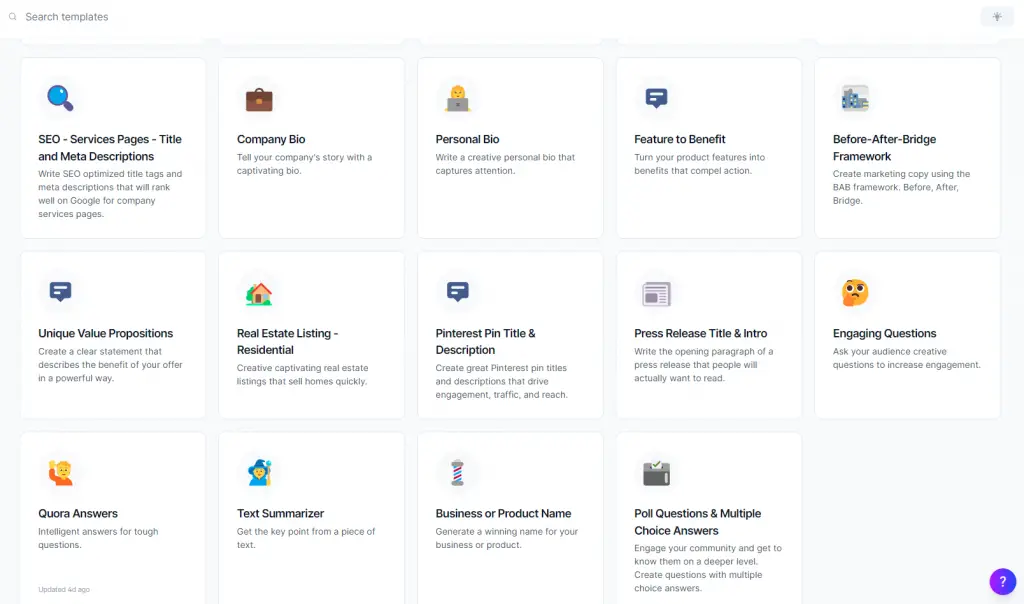
Jasper is a clever AI that can help you with different parts of your writing. Jasper can identify the core argument in your writing and will provide an outline, create a title, and offer to write introductions and conclusions.
This tool is relatively new. And, I have become a heavy user. I can see how this tool will be VERY useful for knowledge work like professors and researchers. It takes a bit of a learning curve to master the tool. But, it’s absolutely worth it.
We recently negotiated a deal for our readers to get 10,000 words for free. You can grab it here.
But, let me say this first: this tool is great if you know when and how to use it (like most tools really…). And, no, this AI won’t replace you, yet… Your role as the researcher is to guide the AI. Be clear about the central thesis, arguments, and guide it through the process.
Here is the deep dive review article on Jasper .
- The writing document comes with the basic editing functions e.g.., Grammar, Rephrase, and Explain-it-to-5th-grade
- Great tool for writing a cover letter or email to editors that show a bit of your personality (e.g., using its tone of voice function
- Help you promote your work on social media with the “Quora Answers” template
- Help you do polls and surveys with the “Poll Questions & Multiple Choice Answers” template
- Help you write an opening paragraph of a press release that people will want to read “Press Release Title” Template
- Flexible pay-as-you-go. To start with, Jarvis gives you some credits (5,000 in my case) for free. So, test Jarvis and pay for what you use
- This tool is not ready yet to stand on its own. As I said, you will need to guide it through the process, so you will have to be more involved than with some other tools.
- It does take a bit of learning like using a typewriter when most people are still using pen and paper. (Eventually, most people use a keyword to type. And, I believe it’s only a matter of time until most people realize they can do more and better with AI…)
- Unused credits are not allowed to carry over to the next month. I wish it’s more like the Audible model, where you can save up the credit later on.
- The paraphrasing function only works for a short paragraph (<30 words) and often misses quite a lot of points once word count exceeds that
Update: Jasper is giving a one-off 10,000 words for free for five days to our readers. Check it out before it expires.
#2. ProWritingAid – Your paper enhancer before submission
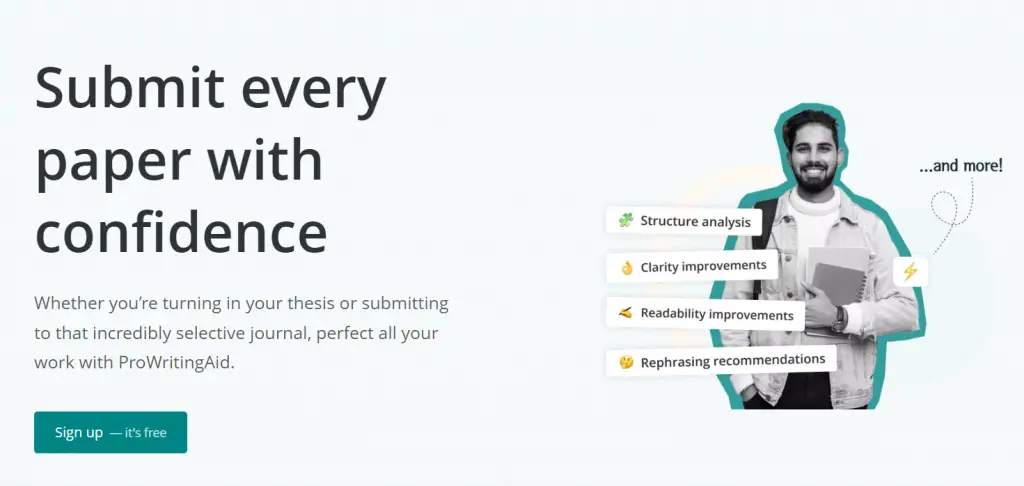
As someone who works in academia, I understand the importance of producing quality writing that is clear, concise, and accurate. That’s why I love using ProWritingAid, an AI-powered writing tool that helps me perfect my work before submission.
The rephrasing tool allows me to improve any sentence in just a few clicks. The AI-powered grammar checker catches even the trickiest mistakes, ensuring my ideas shine without any easy-to-miss errors.
The learning tool for students provides in-depth analysis to get work publish-ready. ProWritingAid’s analytical language goals and power verb suggestions help me write professionally without sacrificing readability.
I would suggest you test this tool out using its guaranteed refund for 14 days.
One of the things I love is its unique 20 reporting functions from ProWritingAid (see image below), especially the Sticky, Overused, Pronouns, and Alliteration.
Overall, ProWritingAid is a powerful tool that can help you produce quality writing quickly and efficiently.
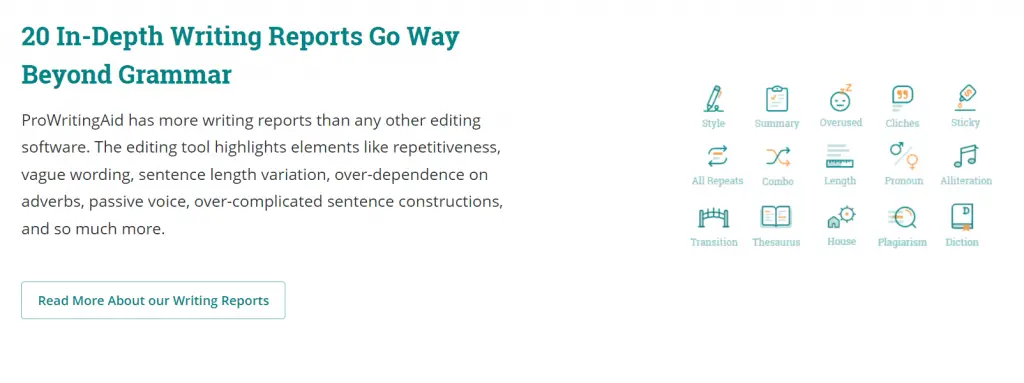
- Comprehensive grammar checker that can catch and fix even the trickiest issues
- Offers a rephrasing tool that allows you to improve any sentence in just a few clicks
- Learning tool for students that provides in-depth analysis to get your work publish-ready
- Analytical language goals and power verb suggestions to help you write clearly, concisely, and accurately
- Can be used by both students and professionals for all types of academic writing
- The free version has limitations, and you need to upgrade to access all features
- While I love the detailed report feature, some users may find these functions overwhelming at first
- Can be time-consuming to use for long documents or research papers as this is not designed with the paper organization in mind
#3. Trinka – Designed for Academic and Technical writing
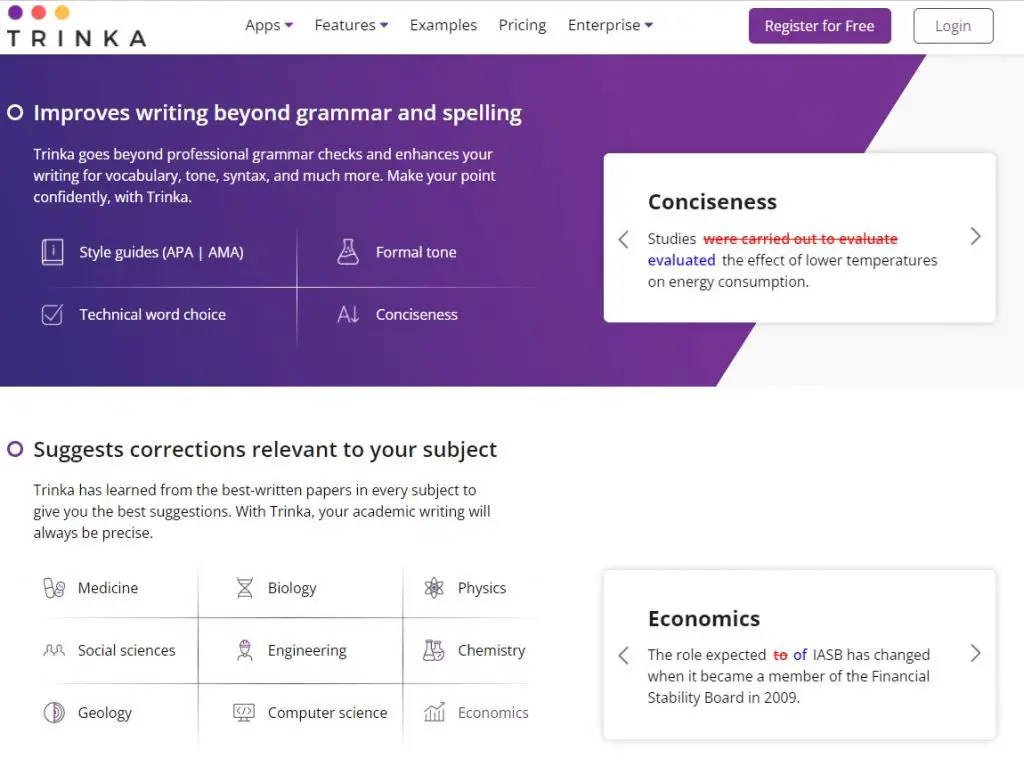
Trinka is an AI-powered English grammar and plagiarism checker, which we have covered in this article . It also doubles as a language enrichment writing assistant.
We have been testing Trinka recently and fell in love with it. Trinka is founded by Enago, an established academic service provider. So, they are well-versed in the needs of academic papers or technical writing.
Using real-time writing recommendations, Trinka corrects contextual spelling problems and sophisticated grammatical issues.
It aids academics and professionals in ensuring that their writing is clear, succinct, and interesting.
Below is a comparison of its performance against Grammarly from a Trinka whitepaper. Trinka wins in Domain, Usage, and Style.
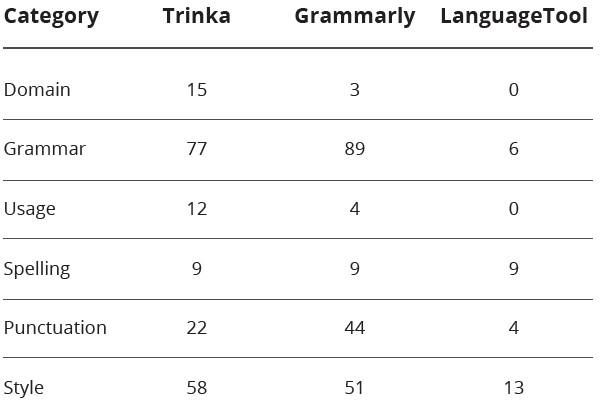
We are also delighted to see its Publication Readiness feature included in the free plan. If you have issues with publishing your paper, chances are something is wrong with your manuscript. This Publication Readiness Checker may just be that difference maker.
- More suited for academic and technical writing
- Consistency Check that’s made for scientific writing
- Publication readiness check is a lifesaver (included in the free plan!)
- Flexible – credit-based pricing. Free-credits every month
- No desktop or mobile app
- Free version limits word count to 10,000 words/month
#4. Hemingway Editor – free and powerful
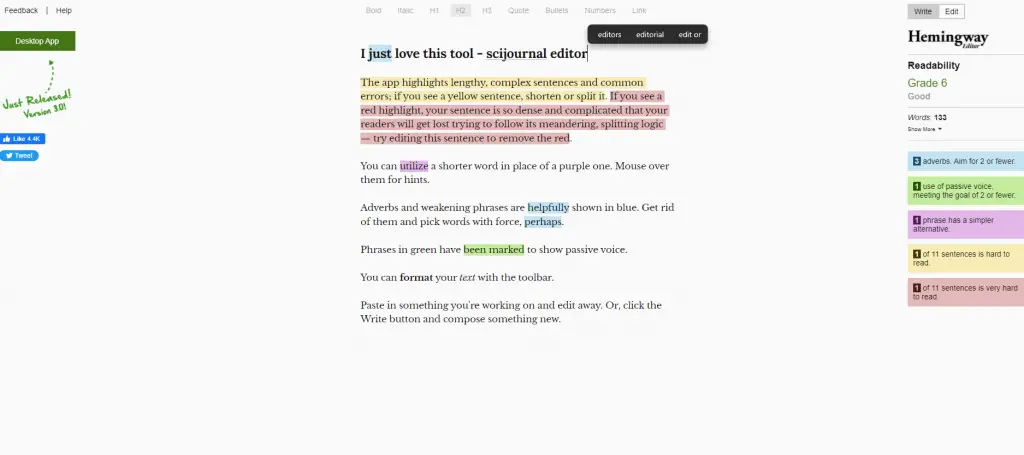
Hemingway Editor is one of my favorite writing tools. It helps you to simplify your writing. And, it’s free and easy to use.
It highlights problems with your writing based on the idea that dense, complex sentences are hard to understand. The program takes these long, winding sentences and breaks them into chunks with periods in between.
This makes it easy to see where you can cut out unnecessary words or phrases. You can also use the Hemingway Editor mobile app, which is available for free on iOS devices!
- Helps you spot your prose’s pitfalls, e.g., passive voice and convoluted sentence structure
- Free tool that also checks grammar
- Software can be downloaded so you can access it without the internet
- Aids in finding alternatives for difficult sentences
- Can make a large difference to the clarity of your writing
- Helps improve reading comprehension and understanding
- Is available as a free mobile app on iOS devices
- Great for essay writing
- Sometimes the alternatives require the reader’s attention
- Can’t export to MS Word or PDF files
- There is no browser plugin for this great tool
- Not ideal for checking really long research or paper
- You need to know what is the right reading level to set it
II. Best Re-Writing Software
#1. quillbot – best paid option for the professional .
QuillBot is a cutting-edge paraphrasing software that may reword part of the text or the entire article. After you’ve entered a sentence or piece of text, hit the paraphrase button, and QuillBot will rephrase your material while preserving its original meaning.
One of the primary strengths of this tool is that it uses machine learning to understand, reword, restructure, and improve on the paraphrases it makes. Besides paraphrasing and cutting your writing time, QuillBot offers a built-in thesaurus function to help you find the perfect word every time and change individual words.
Writing modes are included to help you enhance clarity and meaning, and a Word Flipper helps you change your writing instantly.
The free version can paraphrase up to 700 characters, but you can purchase a premium account and paraphrase up to 10,000 characters. The premium plan also paraphrases text faster, has more writing modes, and shows you a single sentence in multiple modes so you can compare results.
- High-quality results that preserve the original meaning
- Has a slider to adjust the level of synonyms and different writing modes to help you enhance clarity and meaning, as well as style, tone, and grammar tools
- Good interface that shows you the words that have been spun, not just shows you the result
- Works with the writing tools you already use, like Microsoft Office , Google Docs, and Google Chrome.
- Has a co-writer function that can rival Jarvis as a writing tool
- Has a Citation Generator that can be handy with your academic paper
- Has a Grammar Checker that rivals Grammarly with a one-click fix-it function
- The free version allows only 125 words (paraphraser) and 1,200 words summarizer
- The absolute price of $15 per month may scare many people off (until you have experienced the power of an AI writing tool, an editing tool like Grammarly, and a paraphrasing tool like WordTune – coming into one).
- Premium starts with $15 billed monthly and $9.99 per month (billed every 6 months)
#2. WordTune – The most convenient option

WordTune can generate rewrite suggestions by analyzing vast amounts of text and finding human language patterns. As a result, it may occasionally change the meaning to convey a more common idea or to include information it believes is implied.
During the rewrite suggestions, Wordtune is learning to preserve the meaning of your input text as best as possible. It may occasionally, however, offer suggestions that seem to be out of context since the tool is built with some creative freedom. Sometimes, it may misinterpret your text and give incorrect or irrelevant suggestions.
- Best onboarding process that allows you to feel the tool – has a floating W icon that follows
- Works as a Google Extension which I use for my daily needs
- Free version shows impressive rewording results with the highlighted changes
- Most rewarding options I have seen from a tool (vs. others that don’t offer options)
- Offers 40% discount to students and educators with a valid academic email address, or those who work for a non-profit or NGO
- To change the tone to casual or formal requires an upgrade
- To use the shorten and expand function requires an upgrade
- Can’t work on a mobile or tablet function
- The normal price of $10 a month may be too much for casual writers
We tested Wordtune and find the Quillbot to be a more powerful tool with more functions mentioned above. Who knows, Wordtune may change after seeing user feedback like ours one day.
#3. Spinbot – Best free option for starters
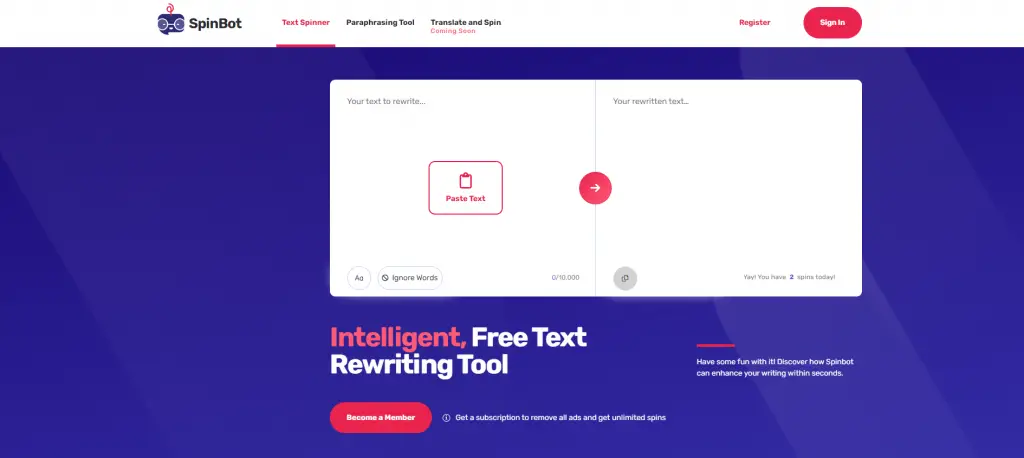
Spinbot is a free summarizing tool that converts the substance you paste or write directly into an editorial manager. When you submit a request, the Spinbot framework modifies the text automatically.
Spinbot does not capitalize words, which protects uppercase terms like titles, professional people, places, and things while also preserving the main phrase of each sentence. You may modify this setting by checking the Spin Capitalized Words box.
- Free version that works up to 10,000 words which is quite amazing compared with QuillBot’s 125 words
- The interface is simple, spotless, and straightforward to use, but it includes offers. When you get past the commercials, though, the summarizing method is simple
- User experience is interrupted by ads sometimes
- The results is not as transparent as the QuillBot which shows you what has been changed
- The result can sometimes be quite bad (makes no sense) and you can’t adjust the rewording level like you can with QuillBot
III. 3 Best Writing Organization Tools
#1. scrivener – best for academic researchers.
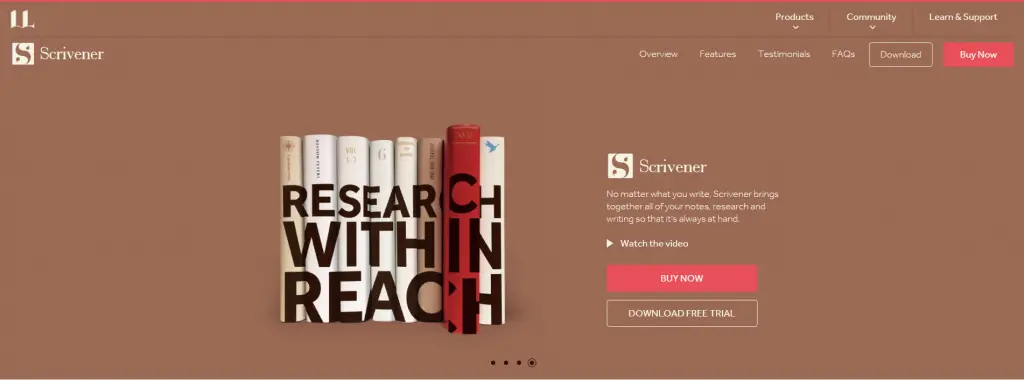
Scrivener is great for researchers who need to handle a large volume of research. Academic writing is more complicated than a grad school writing assignment. This tool costs a little bit of money. But, many top researchers use it for their research papers.
It’s helpful that it has a mobile app, too. If you want to walk around and research ideas or write on your phone, Scrivener can sync with your device so everything is in one place.
Scrivener is very easy to use and helps you organize your writing. You can create chapters that have subpages for all of your research. You can also add images or text boxes that relate to your writing. It’s a great tool for organizing your research and thoughts, so you can produce a better academic research paper.
Scrivener also has a great free trial period – 30 days of use . So, if you use it 3 days a week, then you could have the trial for 10 weeks. Check the Discount here .
- Ease of use – allows you to easily rearrange your chapters and organize your research paper later without worrying about the order
- Many guides along the research process
- Free app trial that most students can access and test
- Able to help you turn random articles and documents into a thesis and great research paper
- Interface in the documents can be a bit confusing for first-time users
Further reading:
- Robin Nemesszeghy has written a great article on Scrivener vs. Dabble.
#2. Authorea – Best for Alternative Publication and Exposure
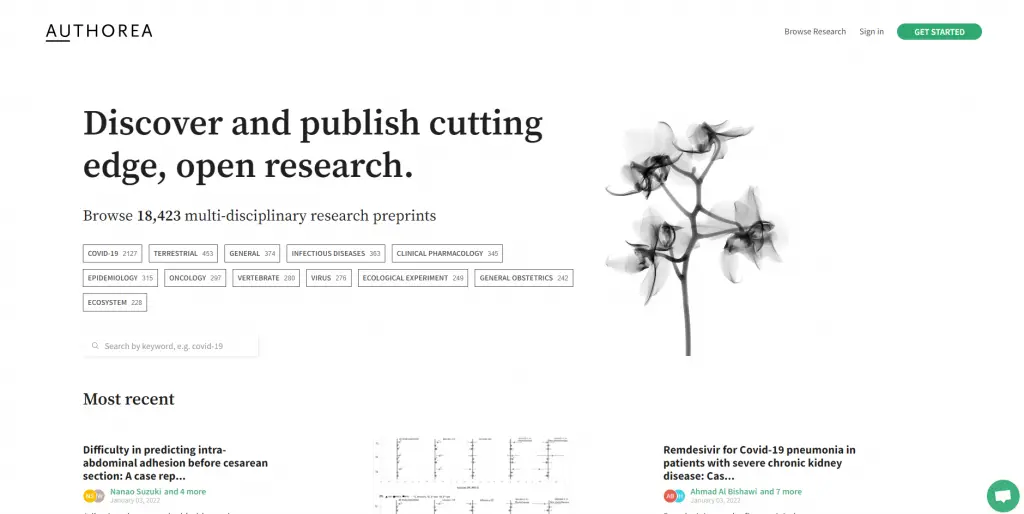
Authorea is this writing tool is a one-stop-shop for you to a) create/upload, b) disseminate your research paper, and c) get published in top journals. Authorea is great for young researchers who want to publish their academic work.
You can also use Authorea with Scrivener!
That’s right, you won’t have to leave your writing tool if you need to upload a research paper or just an article.
One of the best features is that Authorea officials allow you to publish your work on their website, free of charge. You can also get a DOI from them so it’s easier for people to cite your original research paper.
- One-stop shop for creating, disseminating, and getting published in top journals
- Great tool for young researchers who want to do their academic work and publish their research paper without having to handle the document and other admin tasks
- Can use Authorea with Scrivener
- May be difficult to get published in top journals
#3. Reedsy – Best for Aspiring Best-Selling Authors
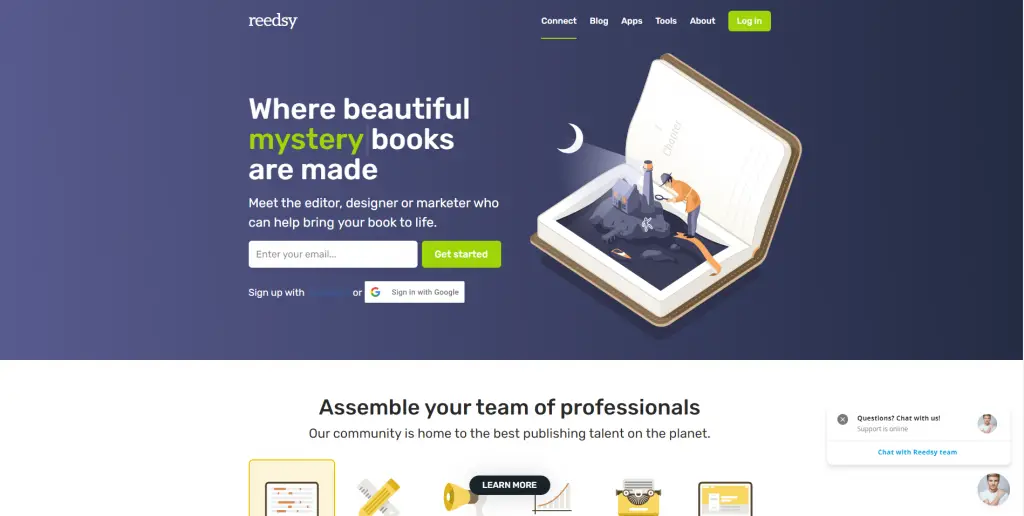
Reedsy is a publishing company that helps authors and publishers connect with professionals to help them create beautiful books. They offer powerful tools and free educational content to help people become top researchers and have more academic success.
Reedsy’s Book Editor is a powerful digital tool used for writing and editing eBooks, print books, journals, and articles. It gives you all the features you need to write your manuscript, including unlimited revision history with comments sent via email; automatic backups; dynamic word count; advanced character filtering; track changes; export to .docx or .txt files; the ability to collaborate on your manuscript with several people at once; and much more.
Reedsy’s eBook Editor has all the features of an advanced word processor, meaning you can write your eBook with the same high-powered tools that are used by best-selling authors.
- Reedsy offers a wide range of professional services to help you create a beautiful book
- They have a lot of free educational content that can help you improve your research and writing skills
- The Reedsy Book Editor is a powerful, yet easy-to-use, tool for writing and editing manuscripts
- Reedsy is quite expensive compared to other publishing companies
- More of a next-level tool for people who have some success or resources
#4. LaTeX – Great tool but difficult for non-coder

LaTeX is one of the most widely used academic writing tools that are free and reliable. We have even created a LaTex tutorial, where we help with the minimal programming knowledge that you need to use this too.
Use LaTex if you haven’t started writing your research paper, have some time to learn it, and want to learn one of the absolute classic writing tools.
Download the LaTeX program here , and don’t forget to check out our guide on how to use it here .
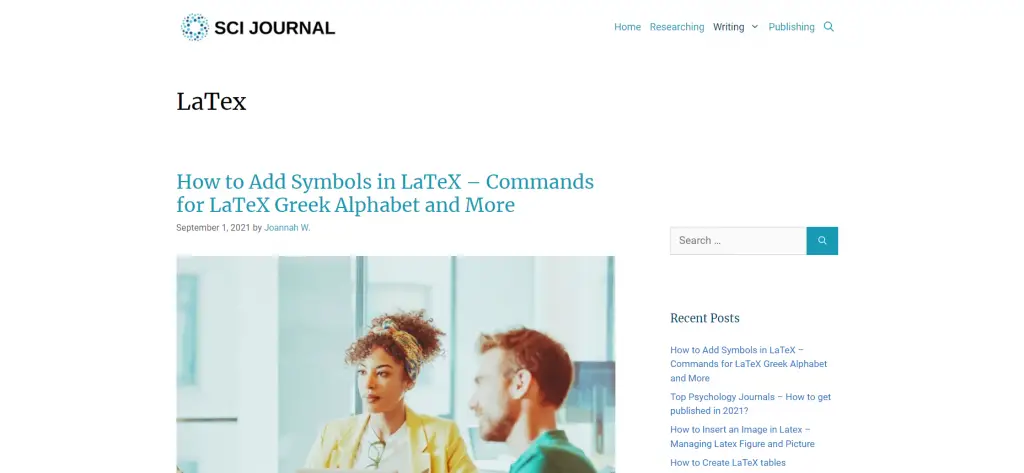
- LaTeX is free to use, which helps students on tight academic budgets.
- The ability to create your own bibliography using Latex’s site function saves time for you and your librarian.
- Creates a technical barrier for researchers who know how to use LaTex and those who don’t
- It takes some time to learn how to use Latex and can take a few hours or even months for beginner writers
- Certain word processing programs such as MS Word cannot be used with LaTex
#5. DraftIn – Minimalistic and free for laser-focus writing
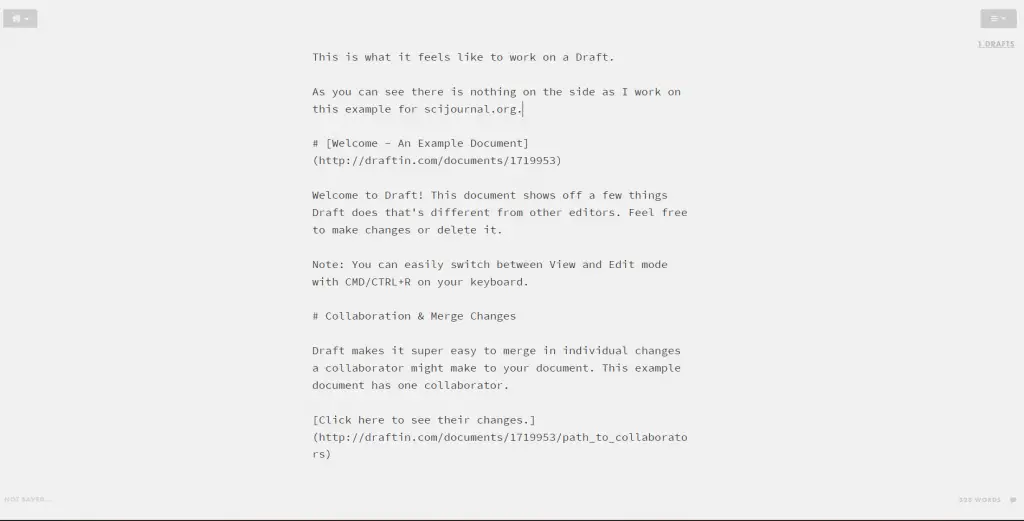
If Steve Jobs creates an academic writing tool, Draftin might be it. The tool is designed for people who just want to focus on words. It embraces Hemmingway’s motto of “Writer drunk. Edit Sober.”
I work with other people all the time, using Google Docs. But, sometimes there are issues with version control. This tool solves that problem by holding the version updated by the user in the user’s environment. So, you should review it first before accepting it.
This is different from Google Docs’ showing the updated version and you figure out what has been changed. And, revert them one by one.
The downside of being minimalist is that you can’t embed links in the text.
- One of the good free online writing tools
- Minimalist design with the Hemingway Mode that encourages “write first, edit later”
- Version control is very helpful for keeping track of edits and updates
- Great when you have co-authors to work on the same documents
- Help you focus on the quality of your writing and notes
- You can’t embed links in text in the document
- Limited functions (by design) compared with other tools
Final Thoughts
The best academic writing tools don’t have to be expensive or complicated.
The most important thing you can do is use your time wisely.
We are also curious about your experience with what works and what doesn’t.
What are the top three things you wish someone had told you about academic writing when you were starting out?
Share them with us below!
Why should I use LaTeX?
One important but less obvious benefit is that LaTeX allows you to clearly distinguish the substance of your academic papers from the format. As a writer (scientist, researcher or not), this frees you up to concentrate on “what” rather than “how” will it look when printed out on paper (that is the job of LaTeX document class designers).
One big caveat is that the learning curve is quite steep. So, be sure to check out our tutorial here .
What are the best tips for academic writing?
- 1. Make sure to spell-check and proofread
- 2. It’s not enough to merely quote your references
- 3. Try using different words than the ones you found in your research
- 4. You have to accurately summarize and synthesize their ideas in a new way
- 5. Write clearly and simply
- 6. Avoid cliches
- 7. Vary your SENTENCE STRUCTURE
- 8. Mix it up in terms of PUNCTUATION
- 9. Be CONCISE
- 10. Use the VOCABULARY that you know
- 11. But also work on expanding your VOCABULARY
- 12. ***Be open mind and learn to use the tool that you need, not what others recommend
What are the tools for effective writing?
The most important tool is your mind as a researcher.
Good academic writing relies on clear thinking, orderly presentation, and sustained focus.
To be an effective researcher, it’s important to have a set of clearly defined priorities for how you will spend your time in the library or office, what questions you’re devoting attention to, which ideas are worth pursuing in more depth.
Brainstorming is often part of drafting a paper in rhetoric, but in these earliest stages, it is also about figuring out one’s attitude toward the subject at hand. Who am I writing this essay for? Who am I disagreeing with? What are they saying about my topic that I need to refute – all this has implications when deciding where to look next or what hypothesis to pursue.
One major problem for researchers is to actually “see” how much they know. Scapple can be a great tool for organizing knowledge and connecting the dots. You can find out more about how we reviewed >30 mind mapping software here .
There is more.
Check out our other articles on the Best Academic Tools Series for Research below.
- Learn how to get more done with these Academic Writing Tools
- Learn how to proofread your work with these Proofreading Tools
- Learn how to broaden your research landscape with these Academic Search Engines
- Learn how to manage multiple research projects with these Project Management Tools
- Learn how to run effective survey research with these Survey Tools for Research
- Learn how get more insights from important conversations and interviews with Transcription Tools
- Learn how to manage the ever-growing list of references with these Reference Management Software
- Learn how to double your productivity with literature reviews with these AI-Based Summary Generators
- Learn how to build and develop your audience with these Academic Social Network Sites
- Learn how to make sure your content is original and trustworthy with these Plagiarism Checkers
- Learn how to talk about your work effectively with these Science Communication Tools
10 thoughts on “11 Best Academic Writing Tools For Researchers”
Does quiltbot,save the changed text on its server, and then creata the problem of plagerisim.
Here is what it says about its plagiarism checker: “QuillBot stores your content in order to run the plagiarism report, so you can access your reports in the future. Our third-party vendor, CopyLeaks, does not store your content. QuillBot will never share your content with any third parties outside of CopyLeaks.”
Please provide information on resources for systematic review and meta-analysis; for conducting literature review
No it does not
i am a research scholar.i request you to kindly let me share information on rewrite cum plagiarism check, removal tool for best performance. Thank you all
Thank you, Dear Writer. It’s very much helpful.
These are very important for research students. Thank you very much for this piece of information. Great work Joannah.
Thank you for the kind words!
Thanks for sharing this well-researched article.
Nice article, might I suggest Writefull also, they have a number of tools designed for academic/technical writing…
Leave a Comment Cancel reply
Save my name, email, and website in this browser for the next time I comment.
We maintain and update science journals and scientific metrics. Scientific metrics data are aggregated from publicly available sources. Please note that we do NOT publish research papers on this platform. We do NOT accept any manuscript.
2012-2024 © scijournal.org
Top 21 must-have digital tools for researchers
Last updated
12 May 2023
Reviewed by
Jean Kaluza
Research drives many decisions across various industries, including:
Uncovering customer motivations and behaviors to design better products
Assessing whether a market exists for your product or service
Running clinical studies to develop a medical breakthrough
Conducting effective and shareable research can be a painstaking process. Manual processes are sluggish and archaic, and they can also be inaccurate. That’s where advanced online tools can help.
The right tools can enable businesses to lean into research for better forecasting, planning, and more reliable decisions.
- Why do researchers need research tools?
Research is challenging and time-consuming. Analyzing data , running focus groups , reading research papers , and looking for useful insights take plenty of heavy lifting.
These days, researchers can’t just rely on manual processes. Instead, they’re using advanced tools that:
Speed up the research process
Enable new ways of reaching customers
Improve organization and accuracy
Allow better monitoring throughout the process
Enhance collaboration across key stakeholders
- The most important digital tools for researchers
Some tools can help at every stage, making researching simpler and faster.
They ensure accurate and efficient information collection, management, referencing, and analysis.
Some of the most important digital tools for researchers include:
Research management tools
Research management can be a complex and challenging process. Some tools address the various challenges that arise when referencing and managing papers.
.css-10ptwjf{-webkit-align-items:center;-webkit-box-align:center;-ms-flex-align:center;align-items:center;background:transparent;border:0;color:inherit;cursor:pointer;-webkit-flex-shrink:0;-ms-flex-negative:0;flex-shrink:0;-webkit-text-decoration:underline;text-decoration:underline;}.css-10ptwjf:disabled{opacity:0.6;pointer-events:none;} Zotero
Coined as a personal research assistant, Zotero is a tool that brings efficiency to the research process. Zotero helps researchers collect, organize, annotate, and share research easily.
Zotero integrates with internet browsers, so researchers can easily save an article, publication, or research study on the platform for later.
The tool also has an advanced organizing system to allow users to label, tag, and categorize information for faster insights and a seamless analysis process.
Messy paper stacks––digital or physical––are a thing of the past with Paperpile. This reference management tool integrates with Google Docs, saving users time with citations and paper management.
Referencing, researching, and gaining insights is much cleaner and more productive, as all papers are in the same place. Plus, it’s easier to find a paper when you need it.
Acting as a single source of truth (SSOT), Dovetail houses research from the entire organization in a simple-to-use place. Researchers can use the all-in-one platform to collate and store data from interviews , forms, surveys , focus groups, and more.
Dovetail helps users quickly categorize and analyze data to uncover truly actionable insights . This helps organizations bring customer insights into every decision for better forecasting, planning, and decision-making.
Dovetail integrates with other helpful tools like Slack, Atlassian, Notion, and Zapier for a truly efficient workflow.
Putting together papers and referencing sources can be a huge time consumer. EndNote claims that researchers waste 200,000 hours per year formatting citations.
To address the issue, the tool formats citations automatically––simultaneously creating a bibliography while the user writes.
EndNote is also a cloud-based system that allows remote working, multiple-user interaction and collaboration, and seamless working on different devices.
Information survey tools
Surveys are a common way to gain data from customers. These tools can make the process simpler and more cost-effective.
With ready-made survey templates––to collect NPS data, customer effort scores , five-star surveys, and more––getting going with Delighted is straightforward.
Delighted helps teams collect and analyze survey feedback without needing any technical knowledge. The templates are customizable, so you can align the content with your brand. That way, the survey feels like it’s coming from your company, not a third party.
SurveyMonkey
With millions of customers worldwide, SurveyMonkey is another leader in online surveys. SurveyMonkey offers hundreds of templates that researchers can use to set up and deploy surveys quickly.
Whether your survey is about team performance, hotel feedback, post-event feedback, or an employee exit, SurveyMonkey has a ready-to-use template.
Typeform offers free templates you can quickly embed, which comes with a point of difference: It designs forms and surveys with people in mind, focusing on customer enjoyment.
Typeform employs the ‘one question at a time’ method to keep engagement rates and completions high. It focuses on surveys that feel more like conversations than a list of questions.
Web data analysis tools
Collecting data can take time––especially technical information. Some tools make that process simpler.
For those conducting clinical research, data collection can be incredibly time-consuming. Teamscope provides an online platform to collect and manage data simply and easily.
Researchers and medical professionals often collect clinical data through paper forms or digital means. Those are too easy to lose, tricky to manage, and challenging to collaborate on.
With Teamscope, you can easily collect, store, and electronically analyze data like patient-reported outcomes and surveys.
Heap is a digital insights platform providing context on the entire customer journey . This helps businesses improve customer feedback , conversion rates, and loyalty.
Through Heap, you can seamlessly view and analyze the customer journey across all platforms and touchpoints, whether through the app or website.
Another analytics tool, Smartlook, combines quantitative and qualitative analytics into one platform. This helps organizations understand user behavior and make crucial improvements.
Smartlook is useful for analyzing web pages, purchasing flows, and optimizing conversion rates.
Project management tools
Managing multiple research projects across many teams can be complex and challenging. Project management tools can ease the burden on researchers.
Visual productivity tool Trello helps research teams manage their projects more efficiently. Trello makes product tracking easier with:
A range of workflow options
Unique project board layouts
Advanced descriptions
Integrations
Trello also works as an SSOT to stay on top of projects and collaborate effectively as a team.
To connect research, workflows, and teams, Airtable provides a clean interactive interface.
With Airtable, it’s simple to place research projects in a list view, workstream, or road map to synthesize information and quickly collaborate. The Sync feature makes it easy to link all your research data to one place for faster action.
For product teams, Asana gathers development, copywriting, design, research teams, and product managers in one space.
As a task management platform, Asana offers all the expected features and more, including time-tracking and Jira integration. The platform offers reporting alongside data collection methods , so it’s a favorite for product teams in the tech space.
Grammar checker tools
Grammar tools ensure your research projects are professional and proofed.
No one’s perfect, especially when it comes to spelling, punctuation, and grammar. That’s where Grammarly can help.
Grammarly’s AI-powered platform reviews your content and corrects any mistakes. Through helpful integrations with other platforms––such as Gmail, Google Docs, Twitter, and LinkedIn––it’s simple to spellcheck as you go.
Another helpful grammar tool is Trinka AI. Trinka is specifically for technical and academic styles of writing. It doesn’t just correct mistakes in spelling, punctuation, and grammar; it also offers explanations and additional information when errors show.
Researchers can also use Trinka to enhance their writing and:
Align it with technical and academic styles
Improve areas like syntax and word choice
Discover relevant suggestions based on the content topic
Plagiarism checker tools
Avoiding plagiarism is crucial for the integrity of research. Using checker tools can ensure your work is original.
Plagiarism checker Quetext uses DeepSearch™ technology to quickly sort through online content to search for signs of plagiarism.
With color coding, annotations, and an overall score, it’s easy to identify conflict areas and fix them accordingly.
Duplichecker
Another helpful plagiarism tool is Duplichecker, which scans pieces of content for issues. The service is free for content up to 1000 words, with paid options available after that.
If plagiarism occurs, a percentage identifies how much is duplicate content. However, the interface is relatively basic, offering little additional information.
Journal finder tools
Finding the right journals for your project can be challenging––especially with the plethora of inaccurate or predatory content online. Journal finder tools can solve this issue.
Enago Journal Finder
The Enago Open Access Journal Finder sorts through online journals to verify their legitimacy. Through Engao, you can discover pre-vetted, high-quality journals through a validated journal index.
Enago’s search tool also helps users find relevant journals for their subject matter, speeding up the research process.
JournalFinder
JournalFinder is another journal tool that’s popular with academics and researchers. It makes the process of discovering relevant journals fast by leaning into a machine-learning algorithm.
This is useful for discovering key information and finding the right journals to publish and share your work in.
Social networking for researchers
Collaboration between researchers can improve the accuracy and sharing of information. Promoting research findings can also be essential for public health, safety, and more.
While typical social networks exist, some are specifically designed for academics.
ResearchGate
Networking platform ResearchGate encourages researchers to connect, collaborate, and share within the scientific community. With 20 million researchers on the platform, it's a popular choice.
ResearchGate is founded on an intention to advance research. The platform provides topic pages for easy connection within a field of expertise and access to millions of publications to help users stay up to date.
Academia is another commonly used platform that connects 220 million academics and researchers within their specialties.
The platform aims to accelerate research with discovery tools and grow a researcher’s audience to promote their ideas.
On Academia, users can access 47 million PDFs for free. They cover topics from mechanical engineering to applied economics and child psychology.
- Expedited research with the power of tools
For researchers, finding data and information can be time-consuming and complex to manage. That’s where the power of tools comes in.
Manual processes are slow, outdated, and have a larger potential for inaccuracies.
Leaning into tools can help researchers speed up their processes, conduct efficient research, boost their accuracy, and share their work effectively.
With tools available for project and data management, web data collection, and journal finding, researchers have plenty of assistance at their disposal.
When it comes to connecting with customers, advanced tools boost customer connection while continually bringing their needs and wants into products and services.
What are primary research tools?
Primary research is data and information that you collect firsthand through surveys, customer interviews, or focus groups.
Secondary research is data and information from other sources, such as journals, research bodies, or online content.
Primary researcher tools use methods like surveys and customer interviews. You can use these tools to collect, store, or manage information effectively and uncover more accurate insights.
What is the difference between tools and methods in research?
Research methods relate to how researchers gather information and data.
For example, surveys, focus groups, customer interviews, and A/B testing are research methods that gather information.
On the other hand, tools assist areas of research. Researchers may use tools to more efficiently gather data, store data securely, or uncover insights.
Tools can improve research methods, ensuring efficiency and accuracy while reducing complexity.
Should you be using a customer insights hub?
Do you want to discover previous research faster?
Do you share your research findings with others?
Do you analyze research data?
Start for free today, add your research, and get to key insights faster
Editor’s picks
Last updated: 11 January 2024
Last updated: 15 January 2024
Last updated: 17 January 2024
Last updated: 12 May 2023
Last updated: 30 April 2024
Last updated: 18 May 2023
Last updated: 25 November 2023
Last updated: 13 May 2024
Latest articles
Related topics, .css-je19u9{-webkit-align-items:flex-end;-webkit-box-align:flex-end;-ms-flex-align:flex-end;align-items:flex-end;display:-webkit-box;display:-webkit-flex;display:-ms-flexbox;display:flex;-webkit-flex-direction:row;-ms-flex-direction:row;flex-direction:row;-webkit-box-flex-wrap:wrap;-webkit-flex-wrap:wrap;-ms-flex-wrap:wrap;flex-wrap:wrap;-webkit-box-pack:center;-ms-flex-pack:center;-webkit-justify-content:center;justify-content:center;row-gap:0;text-align:center;max-width:671px;}@media (max-width: 1079px){.css-je19u9{max-width:400px;}.css-je19u9>span{white-space:pre;}}@media (max-width: 799px){.css-je19u9{max-width:400px;}.css-je19u9>span{white-space:pre;}} decide what to .css-1kiodld{max-height:56px;display:-webkit-box;display:-webkit-flex;display:-ms-flexbox;display:flex;-webkit-align-items:center;-webkit-box-align:center;-ms-flex-align:center;align-items:center;}@media (max-width: 1079px){.css-1kiodld{display:none;}} build next, decide what to build next.

Users report unexpectedly high data usage, especially during streaming sessions.

Users find it hard to navigate from the home page to relevant playlists in the app.

It would be great to have a sleep timer feature, especially for bedtime listening.

I need better filters to find the songs or artists I’m looking for.
Log in or sign up
Get started for free

19 Academic Writing Tools (that are completely free!)

A selection of tools for academic writing – from collaborating, time-tracking and project management to finding the perfect phrase or translation. We are continuously updating this list (latest update: April 2023).
I often get asked about my favourite academic writing tools. That’s why I compiled this scientific tools list for you with 19 great tools to support your academic writing. You can use all these scientific research tools for free and some of them have paid versions with additional features.
Just one word of caution: Exploring new academic writing tools can be a time-suck and distract you from getting your actual writing done. If you are one of those people who spend hours signing up for new software for academic writing and getting it set up, only to abandon the tool a few days or weeks later – then be careful reading this scientific tools list, and don’t get overenthusiastic. 😉
By the way, I don’t have any affiliation with any of the academic writing tools listed below, and none of these are affiliated links.
Here, we go, 19 tools for academic writing and scientific research I recommend in no particular order:
ACADEMIC Writing tools
1. writefull.
This proof-reading tool for scientific texts is powered by AI and big data. You can integrate the Writefull app into Word or Overleaf for free. A reader of the blog brought my attention to this tool (thank you so much!) and I’ve only recently started using it, so I can’t give you a full-blown review just yet but so far the results are promising. Writefull is owned by Digital Science, a company that has released several Open Science apps, such as figshare, Overleaf and Altmetric.
2. Phrasebank
Created by Dr John Morley from “The University Language Center” of Manchester University, the Phrasebank is a database of common phrases used in papers, dissertations and grant proposals – a real goldmine!
The phrases are organised both by the common sections in a paper such as the Introduction, Methods, Results or Discussion section. For example, in the tab for the Introduction section, one can find entries for “establishing the importance of the topic for the world or society” or “identifying a knowledge gap in the field of study”. If you click on the latter, you can find among others the following suggested phrases: “It is still unclear whether…”, “However, the behaviour of X has not yet been investigated” and “Causal factors leading to X remain speculative”.
You can also look for phrases by choosing a general language function. Some of the choices are “being cautious”, “describing trends”, “signalling transition”.
The Phrasebank is very useful to get inspiration for new wording but I do not endorse all entries. Sometimes you find language that is a bit clunky or overly complicated so do use your own judgement when you browse this academic writing tool. PS: You can also download the Academic Phrasebank as PDF or Kindle file.
3. Thesaurus.com
If you’re looking for synonyms, thesaurus.com is the best online thesaurus I’ve found so far. It divides the synonyms based on different meanings of the word and indicates the relevance of the synonym by using three shades of orange.
Just one word of caution: Don’t fall into the trap of using too many synonyms in your academic writing. Being precise is so much more important than varying the words you are using in your writing. In particular for field-specific terminology, I advise against using synonyms .
This is a hot tip for researchers who need to transcribe interviews (hello, social scientists!), who like to record research ideas or those who like to write by dictating text into their phone. Otter is an AI-based transcription tool that works for English language recordings. The quality of the transcriptions is comparable to other transcription services using AI, meaning they are often not accurate and can give nonsensical, even comical results — especially when the recorded voice has a strong or unusual accent. Still, the automated and quick transcriptions (real time transcriptions are available too!) can be a good starting point and are a huge time saver. What’s cool about Otter compared to its competitors is that they give you 300 minutes of transcriptions per month for free!
There are many online dictionaries but Linguee is my favourite for academic writing. It suggests a translation on the basis of previous translations published on the internet. Therefore, this dictionary is especially great if you’re looking to not only translate a word but a certain turn of phrase or idiom. Linguee translates to and from English in over 20 languages. An essential academic writing tool for all non-native English speakers!
ACADEMIC WRITING TOOLS FOR Collaboration AND CO-WRITING
6. authorea.
The magazine “ TechCrunch ” describes Authorea as “a Google Docs for scientists”. On the academic writing platform, you can write, edit, and insert citations, figures and data. And it’s great for collaborative writing: Co-authors can access the same text at the same time, track the changes they made, insert comments and even live-chat during writing sessions. Documents can be imported from LaTeX and Word and exported as LaTeX, Word and PDF documents. You can also submit your article as a bioRxiv preprint straight from the Authorea platform. This software for academic writing is free for up to ten documents with limited sharing options.
7. Overleaf
Overleaf is to LaTeX users, what Authorea (see tool #6) is to Word users: an online editor that allows you to access and collaborate on your writing projects from anywhere. You can, for example, invite others to comment on your work. Overleaf offers some other neat collaborative writing features, such as a track-changes function, but – unfortunately – only on the paid plan. LaTeX may seem a bit intimidating at first but you actually get the hang of it quite fast (and feel like a coder 😎). Also, in my experience, you save a lot of time formatting your text (and feel smug about it when you talk to Word users 😁).
Slack is a chat tool that you can use in your lab or with your collaborators. Used in the right way, it allows you to save time by cutting down on emails and create a group atmosphere even if the members are not working in the same location. You can easily add files to the chats and create different channels for subgroups or certain topics. There also exist virtual communities on Slack you can join, such as the New PI Slack community for Assistant professors around the world.
Loom is a great scientific research tool when you want to share a quick video with a colleague, student or collaborator. This could be a recorded presentation or lecture, your comments on the paper of a co-author, or a tutorial on using a piece of software. You can record your screen, camera and microphone. The neat thing is that after you’re done recording, Loom auto-generates a link you can share.
Academic writing tools for Productivity and project management
Toggl is a time-tracking app that you can install on your phone and computer. There’s only one way of knowing how long certain writing tasks typically take you, and that is by tracking the time they took you to complete . Time-tracking has another great advantage: You can identify time-sucks in your day. And these may be less obvious than you think.
I like to use Toggl for time-tracking because it’s quick to use and integrates with various other scientific research tools I am using. You just need to click the big red power button to start or stop a recording and assign tracked times to different projects. This scientific research tool has paid plans but for most people the free basic plan will be sufficient.
Are you easily tempted to check your phone when you really should be writing? This app called Forest may be just right for you then. Once installed on your phone, you can start planting a virtual tree whenever you want to focus. It grows from a little plant to a full-grown tree. When you pick up your phone and leave the app, the tree dies. This way, you can build your forest representing the time you have spent on focused work (or quality time with your family and friends…). I’m not using Forest myself, but I’ve heard that it works really as an academic writing tool well for some people. Give it a go!
12. Focusmate
As Forest (see tool #11), Focusmate is an app to help you stay focused. Instead of gamification, the concept of Focusmate is based on social accountability. Here is how it works: You schedule a 50-minute virtual co-writing session with another Focusmate member, turn on your webcam when your session starts, greet your temporary co-worker and then get to work silently.
Even though being filmed while working is a little strange in the beginning, co-writing sessions work really well for a lot of researchers. This is why we offer co-writing sessions as part of our academic writing program, the Researchers’ Writing Academy, as well.
13. Cold Turkey
If Forest (tool #11) or Focusmate (#12) don’t get you to focus on your writing, you may need to go Cold Turkey . This software for academic writing blocks any other application and turns your computer into a typewriter. You can choose whether you want Cold Turkey to prevent you from digital distractions for a certain amount of time or until you’ve hit a certain word count. With the paid version, you can even access integrated productivity soundtracks and text formatting.

Not an app exactly, but free as well: Click the orange button below to have me walk you through my step-by-step system to write clear & concise papers for your target journals in a timely manner . This free academic writing training is perfect for you if you’re reading this blog post because you are procrastinating on writing your paper.
Trello is an excellent project management tool for your academic writing, which you can use for managing each of your writing projects, for creating a publication pipeline and as a daily and weekly to-do list. Trello is a great introduction into project management because it’s a lot easier to learn and use than most other project management software. For each project called a “Board”, you can create different “lists”, which are vertical collection of “cards”, which you can move between lists. You can add due dates, checklist lists, links, files and text to each card. To work collaboratively, you can leave comments on cards and assign them to members on your team. You can also use Trello as a brainstorming tool, using the cards just as you would use post-it notes.
Members of my online course, the Researchers’ Writing Academy , get access to Trello templates I created to easily manage their publication pipeline, the writing process for each of their scientific papers and all of their other daily, weekly and monthly tasks and projects.
15. Todoist
Todoist is an alternative to Trello (see tool #16) or can be used in addition. It’s an online to-do list organiser and project management tool that comes as an app and browser version. You can organise your tasks in projects and schedule them for a certain day. This academic writing tool shows you today’s tasks as well as those for the next seven days. It also tracks your productivity, i.e. how many tasks you have completed.
academic writing Tools for finding and reading the literature
Feedly is a neat RSS feed manager that helps you stay up to date with the scientific literature. Instead of getting email alerts from journals (because who wants to get more emails…) you can view and organise the literature you are interested in by following journals’ RSS feeds. You can not only use this for scientific literature but also subscribe to blogs, for example the one you’re reading right now, by simply putting the URL in the Feedly search: https://annaclemens.com/blog .
Are you a mindmapper? Then you need Xmind , a free mindmapping and brain-storming tool. It’s intuitive, looks good and does exactly what you want a mindmapping tool to do. The free version allows for embedding of hyperlinks, images, attachments, so you can really use it however you like! That’s all I can really say about it as I’m not using mindmapping myself. But I know scientists who swear by it!
18. Audemic
Audio formats have become so popular (I’m a big podcast lover myself!) so it shouldn’t really come as a surprise that there now is an audio tool available for the scientific literature too: Audemic . This tool — completely free to use for individual researchers — creates summaries for you (that go beyond the abstract), lets you skip sections, highlight text and take notes while listening.
There are a few reference managers for your academic writing to choose from, some of which cost money. Zotero is free, open-source and doesn’t lack in functionality. You can easily save references from your browser, organise them in folders and with tags and create bibliographies with the right style. You can also create a citation library with your co-authors or share your library with others.
That’s it: 19 academic writing apps and scientific research tools to support your writing for free! However, the best academic writing software won’t make you more productive if you don’t rely on a streamlined writing process and if you aren’t using your writing sessions effectively. If you want to get your hands on a template to write scientific papers in a systematic fashion, sign up for this 1-hour writing training now. It’s free too!

Share article
© Copyright 2018-2024 by Anna Clemens. All Rights Reserved.
Photography by Alice Dix
The 11 best AI tools for academic writing
By leveraging the power of the right AI tool, you can significantly improve the clarity, efficiency, and overall quality of your academic writing. In this guide, we reviewed and ranked 11 popular AI tools for academic writing , along with our top 3 choices, so that you can pick the best one.
Disclosure: This post contains affiliate links, which means I may earn a small commission if you make a purchase using the links below at no additional cost to you.
What are the best AI tools for academic writing?
- 3. QuillBot
4. Writefull
5. grammarly, 6. wordtune, 7. paperpal, 8. sourcely, 10. writesonic, 11. textcortex, summary and top picks.
With the rise of AI tools, academic writing is undergoing a remarkable transformation. The emergence of new AI-powered tools has revolutionized the way researchers, scholars, and students approach their writing tasks.
However, not all tools are created equal! And with the influx of options, it’s important for academics to discern between the high-quality ones and the mediocre ones that can hinder efficiency rather than enhance it.
High-quality AI tools for academic writing help you:
- correct grammar and spelling mistakes,
- paraphrase,
- incorporate references,
- and much more.
Having to use multiple tools for different purposes can be frustrating. Therefore, comprehensive testing was conducted on AI tools to assess their all-encompassing capabilities.
Furthermore, the optional functions were compared to their respective prices to ensure a fair pricing structure. AI support for academic writing should be affordable and not strain your budget.
Here are Master Academia’s top picks for the best AI tools for academic writing in 2023:
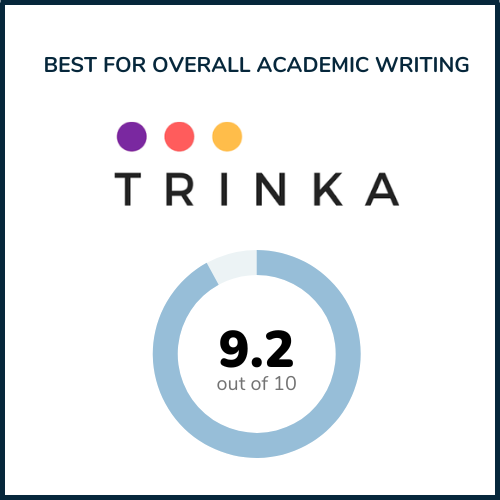
Best Overall for Academic Writing ($6.67/month)
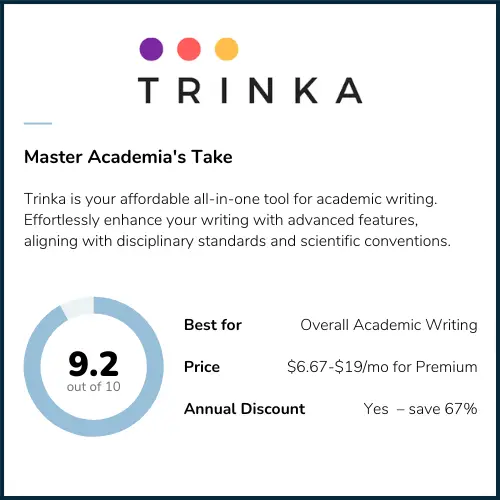
Trinka is a unique AI-powered writing tool designed specifically for academic and technical writing.
What sets Trinka apart is its ability to go beyond basic grammar and spelling corrections. It assists writers in finding the appropriate tone and style for academic writing, while also improving conciseness and implementing formal syntax.
Trinka takes into account the specific research subjects, ensuring that the writing style, word choice, and tone align with disciplinary standards and scientific conventions.
In addition to these advanced writing enhancements, Trinka offers a range of additional features. It includes consistency checking to maintain a coherent writing style, publication readiness checks to prepare your work for submission, plagiarism checking to ensure originality, and a citation analyzer to assess the quality and relevance of your citations.
By providing these comprehensive tools, Trinka offers a convenient and all-encompassing solution for taking your academic writing to the next level.
Key Features:
- Robust grammar and spell-checker – Real-time writing suggestions that also cover tone and style enhancement, syntax, and technical spelling make you a proficient academic writer.
- Disciplinary and scientific conventions – Trinka provides specialized adjustments of language, style, and tone to adhere to scientific conventions in various research fields, based on existing academic publications.
- Powerful plagiarism checker – Through the inclusion of a powerful plagiarism checker powered by iThenticate and Turnitin (renowned software for plagiarism detection), you do not have to worry about accidental plagiarism.
- Wide range of additional features – Trinka offers extra features such as a citation analyzer, journal finder, and publication readiness checker, ensuring your academic writing is prepared for publication efficiently.
- Customization – Trinka has a personal dictionary feature, allowing you to customize the spellchecker to suit your own research work, facilitating a seamless editing process.
- Plug-ins – Plug-ins are available for your favorite browser, and work on Microsoft Word, Google Docs, Gmail, Evernote, Notion, and more.
- For the Trinka Citation Checker and Plagiarism Check, you need to upload your file separately.
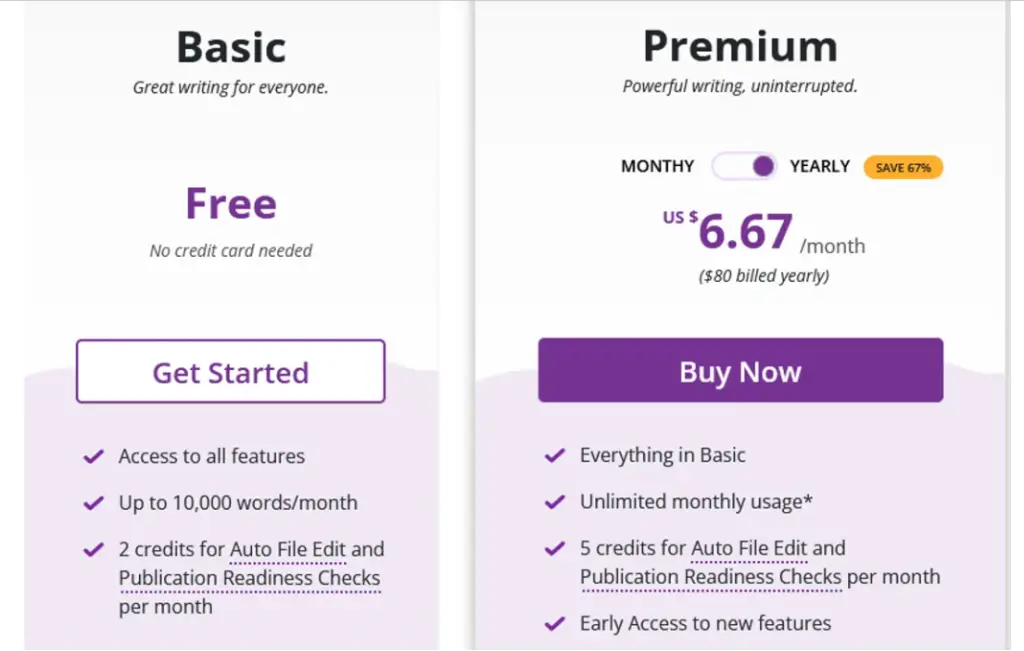
You can use the basic version of Trinka for free, which includes access to all features but with a monthly word limit of 5000 words. The pricing for Trinka’s premium plan starts at $6.67 per month with annual billing, which is extremely affordable.
Best for Summarizing ($15.99/month)
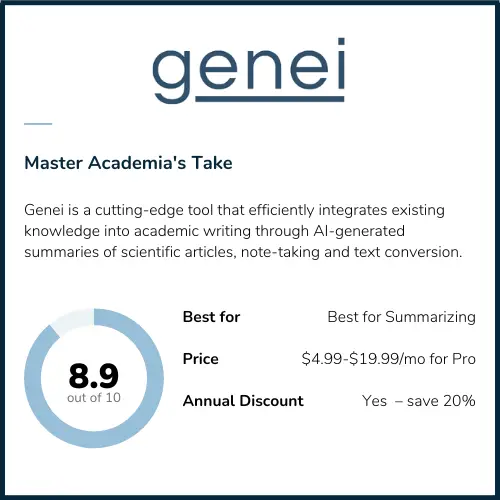
Genei has established itself as a prominent player in the realm of academic AI tools, and rightfully so.
As a comprehensive tool designed for academics, Genei goes beyond assisting with workflow organization and document storage—it also offers a plethora of features tailored specifically for academic writing.
Genei streamlines the academic writing process by utilizing AI-generated summaries and note-taking shortcuts, extracting information from academic articles.
Users can benefit from comprehensive summaries of entire articles or manually highlighted passages, which can be expanded, condensed, rephrased, and summarized with ease using Genei.
Moreover, Genei allows users to seamlessly adapt writing styles and effortlessly incorporate references.
For those heavily reliant on literature reviews in their academic writing, Genei proves to be a gamechanger.
- Research article summaries – Academic writing often necessitates summarizing existing scientific articles, and Genei excels in simplifying this task with its high-quality AI-generated summaries.
- Integrated workflow management – With Genei, you have the ability to save, store, and organize your publications and other documents, providing you with a comprehensive solution to manage your entire workflow within the tool.
- Summarizing notes – When reading and summarizing within Genei, you have the option to utilize the note function, enabling you to highlight specific text passages and gather your thoughts, all of which can be conveniently converted into text format.
- Control and customization over generated summaries: Genei allows you to provide specific instructions to the AI, such as requesting to “expand,” “rephrase,” or “summarize” a particular section.
- Academic discount – As an academic, you can receive a 40% discount on your Genei Pro subscription.
- Genei does not offer the option to customize the style and tone to adhere to specific disciplinary standards.
- To utilize Genei, it is necessary to access its online interface as the tool does not offer any integrations or plug-ins with other platforms.

Genei offers two pricing structures, one for professionals and another for academics.
Professionals:
- The basic version costs £9.99 per month, providing unlimited projects and resources but excluding GPT3 summaries and AI-powered expand, paraphrase & rephrase functions, with a maximum individual file upload of 5GB. The professional pro version, priced at £29.99/month, offers unlimited file upload and full functionality. Annual discounts are available.
- For academics, the basic version costs £4.99, while the pro version costs £19.99, which is essential for accessing the summaries and paraphrasing functions. With the annual discount, the pro version costs £15.99 per month.
3. Quil lBot
Best for Paraphrasing ($8.33/month)
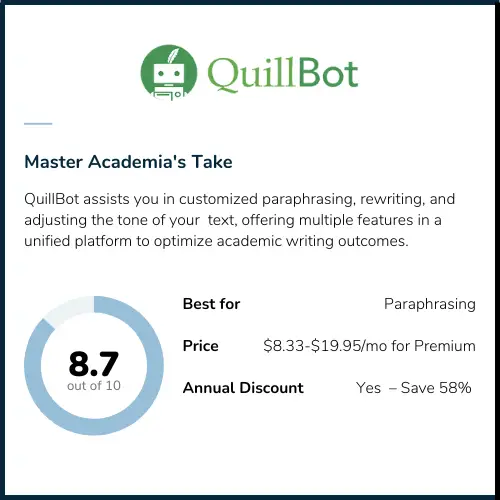
QuillBot is an AI-powered paraphrase tool that helps you to rewrite, edit, and adjust the tone of your text for increased clarity.
With QuillBot ‘s all-in-one Co-Writer, you can access paraphrasing, summarizing, citation creation, and essay writing tools in a single location.
QuillBot’s online paraphraser allows you to modify the meaning of any text using a variety of options. It offers two free modes and five premium modes, allowing you to control the level of vocabulary change.
A synonym slider enables you to adjust the amount of rewriting, in addition to a built-in thesaurus for customizing your paraphrases.
In simple terms, QuillBot’s AI will collaborate with you to generate effective rephrasing. You have a lot of control as you can compare outputs from all seven available modes to choose the most suitable paraphrase.
QuillBot integrates seamlessly with Chrome and Microsoft Word, eliminating the need to switch windows when rephrasing sentences, paragraphs, or articles.
- Paraphrasing options – QuillBot allows you to choose from seven different paraphrasing options (standard, fluency, formal, simple, creative, expand, shorten) to adjust your paraphrasing to your needs.
- Built-in thesaurus – You can customize paraphrases with synonyms using the built-in thesaurus, which is extremely handy.
- Track changes – You can view word count and percent change to feel confident about your revisions when paraphrasing.
- All-in-one – Access all of QuillBot’s tools in one writing space, including paraphrasing, summarizing, access to its citation generator, and its plagiarism checker.
- Translation option – Translate text into 30+ languages.
- Seamless integration – It is easy to incorporate QuillBot into your existing writing tools via Word and Chrome extensions.
- Pause subscription – Academics and students can pause their subscription to align with their academic writing periods.
- QuillBot does not offer the option to customize the style and tone to adhere to specific disciplinary standards.
- QuillBot has no built-in note-taking option.

The free plan of QuillBot allows paraphrasing of up to 125 words and summarizing of up to 1200 words at a time, but excludes advanced features like advanced grammar rewrites, comparing paraphrasing options, and the plagiarism checker.
With the premium plan, you gain access to full functionality, including unlimited word paraphrasing, summarizing up to 6000 words, faster processing, advanced grammar features, tone detection, and more. The premium plan is priced at $19.95 per month or $8.33 per month when paid annually.
QuillBot also offers a 100% money back guarantee for the QuillBot Premium Plan.
Solid Editing and Content Creation Tool ($5.46/month)
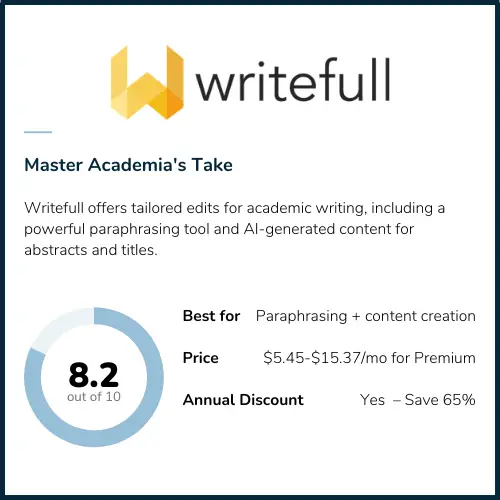
Writefull utilizes language models trained on extensive journal articles to provide tailored edits for academic writing and offers automatic paraphrasing and text generation.
With additional AI widgets like the Abstract Generator, Academizer, Paraphraser, and Title Generator, it provides inspiration and assistance for academic writers.
Writefull is a powerful editing tool designed for individuals who struggle with writer’s block and prefer to revise and edit existing text rather than creating it from scratch.
Writefull is available for Word and Overleaf, allowing users to revise, upload, and download documents with track changes. This can be particularly useful if a document with track changes is required for a journal submission.
- Data security – Writefull provides secure and quick text revisions without storing any user data or search history.
- Track Changes – Users can upload their text for a language check, evaluate overall language quality, and make corrections using Track Changes.
- AI-generated abstracts and titles: Writefull helps you to write abstracts based on your input, and provides suggestions for titles.
- Institutional Premium Accounts – Universities can purchase a license which makes Writefull free to their students and staff.
- GPT detector – Writefull users can utilize a GPT detector feature to determine if a text comes from GPT-3, GPT-4, or ChatGPT models.
- Writefull’s Academizer makes text is supposed to make texts sound more academic, but it does not adjust to different disciplinary standards.
- The seven paraphrasing modes are not all suitable for academic writing.
- While abstracts and titles generated by Writefull ard not be flawless and may require some editing. Nonetheless, they serve as an excellent source of inspiration.

Writefull can be used with limited functionality for free. Its Premium Plan offers unlimited use of all features at a cost of $15.37 per month.
However, there are significant savings if you choose to pay annually, as it amounts to only $5.46 per month.
Tried and Tested Writing Assistant ($12.00/month)
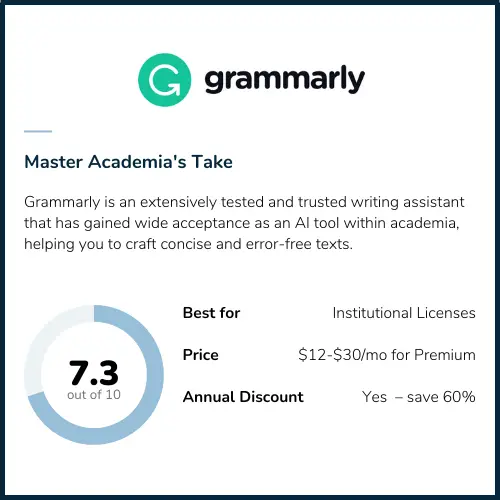
Grammarly is widely recognized as the leading AI-powered writing assistance tool. One of Grammarly’s key advantages is its versatility and convenience.
Grammarly stands out among other AI tools by having a widespread and popular institutional license, which universities readily embrace.
Despite the common reservations university administrators hold against AI usage, Grammarly has established itself as a widely accepted and trusted tool among academics, researchers, and students.
Once installed, it seamlessly integrates into various desktop applications and websites, providing suggestions and assistance as you write across different platforms, including apps, social media, documents, messages, and emails, without requiring separate installations.
Grammarly’s popularity in the academic community can be attributed to its support for citation style formatting and robust plagiarism detection, making it a valuable tool for academic writing.
- Style and tone real-time assistance – Grammarly provides real-time suggestions and guidance on improving the style and tone of your writing.
- Solid free version – The free version of Grammarly is reliable for basic grammar and spelling checks, as well as identifying unclear sentences and auto-citations.
- Additional features: A range of advanced features, plagiarism detection, citation checking, and essay analysis, help you to identify unintentional plagiarism and enhance the overall quality of your writing.
- Special offers for education: Grammarly for Education is available as an institutional license for universities. It ensures high security standards and data protection, which is particularly crucial when dealing with research data. This contributes to Grammarly’s acceptance in academia.
- Grammarly is not directly targeted at academic writing, which means it may not fully cater to the specific needs and conventions of academic writing styles.
- While Grammarly’s premium plan provides suggestions to improve the overall tone of your writing, it lacks subdivision according to research fields or disciplines, which may not meet the specific requirements for unique scientific tone required in academic research writing.

Grammarly’s free plan offers valuable basic writing suggestions to improve your writing.
The premium plan may seem expensive at $30 per month, but with the annual savings of 60%, it becomes much more affordable at $12 per month.
The business account may not be of interest to students or researchers. However, universities can opt for Grammarly for Education, which provides licenses for free premium plans to students and staff.
Efficient Paraphrasing Tool ($9.99/mo)
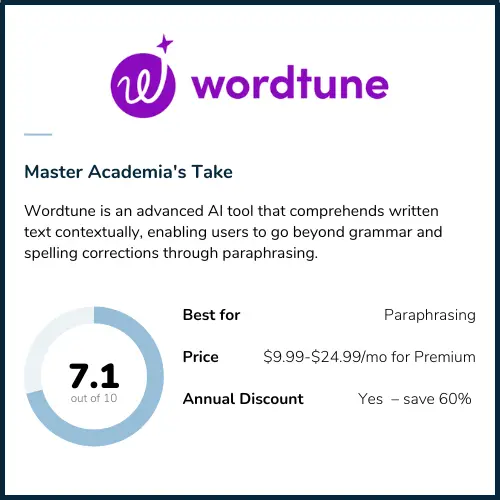
Wordtune utilizes sophisticated AI tools and language models that possess a deep understanding of written text, including its context and semantics.
Wordtune goes beyond mere grammar and spelling corrections, empowering you to express your own ideas effectively in writing.
The tool itself proclaims that it has gained the trust of students and researchers at renowned universities.
Although Wordtune excels in paraphrasing, providing synonym recommendations and an integrated plagiarism check for seamless usage, it is important to note that its focus is not primarily on academic writing, which influences the training of the system.
- Synonyms – Wordtune provides contextual synonym recommendations for your sentences.
- Grammar and spelling correction – With Wordtune you can rest assured that your text is free from grammar and spelling mistakes.
- Plagiarism-free writing – Wordtune helps you avoid plagiarism by rephrasing text while preserving its original meaning with its built-in plagiarism checker.
- Wide range of extensions – Wordtune offers convenient extensions for Chrome, Microsoft Word, iOS, Teams, and more.
- Affordable – Wordtune provides cost-effective AI-powered paraphrasing capabilities.
- Wordtune does not have specific features or styles tailored for academic writing.
- Wordtune primarily focuses on lengthening or shortening text and does not offer extensive tools for academic writing needs.

Wordtune offers a free version with limited features, while the premium version is priced at $24.99 per month. However, users can benefit from a significant 60% discount when opting for an annual subscription: With an annual subscription, the premium version of Wordtune is available at a reduced rate of $9.99 per month.
Academic Language Editor ($8.25 / month)
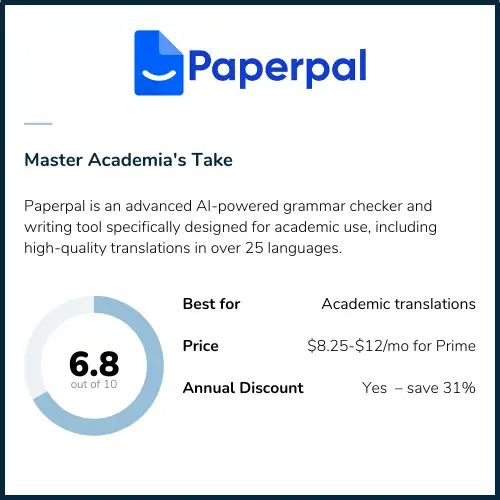
Paperpal, developed by Researcher.life, is a specialized AI tool designed for researchers and academic writers, leveraging the expertise gained from editing numerous manuscripts by professional editors.
With Paperpal , you can effortlessly enhance your writing by addressing grammar errors and improving sentence structure, ensuring your credibility remains intact.
Moreover, Paperpal offers advanced features such as accurate translation and contextual synonyms, along with the choice between Essential and Extensive editing modes, providing flexibility to tailor the editing process to your specific needs.
Available as Paperpal for Word, Web, and Manuscript, this comprehensive tool also checks for structural and technical inconsistencies in your writing.
- Trained with expertise of academic editors – Paperpal is an AI system that has undergone training on academic writing and human-edited manuscripts, guaranteeing high standards.
- Translation – With Paperpal, you can effortlessly translate academic texts from over 25 languages to academic English.
- Compliance with technical language standards – The manuscript checker in Paperpal ensures technical compliance and maintains language quality standards required for journal submissions.
- Consistency feature – Paperpal’s consistency feature checks for and detects stylistic inconsistencies unique to research content, allowing for seamless correction.
- Data security – Your data is secure with Paperpal, as it adheres to a certified data security protocol and is compliant with ISO/IEC 27001:2013 standards.
- Paperpal does not offer a subdivision into research fields or disciplinary standards, meaning it does not cater to specific tones or styles required by different academic disciplines.
- Currently, Paperpal only provides word integration and is limited to integration with Microsoft Word and web browsers.
- Paperpal lacks a built-in plagiarism checker.
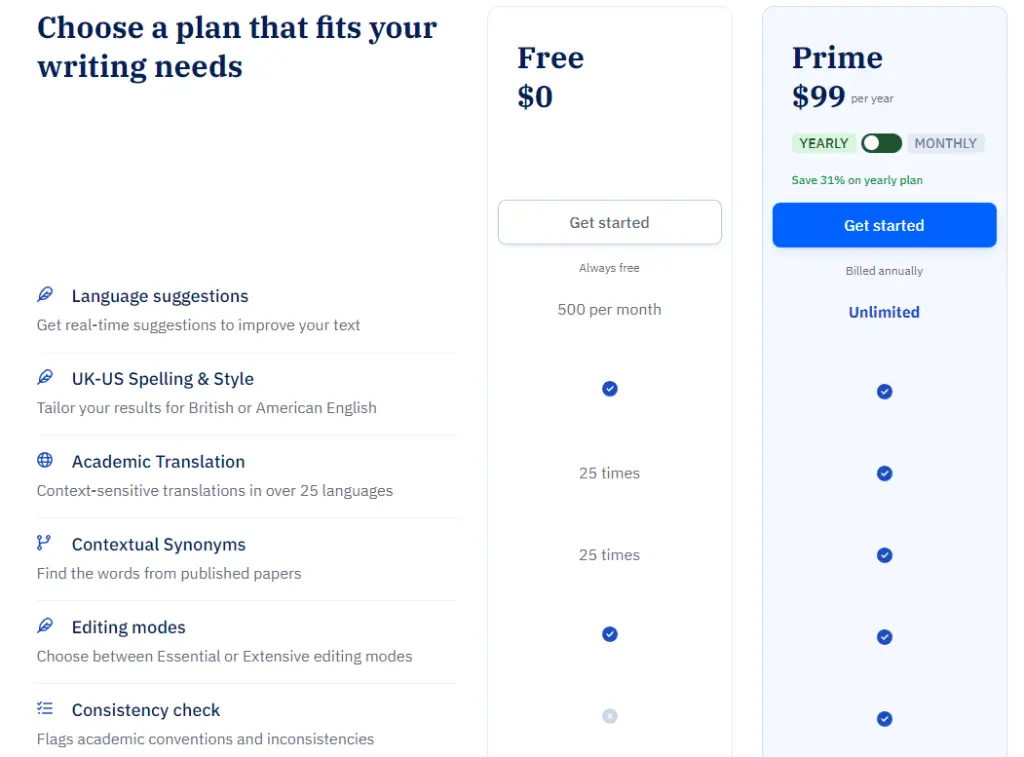
The Prime plan offers unlimited language suggestions and is priced at $99, which translates to just $8.25 per month when billed annually. For those who prefer a monthly plan, it is available at an affordable rate of $12 per month.
Smart Reference Tool While Writing ($3.00/mo)
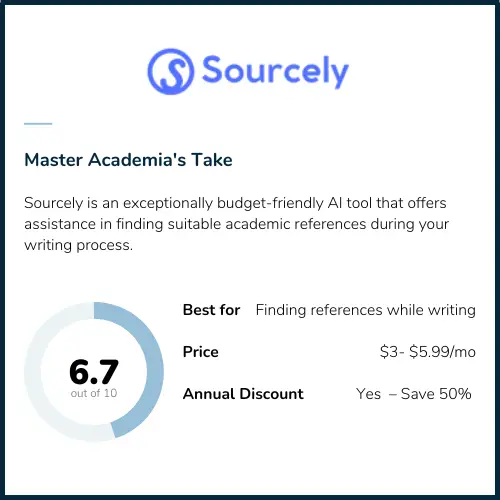
Sourcely is an AI-powered source-finding tool developed by a team of students which offers an easy-to-use solution for academic writers in search of references.
By analyzing text and identifying key themes, Sourcely searches through a vast data set to locate relevant and reliable sources, providing academic writers with the information needed to support their work.
Good references are crucial in academic writing, as they provide legitimacy to arguments and claims.
Simply input your essay title or text, and Sourcely finds suitable sources to enhance your work.
- Source discovery – Sourcely provides a unique approach where you can first write your content and then effortlessly discover relevant sources to support your ideas.
- Summaries – Sourcely offers a convenient feature called “Summarize a Source,” allowing users to obtain a summary of an article or source they are considering for their work.
- Affordability – Sourcely is highly affordable, making it an accessible option for users.
- Sourcely’s feature of providing interesting source recommendations is appealing, but it is not comprehensive enough to solely rely on and neglect consulting resources from other reliable sources.
- Sourcely has limited features compared to other AI writing tools.
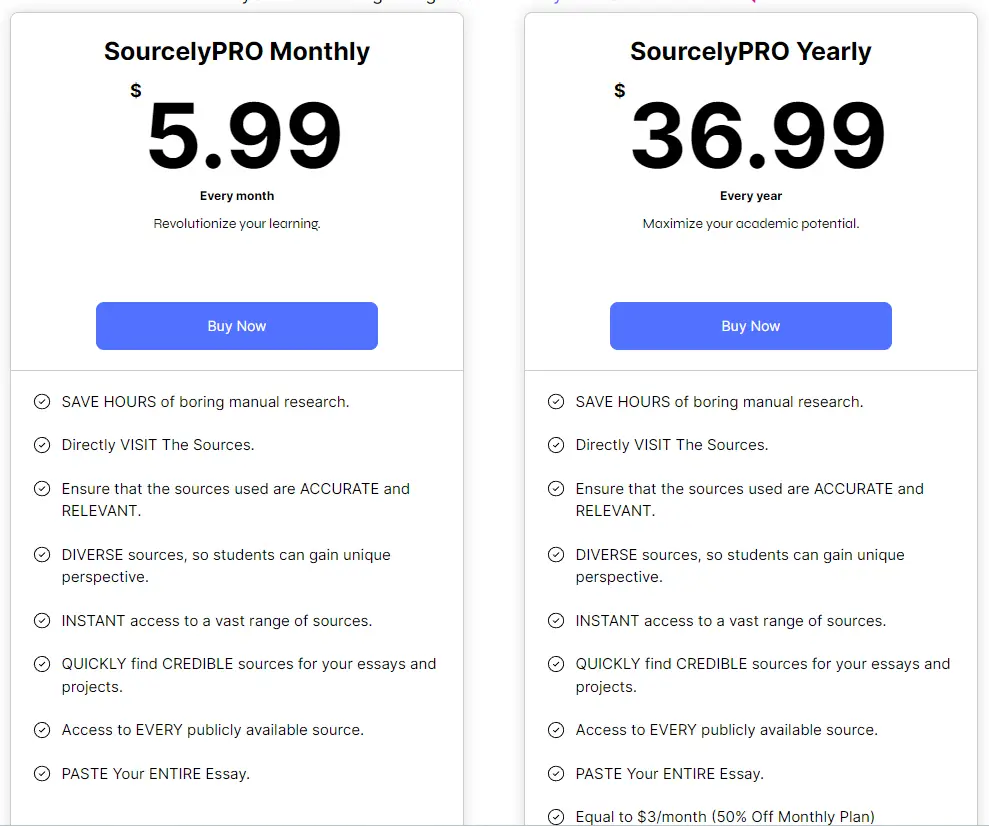
Sourcely offers great affordability with a price of $5.99 per month or $36.99 per year. While it may have fewer features compared to other academic writing tools, its lower price point still makes it a valuable and useful tool for academic writing.
Fast Translating and Rewording Tool ($7.5/mo)
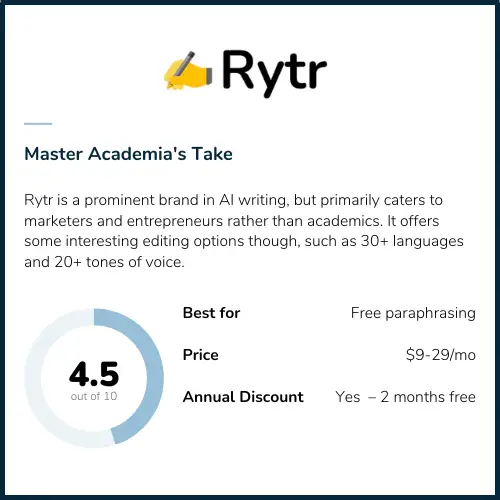
Rytr is an AI writing assistant that quickly generates high-quality content at an affordable price, primarily targeting marketers, copywriters, and entrepreneurs.
While it is recognized by G2 (business software reviews) as a leading brand in the AI Writing space and claims to be “loved by academicians,” it is important to note that Rytr is not trained on academic articles.
Rytr is a text-generating AI tool. Depending on the purpose, academics can find it useful for selecting from multiple languages and tones of voice, as well as rewording and shortening text.
With the convenience of a browser extension, Rytr saves time and ensures your copy is top-notch especially for emails, social media posts, or blogs.
- 40+ use cases – Rytr is an AI writing assistant that offers content generation for over 40 use cases, including emails, cover letters, and blog posts, with the ability to both shorten and lengthen content as needed.
- Generous free plan – While Rytr is not specifically targeting academic writing, it provides a generous free plan that can be beneficial for tasks such as writing emails and blog posts for research dissemination.
- Translation – Rytr can help you to translate your texts into 30+ languages.
- Customization – The platform offers a range of options to enhance the writing process, including language selection, tone customization, expanding or rephrasing text, formatting options, and even a readability score feature.
- Rytr is not suitable for essay or academic writing purposes, as it lacks the necessary features specifically designed for these types of tasks.
- It is not targeted towards researchers and fails to provide valuable tools like citation assistance, which is essential for academic writing.
- While Rytr offers a range of features, some of them, such as SEO optimization, are irrelevant and not beneficial for academic writing purposes.

Rytr offers a free plan that allows users to generate content up to 10,000 characters per month. For more advanced features and increased usage, there is the Saver Plan priced at $9 per month (or $7.5 per month when billed annually).
Alternatively, the Unlimited plan is available at $29 per month or $290 per year. These different pricing tiers cater to the diverse needs of users, ensuring they can find the plan that best suits their requirements.
Paraphrasing and Translation Tool ($12.67/mo)
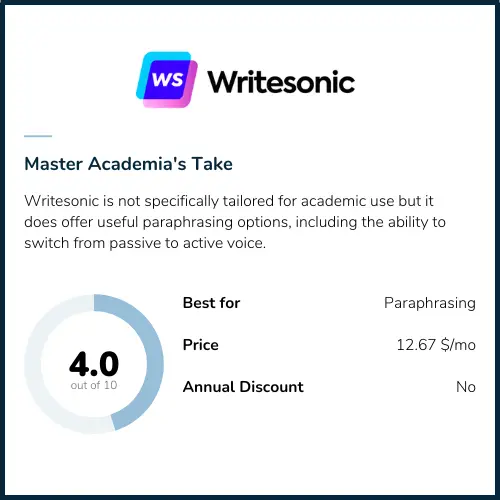
While Writesonic is primarily geared towards marketing teams and entrepreneurs, it offers an intriguing feature for academics: the paraphrasing tool. This tool allows users to rephrase content in multiple languages.
With Writesonic ‘s paraphrasing tool, you can effortlessly rewrite sentences, paragraphs, essays, and even entire articles with a simple click.
Produced content is 100% unique and free from plagiarism.
Upon generating a paragraph, Writesonic provides three different versions for you to choose from. It allows you to select the best option or make edits and revisions using the various variations.
- Choice – Writesonic provides three paraphrased options for each paraphrase, ensuring you find the most suitable and impactful version for your content.
- Switching from passive to active voice – Transform your writing by switching from passive voice to active voice. Active voice sentences provide clarity, conciseness, and impact, ensuring you don’t miss out on great opportunities. The rewording tool allows you to rephrase paragraphs and change the voice of your sentences effortlessly.
- Paraphrase your content in different languages – Writesonic’s Paraphrase tool can be used to conduct AI paragraph rephrasing in up to 26 different languages.
- Writesonic is not specifically designed for academic writing, and its features are not tailored to meet the specific requirements of academic writing.
- The platform lacks an academic writing style, which is essential for maintaining scholarly integrity and adhering to academic conventions.
- While Writesonic offers various features, some of them, such as SEO optimization, are not directly applicable or relevant to academic writing tasks.
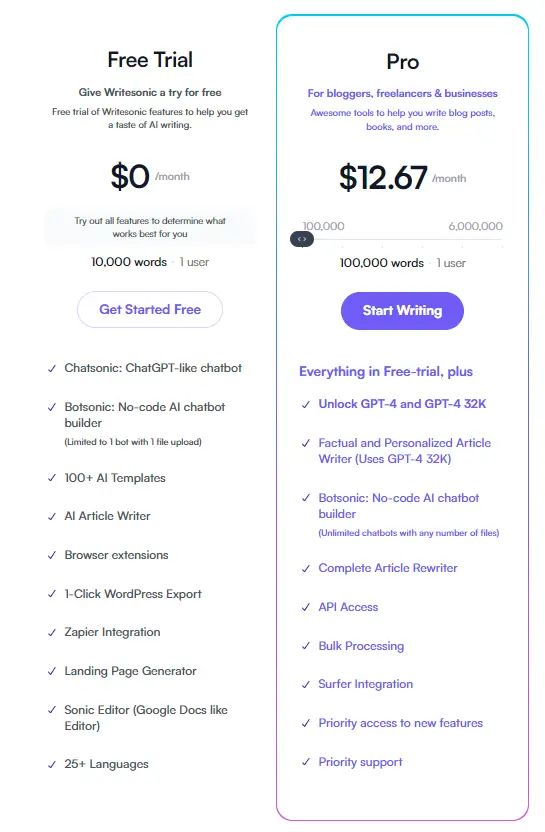
You can start with a free trial of Writesonic to experience its features. If you decide to upgrade to the Pro version, it is available at a cost of $12.67 per month.
Summarizing and Paraphrasing Tool ($19.99/mo)
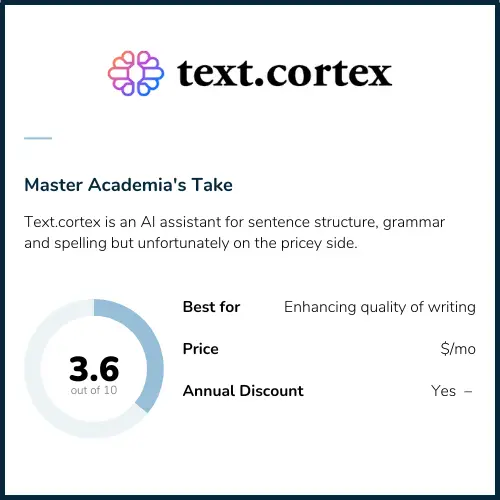
With TextCortex you can say goodbye to any worries about wording and spelling mistakes. Furthermore, it can help you to speed up your reading process.
TextCortex is an AI tool which can condense long texts into concise summaries, capturing the essential points.
Moreover, it can enhance your fluency and adapting vocabulary, tone, and style to match any situation.
- Paraphrasing – TextCortex offers a powerful paraphrasing tool to help you rephrase and enhance your text.
- Translations – TextCortex’s translation feature allows you to effortlessly write in over 25 languages including French, German, Spanish, Swedish, and more.
- TextCortex is not specifically designed for academic writing, catering to a broader audience instead.
- It may not be cost-effective for academics due to its high price relative to the limited functionality it offers for academic writing purposes.
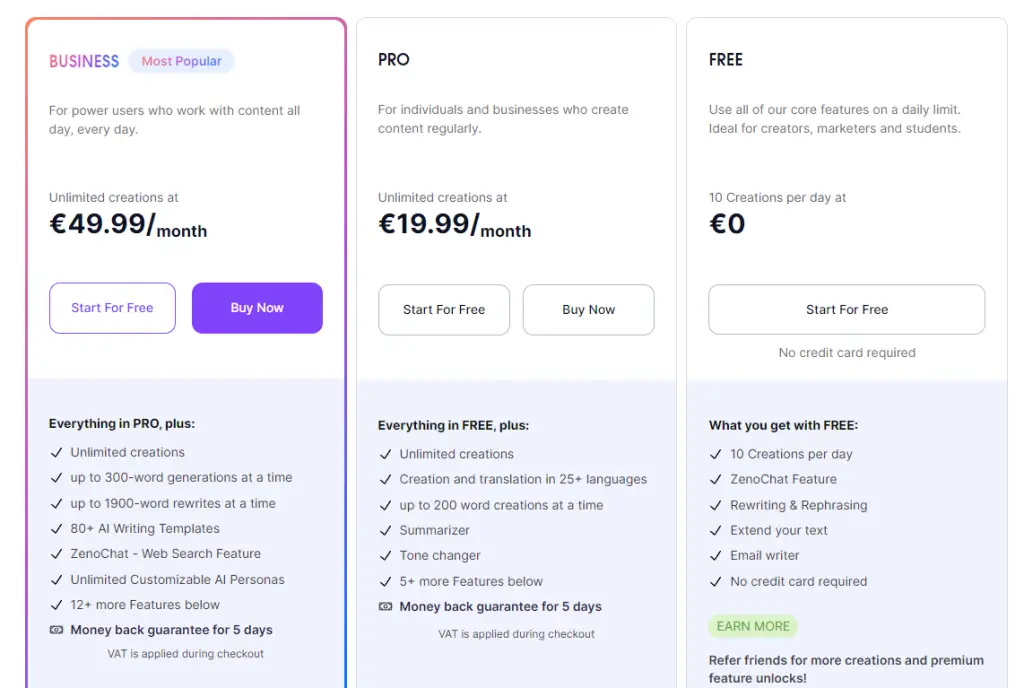
With the free version of TextCortex, you have the ability to create up to 10 pieces per day. For enhanced features and unlimited usage, the Pro version is available at a price of $19.99.
The landscape of AI writing tools is continuously evolving, witnessing the introduction of new tools regularly. However, not all these tools are equally suitable for academic writing, as their effectiveness depends on your specific goals and requirements.
While some tools, although not specifically designed for academic writing, can still provide valuable assistance in certain areas, there are standout options that are solely dedicated to enhancing academic writing.
Keeping this in mind, our top picks for academic writing support are the following AI tools:
Master Academia
Get new content delivered directly to your inbox.
Subscribe and receive Master Academia's quarterly newsletter.
How to benefit from ChatGPT as an academic
38 common academic job interview questions (+ powerful answers), related articles.
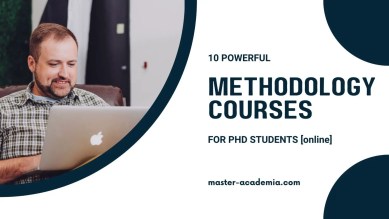
10 powerful methodology courses for PhD students [online]

The best online courses for PhD researchers in 2024
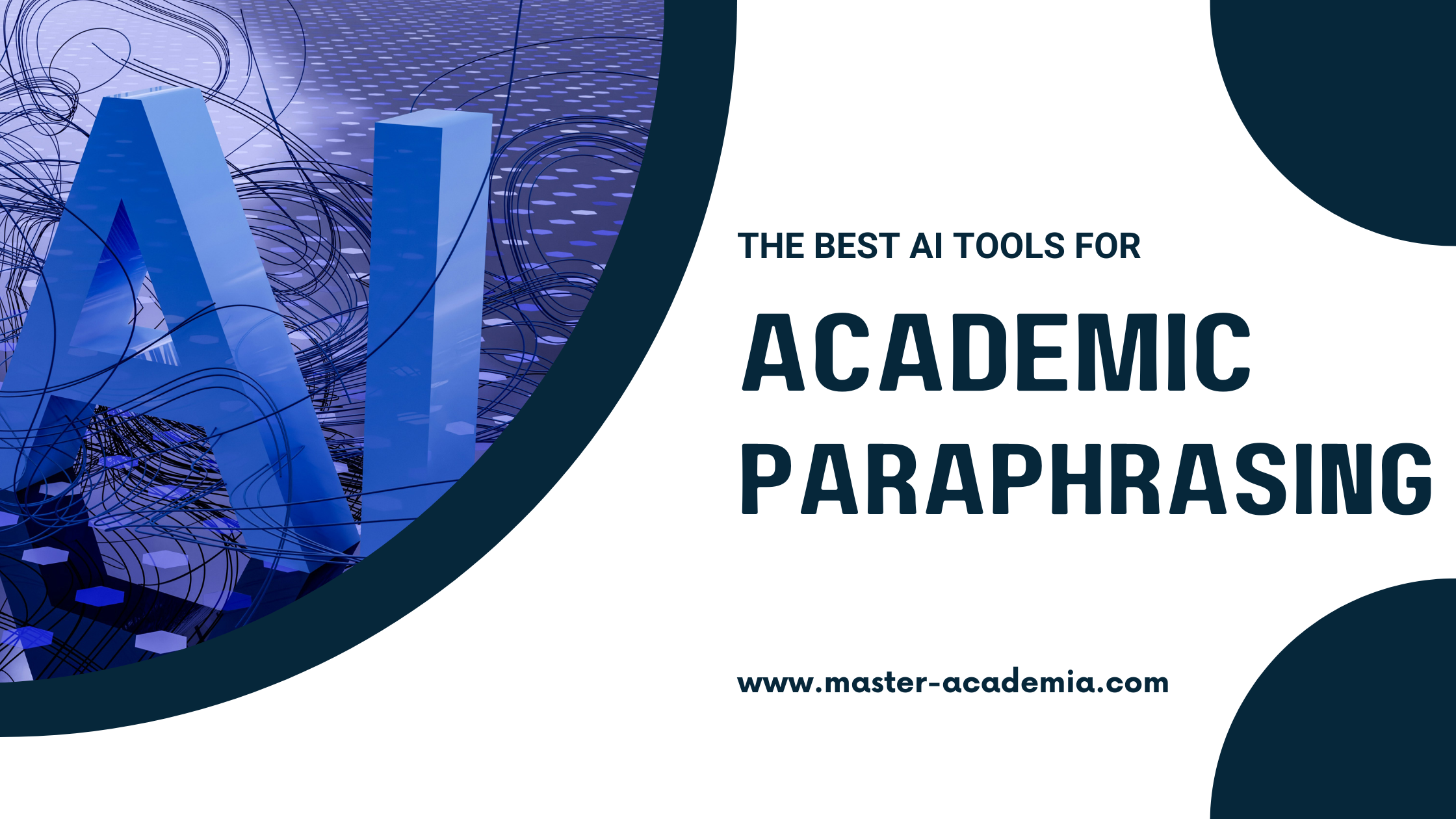
The best AI tools for academic paraphrasing: tested and ranked
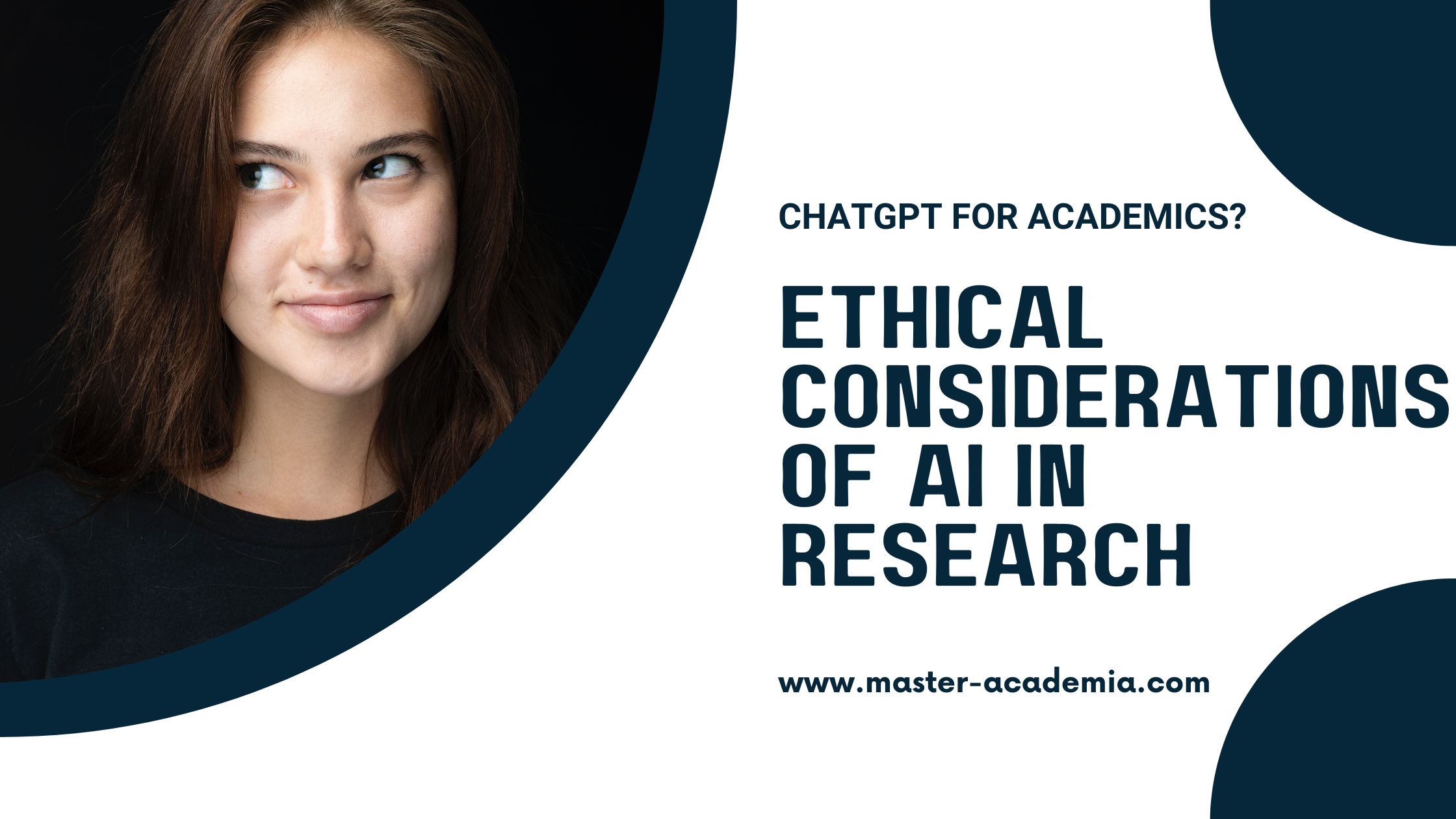
ChatGPT for academics? Ethical considerations of AI in research
Your personal research assistant
Zotero is a free, easy-to-use tool to help you collect, organize, annotate, cite, and share research.
Available for Mac, Windows, Linux, and iOS
Just need to create a quick bibliography? Try ZoteroBib .
Meet Zotero.
Collect with a click..
Zotero automatically senses research as you browse the web. Need an article from JSTOR or a preprint from arXiv.org? A news story from the New York Times or a book from a library? Zotero has you covered, everywhere.
Organize your way.
Zotero helps you organize your research any way you want. You can sort items into collections and tag them with keywords. Or create saved searches that automatically fill with relevant materials as you work.
Cite in style.
Zotero instantly creates references and bibliographies for any text editor, and directly inside Word, LibreOffice, and Google Docs. With support for over 10,000 citation styles, you can format your work to match any style guide or publication.
Stay in sync.
Zotero can optionally synchronize your data across devices, keeping your files, notes, and bibliographic records seamlessly up to date. If you decide to sync, you can also always access your research from any web browser.
Collaborate freely.
Zotero lets you co-write a paper with a colleague, distribute course materials to students, or build a collaborative bibliography. You can share a Zotero library with as many people you like, at no cost.
Zotero is open source and developed by an independent, nonprofit organization that has no financial interest in your private information. With Zotero, you always stay in control of your own data.
Still not sure which program to use for your research? See why we think you should choose Zotero .
Ready to try Zotero?
When you choose to publish with PLOS, your research makes an impact. Make your work accessible to all, without restrictions, and accelerate scientific discovery with options like preprints and published peer review that make your work more Open.
- PLOS Biology
- PLOS Climate
- PLOS Complex Systems
- PLOS Computational Biology
- PLOS Digital Health
- PLOS Genetics
- PLOS Global Public Health
- PLOS Medicine
- PLOS Mental Health
- PLOS Neglected Tropical Diseases
- PLOS Pathogens
- PLOS Sustainability and Transformation
- PLOS Collections
Welcome to the PLOS Writing Center
Your source for scientific writing & publishing essentials.
A collection of free, practical guides and hands-on resources for authors looking to improve their scientific publishing skillset.
ARTICLE-WRITING ESSENTIALS
Your title is the first thing anyone who reads your article is going to see, and for many it will be where they stop reading. Learn how to write a title that helps readers find your article, draws your audience in and sets the stage for your research!
The abstract is your chance to let your readers know what they can expect from your article. Learn how to write a clear, and concise abstract that will keep your audience reading.
A clear methods section impacts editorial evaluation and readers’ understanding, and is also the backbone of transparency and replicability. Learn what to include in your methods section, and how much detail is appropriate.
In many fields, a statistical analysis forms the heart of both the methods and results sections of a manuscript. Learn how to report statistical analyses, and what other context is important for publication success and future reproducibility.
The discussion section contains the results and outcomes of a study. An effective discussion informs readers what can be learned from your experiment and provides context for the results.
Ensuring your manuscript is well-written makes it easier for editors, reviewers and readers to understand your work. Avoiding language errors can help accelerate review and minimize delays in the publication of your research.
The PLOS Writing Toolbox
Delivered to your inbox every two weeks, the Writing Toolbox features practical advice and tools you can use to prepare a research manuscript for submission success and build your scientific writing skillset.
Discover how to navigate the peer review and publishing process, beyond writing your article.
The path to publication can be unsettling when you’re unsure what’s happening with your paper. Learn about staple journal workflows to see the detailed steps required for ensuring a rigorous and ethical publication.
Reputable journals screen for ethics at submission—and inability to pass ethics checks is one of the most common reasons for rejection. Unfortunately, once a study has begun, it’s often too late to secure the requisite ethical reviews and clearances. Learn how to prepare for publication success by ensuring your study meets all ethical requirements before work begins.
From preregistration, to preprints, to publication—learn how and when to share your study.
How you store your data matters. Even after you publish your article, your data needs to be accessible and useable for the long term so that other researchers can continue building on your work. Good data management practices make your data discoverable and easy to use, promote a strong foundation for reproducibility and increase your likelihood of citations.
You’ve just spent months completing your study, writing up the results and submitting to your top-choice journal. Now the feedback is in and it’s time to revise. Set out a clear plan for your response to keep yourself on-track and ensure edits don’t fall through the cracks.
There’s a lot to consider when deciding where to submit your work. Learn how to choose a journal that will help your study reach its audience, while reflecting your values as a researcher.
Are you actively preparing a submission for a PLOS journal? Select the relevant journal below for more detailed guidelines.
How to Write an Article
Share the lessons of the Writing Center in a live, interactive training.
Access tried-and-tested training modules, complete with slides and talking points, workshop activities, and more.
TRY OUR FREE APP
Write your book in Reedsy Studio. Try the beloved writing app for free today.
Craft your masterpiece in Reedsy Studio
Plan, write, edit, and format your book in our free app made for authors.

Blog • Perfecting your Craft
Last updated on Feb 07, 2023
The 23 Best Writing Tools of 2024: A Guide for Writers
Before the computer there was the typewriter, and before the typewriter there was pen and paper, and before pen and paper there were plenty of other lost tools of writing — like clay, papyrus, wood, slate, parchment, and, of course, pens made out of reeds. (Fun fact: the name “Reedsy” is inspired by the “reed pen,” which was used as early as 800 B.C. for documentation).
As you can tell by now, the act of writing has been a part of human culture from the days of chiseling stories onto the walls of caves — and as we have evolved, so have our writing tools . In fact, today’s writers and storytellers are spoiled for choice when it comes to deciding which tools to use.
The following list details our favorite writing tools and resources for taking any idea through to its written conclusion. If you want to cut straight to the chase and find out which is the right writing app for you, we recommend taking this quick 30-second quiz.
Which writing app is right for you?
Find out here! Takes 30 seconds
Otherwise, let's dive in!
Writing tools
We all know Google Docs and Microsoft Word, so we’re not going to waste your time giving those two a run-down in our list. Below are four other word processors you might not know about, and that are worth checking out.
1. Reedsy Book Editor
Cost: Free Does “fake it ‘til you make it” ring true to you? Well, the Reedsy Book Editor is a free, online word processor that formats your book as you write. See your drafts automatically turn into a professional-looking, ready-to-publish manuscript — and allow this glimpse of your work as the final product spur your motivation to write.

It comes with an automatic spell-checker — and a built-in goal reminder system to get you back into shape if you find that you're falling behind on your writing schedule! Another one of the Reedsy Book Editor’s best functions is that it lets you instantly typeset your manuscript to EPUB and print-ready PDF files.
Check it out if: if you want a writing tool that takes care of formatting and conversion for you.

FREE WRITING APP
The Reedsy Book Editor
Set goals, track progress, and establish your writing routine in our free app.
Cost: Free Do you like a helpful tap on the shoulder, reminding you about something you need to do? Well, you’ll likely enjoy Draft then, because the book writing software not only keeps track of how many words you write per day, it can also email you daily reminders about your daily word count goals. (Of course, if this sounds a little too “hands-on” for you, you can always turn the reminder function off).
Other than that, Draft functions a lot like Google Docs: allowing you to track changes, collaborate via suggested edits, and make comments on the doc.
Check it out if: you like Google Docs, but want an even simpler interface.
3. LibreOffice
Cost: Free Yes, we did say that we wouldn’t mention Microsoft Word, because by now everyone knows that it’s a useful writing tool. But we didn’t say we wouldn’t mention its free counterpart: LibreOffice .
LibreOffice is the open source answer for people who want to try Microsoft without paying the price tag. (Open source means that the software is built on code that anyone can inspect and enhance). Plus it’s compatible with all of the regular file types people are used to, such as .doc, .docx, .xls, .xlsx, .ppt, and .pptx files.
Check it out if: you like a classic word processor — and moreover, a free one.
Cost: $50 (or try a 30-day free trial) The people behind Mellel don’t just know word processing — they also know catchy, memorable marketing. Their description of why writers should choose Mellel starts like this: “Mellel is a writer's dream come true. To start, it is exceedingly boring: it just works, day in and day out, reliably. An enormous number of people used Mellel to write and they all report that their journey with Mellel was boring and uneventful. As well it should. In other words, it does all the mundane bits, and leaves the creative stuff to you.”
Mellel is not free (and note that it’s only for Mac). In return for the price tag, you’ll get more book-specific tools than other, perhaps more traditional word processors — such as outlining and bibliography-making functions. And, judging by the witty, funny copy on Mellel’s website, Mellel makes the process of writing much more fun than they let on.
Check it out if: you’re a Mac user who wants more than the Pages app offers.
Organization tools
Plotters tend to finish their writing projects quicker than pantsers — simply because when they hit a wall, they have their notes or outlines to reference, allowing them to jump straight over that hurdle and hit the ground running. P.S. You can grab a free template for your book outline here in this comprehensive guide to outlining .
The following resources will help you keep your thoughts organized so that any bouts of writer’s block don’t slow you down.
5. Milanote
Cost: Free for basic plan or $12.50/month for premium. Milanote is an easy-to-use creative writing app to organize your research, ideas, characters and outline in one place.
The vast majority of novelist-oriented writing software is organized around the idea of a linear document. But for most people, writing isn’t linear — because thinking isn’t linear. Writing is about gradually getting a jumble of ideas into shape, and Milanote's writing app matches the way writers think.
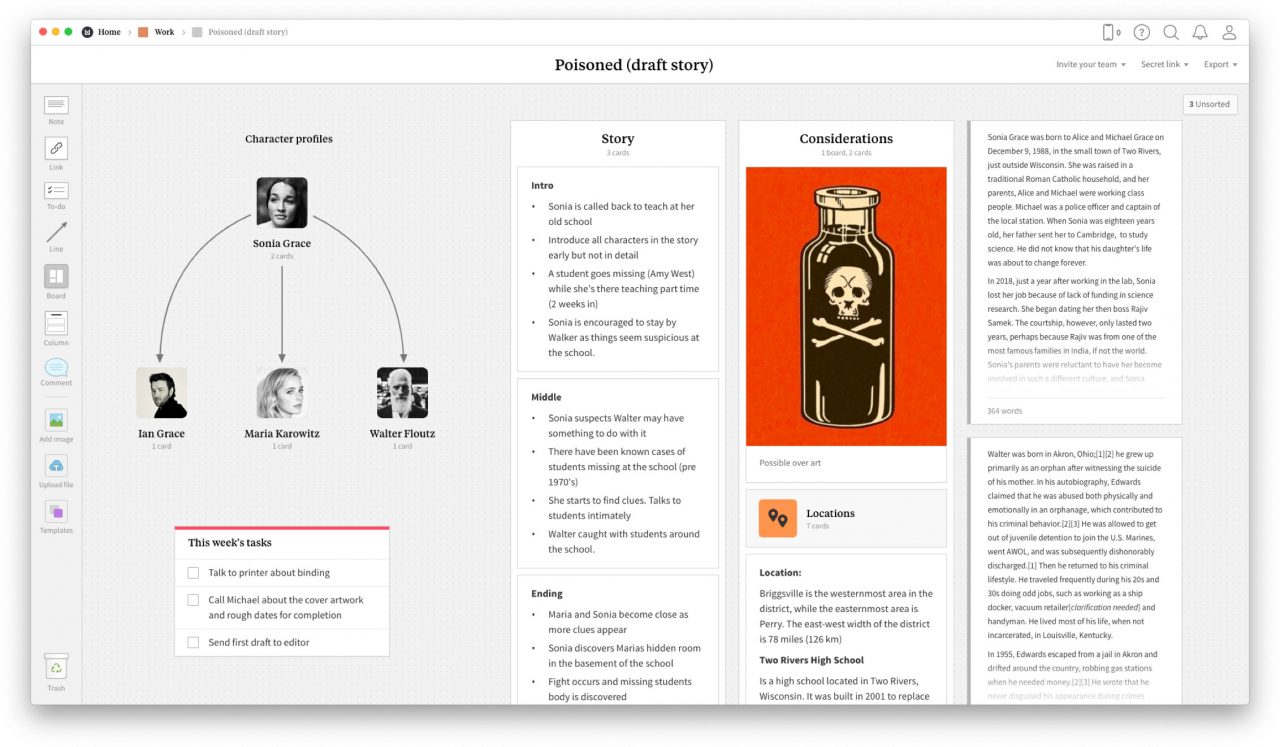
Check it out if: you're a plotter who likes a flexible workspace to organize ideas and see a birds-eye view of how your story outline is coming together.

FREE RESOURCE
Get our Book Development Template
Use this template to go from a vague idea to a solid plan for a first draft.
6. Evernote
Cost: free for basic plan or $9.99/month for premium. Its cute, little green elephant logo aside, Evernote is a great and easy-to-use option for writers who could do with a little more organization in their lives.

The app lets you quickly jot down thoughts, record audio notes, save online articles you’re hoping to reference, and it will sync all of this information across all of your Evernote-installed devices. What’s also handy about the app is the collaborative aspect of it: you can create shared accounts, so that multiple people can access saved documents at once.
Check it out if: you’re prone to getting great ideas while on the go, and need somewhere to make sure you don’t forget them by the time you’re home.
Cost: $5/month or $40/year (or try a 14-day free trial) While it’s ultimately a writing tool, one of the best assets of comprehensive programs like Ulysses or Scrivener are their organizational features. At the end of the day, whether you’re writing a blog post or a full-length novel, the seed of an idea doesn’t get too far without the ability to organize that idea into a cohesive piece of writing.
And that’s exactly what Ulysses allows you to do: organize your thoughts into a well-written work. This is accomplished through features like customizable writing goals and deadlines, plain text enhancements, a distraction-free typewriter mode, bookmarks, outlining functions, and more.
Check it out if: you’re working on a lengthy piece of non-fiction, like a blog post or essay. (For a comparison of Scrivener vs. Ulysses, keep reading!)
8. Scrivener
Cost: $45 (or a 30-use free trial) Literature and Latte ’s word processor is a popular writing tool — also, in large part, thanks to its organizational capabilities that seamlessly allow writers to turn fragmented ideas into a fully realized book/script/research paper/or whatever else you’re writing.
Scrivener vs Ulysses Apart from the price (Scrivener charges a one-time licensing fee while Ulysses charges yearly), the two platforms offer many of the same features. So we’ll focus on what makes the two programs different.
- Scrivener’s corkboard function is an absolute favorite for writers who rely on visual aid to help with outlining. The function looks like an actual corkboard, and lets writers pin notes to the board in chronological order.
- Scrivener offers templates for works such as fiction, essays, recipe collections, screenplays, comic books — which gives Scrivener another point for versatility.
- Ulysses boasts an interface that is slightly more clean and simple — so if ease-of-use is high on your priority list, it might be the better option for you.
- Ulysses offers a very helpful WordPress and Medium integration, which bloggers who publish on either of these platforms will love.
Check it out if: you’re working on a longer piece of content (like a book or screenplay) and want one comprehensive place to manage all your work. (And don’t forget to check out our equally as comprehensive review of Scrivener’s newest update : Scrivener 3!)
9. Hubspot's AI Content Writer
Cost: Free, with premium upgrade available
HubSpot’s Free AI Content Writer is designed to help bloggers streamline their content creation process. This tool can generate drafts of blog posts, website copy, emails, and more with ease and without additional resources, by relying on prompts or topics provided by users. For those suffering from writer's block, the AI content writer can also create outlines to help spur writing along.
For those already using HubSpot's marketing and sales tools, the AI content writer's integration will be extra handy.
Check it out if: you're a blogger short on time or inspiration.
Productivity tools
Alright, let’s kick things into high gear now. You know what you want to use to write, and your thoughts and ideas are concisely organized. If you’re finding it difficult to buckle down and get the job done (or struggle to write quickly or consistently), these resources will help you realize that Nike manta: just do it.
10. Ommwriter
Cost: free web version or $7 for the full program Do you find the clacking sound of old typewriters satisfying? Do you find soft, neutral colours calming? Does nothing really get you focused quite like a purposeful, long, deep breath? If so, Ommwriter might be the tool to help you reach your goal. As the site’s tagline reads, Ommwriter is “a perfect place to think and write.”

With soothing background noises, customizable keyboard noises, and peaceful backgrounds to choose from, Ommwriter could just be the “break” from everything else going on around you that you need to write.
Check it out if: your very best writing ideas come to you while in “savasana.”
11. To Doist
Cost: free or $4/month for premium plan Have you ever woken up in a cold sweat, panicking about something important you forgot to do? Or, god forbid, gripped in dread about how far behind you are on your word-count goals?
Well, To Doist might be able to help. It’s the ultimate app for creating to-do lists — but these aren’t your grandma’s pen-and-paper lists with little check marks beside them (though we mean no offense to your grandma). It lets you get a daily or weekly overview of your tasks, prioritize the tasks that are most important, and even lets you assign tasks to other people if you’re working on a specific goal with other collaborators.
Check it out if: you have never been able to find an agenda that’s souped up enough to keep you on track.

FREE COURSE
How to Build a Solid Writing Routine
In 10 days, learn to change your habits to support your writing.
12. Marinara Timer
Cost: Free The Pomodoro Technique is a time management method meant to promote productivity. In a nutshell, it stipulates that you should work for 25 minutes, then take a 5-minute break, then work for 25 minutes, take another 5-minute break, etc., etc.
The free-to-use Marinara Timer makes this easy for you by alerting you each time your work sessions and breaks are up. It also offers customizable timers in case the 25/5 isn’t quite right for keeping you on track. Fun fact: taking a break to stand up or walk (or do anything but sit!) every hour is also a good way to protect your back if you sit hunched at a computer working for long stretches at a time.
Check it out if: consistent breaks from work help actually keep you focused on the task at hand.
13. Cold Turkey
Cost: Free for basic plan or $20 for premium plan “Meet your match, Zuckerberg,” says Cold Turkey ’s tagline. In case that, paired with the writing tool’s name, doesn’t make it clear enough, Cold Turkey is a program that allows you to completely rid yourself of distraction. And when we say “completely,” we mean completely.
With Cold Turkey, you can block yourself from accessing certain websites — or even your entire computer — for periods at a time, only allowing you to use the current document you’re working on.
Check it out if: “willpower” is not a characteristic you’d ascribe yourself, and the only way for you to get something done is in a totally distraction-free state.
14. Freedom
Cost: $7/month or $29/year (or a 7-use free trial) Apart from pleasantly getting the “freedom” refrain from Aretha Franklin’s “Think” stuck in your head, the Freedom app is another resource that can turn your devices into tools of productivity once more.
It functions like Cold Turkey; however, a unique function of Freedom is the ability to sync your distraction-free periods across all your devices. So if you know that on Tuesdays, you want your computer, phone, and tablet to all block access to Twitter, Instagram, and Facebook — you can!
Check it out if: letting other people know not to bother you during your non-negotiable writing time isn’t enough, you need to let yourself know not to interrupt, well, yourself.
Cost: Free If total silence encourages your mind to wander, whereas light sensory action keeps your thoughts on the task at hand, Noisli will be a friend to you. The tool lets you choose from a range of soundtracks, such as rain, coffee shop, wind, lake, and more. You can mix several sounds at once, and choose the volume for each one. So let’s say you want to create the atmosphere of writing by a babbling brook, with a fire crackling next to you, and the moon shining brightly overhead. Noisli will make this happen for you!
Check it out if: you get the most work done with white noise.
Editing tools
If you’re planning to publish a book — or any kind of writing you’re hoping to make a profit from, it’s crucial that your work is thoroughly edited. To that end, working with a professional editor is an investment you should give serious thought to.
In the meantime, here are a few editing tools that can help you out along the way. Hopefully, they’ll either ensure a typo-free draft, so by the time you do work with an editor, they can spend less time fixing small typos and more time on big-picture work, or, if you decide to forego a professional edit, you’ll have the tools to do the best editing job you can.
16. Hemingway
Cost: Free The Hemingway app claims to make your writing “bold and clear.” It has a number of handy features like a word-counter and an automatic readability score. But its real use lies in the features that make suggestions to your prose. For instance, it might highlight a complex sentence that’s hard to read. It also highlights instances of passive voice , qualifiers, and adverbs. Let’s take a look at how this passage from Ernest Hemingway’s very own To Have and Have Not fares:

“Just” is highlighted because it’s a qualifier, and Hemingway suggests, instead: “Be bold. Don’t hedge.” The sentence in red is highlighted as being hard to read. And “probably” is pointed out as an adverb — the app suggests using a forceful verb instead.
Check it out if: you want to bring out your inner Ernie. (Curious what else Hemingway offers? Check out our full review of the app right here .)

NEW REEDSY COURSE
How to Write a Novel
Enroll in our course and become an author in three months.
17. Fictionary
Cost: $19/month or $169 per year
The Fictionary Story Editing software creates intelligent visuals that help you improve your story's structure, characters, plot, and settings. Using Natural Language Processing, Fictionary identifies your key story arc scenes and gives you actionable insights to improve the structure of your book. Annual subscribers get access to year-round live classes on writing and editing. Think of it like Peloton for writers. Check it out if: You want to get your story structure in the best possible shape before submitting to agents and/or editors.
18. Marlowe Pro
Cost: $29.95/mth or $199/year; $45 for single reports
This manuscript assessment tool will provide in-depth feedback on your novel within minutes. Using artificial intelligence, Marlowe can analyze your plot, pacing, story beats, and readability — then provide actionable insights (as well as comp titles ) based on its database of bestsellers across a number of genres.
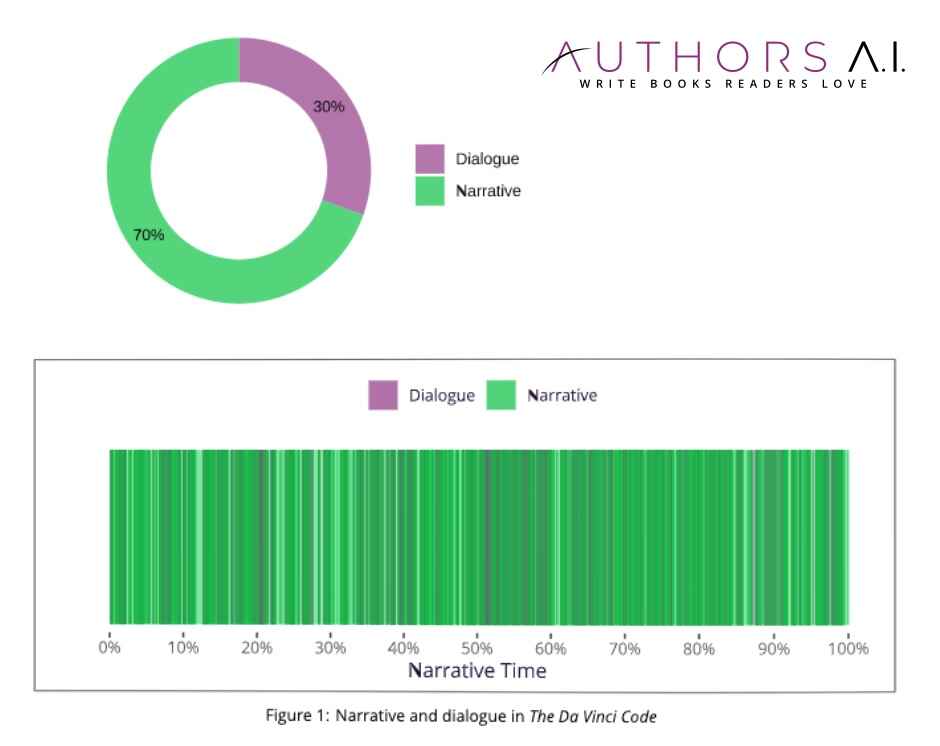
To try out this AI editor, claim a free report by entering REEDSYFREE at checkout. And for a 15% discount on a Marlowe Pro subscription , enter REEDSY15OFF when prompted at checkout.
Check it out: to take a scientific and methodical approach to your developmental edits.
19. Cliché Finder
Cost: Free Cliché Finder is exactly what it says on the tin: it combs through your writing in search of clichés, and then highlights them for you. It’s not always necessarily bad to use clichés in your writing, but when you do, you want to be purposeful about it (and not to mention aware of it!).
Check it out if: you want to avoid clichés like the plague, and for your book to sell like hotcakes — and the rest is history.
20. Grammarly
Cost: Free Have you ever sent an email, only to realize that you'd made a glaring typo just as you hit “Send”? Well, no more!
Grammarly essentially functions like the spell checker tool from Microsoft Word or Google Docs, but here’s the great part: it’s a plug-in that will work wherever you happen to writing. That means Twitter, Gmail, Google Docs, Facebook — anywhere. Plus it offers vocabulary or alternate word suggestions — for instance, it might suggest you replace “walking aimlessly,” with the word “wandering.” For a more in-dept analysis, check our full Grammarly review .
Check it out if: you’re typo-prone! (Read below for a comparison of Grammarly vs. ProWritingAid.)
21. ProWritingAid
Cost: Free browser extension or $79/year for the full software ProWritingAid is a tool you can install that will proofread and spell check your material for you , no matter where you’re writing. It will also offer suggestions to improve your overall language — outside of just grammatical technicalities. (You can even get 20% off via this special offer !)
ProWritingAid vs Grammarly The two programs offer a lot of the same services, so you might be wondering which one to pick. We have a review of ProWritingAid that dives deep into this comparison, but the main differences are:
- Grammarly is free to use, and while ProWritingAid offers a free Google Chrome plug-in, this free option only offers spell checking services, it won’t make editorial suggestions.
- ProWritingAid is slightly more tailored towards authors, while Grammarly is a slightly better fit for articles and essays. Ultimately, both tools lend a very helpful editing hand, so deciding between the two mostly boils down to the one you enjoy using more.
Check it out if: you want to make sure your writing is as polished as possible.
Workspace tools
At the end of the day, all you really need to write is a pen and paper. All the fancy tools and apps in the world won’t get the words out for you. That being said, creating an environment that’s appealing — and conducive! — to write in can make the whole process more enjoyable, and encourage you to get the job done.
Here are few physical tools to look over if you’re thinking of sprucing up your workspace.
22. Livescribe Pen
Cost: starts at $100 If you prefer writing on paper, but dread the process of transferring your words to a computer, Livescribe will likely be right up your alley. Through Bluetooth technology, the pen can actually transcribe your pen and paper words to your device. What’s more, it can also transcribe voice notes into digital documents for you.
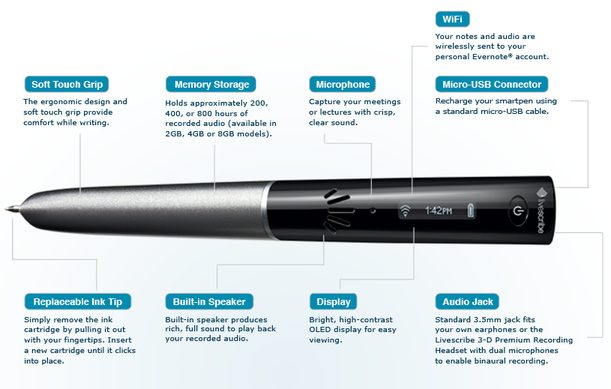
Check it out if: you’ve ever felt envy at Rita Skeeter’s Quick-Quotes Quill in Harry Potter and the Goblet of Fire .
23. Ergonomic desk setups
Cost: Varies As more and more of the workforce moves to sedentary jobs where the majority of 9am to 5pm is spent sitting — usually hunching — at a computer, a growing number of sitting-related health injuries have been occurring. That’s why looking into more ergonomically friendly desk setups is a good idea for writers who spend long hours at the computer — or even writing in a notebook. This could be a standing desk, or even just a number of textbooks piled under your desktop so that your screen is eye level, resulting in less stress on your shoulders.
Check it out if: you don’t want writing gains to come at the cost of growing back pains.
24. Computer Glasses
Cost: Varies Writers are all familiar with computer-caused eyestrains. Because you blink far less when looking at a screen than you do otherwise, computer vision syndrome (CVS) is a condition people have been developing due to long stretches of staring at a computer.
One way to help alleviate this — other than just making sure to take time looking away from your computer — is to invest in some computer glasses. They typically come in blue or amber shades, and are coated with a protective coating.
There are several brands you can check out, such as Pixel Eyewear or Felix Gray .
Check it out if: you notice itchy or tired eyes after long writing sessions.
Have you tried any of the above writing tools — and if so, which were your favorites? Or maybe you feel there are some great resources missing from this list? Let us know in the comments below!
Mystic says:
24/10/2019 – 03:38
I tried Cliche Finder several times and it found a couple of items in my text, but it didn't highlight where it was at. The rest of the tools here, that I can use since I'm on a strict income, are amazing!
Comments are currently closed.
Continue reading
Recommended posts from the Reedsy Blog

What is Tone in Literature? Definition & Examples
We show you, with supporting examples, how tone in literature influences readers' emotions and perceptions of a text.

Writing Cozy Mysteries: 7 Essential Tips & Tropes
We show you how to write a compelling cozy mystery with advice from published authors and supporting examples from literature.

Man vs Nature: The Most Compelling Conflict in Writing
What is man vs nature? Learn all about this timeless conflict with examples of man vs nature in books, television, and film.

The Redemption Arc: Definition, Examples, and Writing Tips
Learn what it takes to redeem a character with these examples and writing tips.

How Many Sentences Are in a Paragraph?
From fiction to nonfiction works, the length of a paragraph varies depending on its purpose. Here's everything you need to know.

Narrative Structure: Definition, Examples, and Writing Tips
What's the difference between story structure and narrative structure? And how do you choose the right narrative structure for you novel?
Join a community of over 1 million authors
Reedsy is more than just a blog. Become a member today to discover how we can help you publish a beautiful book.

We made a writing app for you
Yes, you! Write. Format. Export for ebook and print. 100% free, always.

1 million authors trust the professionals on Reedsy. Come meet them.
Enter your email or get started with a social account:

Top 13 Tools for Researchers in 2024!
Gone are the days of going to the library, studying numerous books, taking notes on paper, and doing research. Thanks to technology, we no longer have to do this tedious routine to do research. However, research is still a meticulous, painstaking process.
This is why we decided to uncover some of the best software tools for researchers that are going to help you conduct and maintain your research with ease. Read on…
List of Top 13 Best Tools for Researchers for better results:
Research today is dynamic. We often use the internet to browse websites, watch videos, study analytics, and conduct our research by exploring different types of digital content, making technology a major stakeholder in making our research success .
While the internet has made it easy for us to access worldly information with the click of a button (or mouse!), it has created a whole new set of problems.
Sorting through a seemingly infinite number of websites, verifying content, and curating only the best stuff can take a lot of time and effort. This is why we have brought you 13 essential research tools every researcher should use while working on the internet.
1. Bit.ai

Online research means going through numerous websites, articles, blogs, images, videos, infographics, and more to find what you are looking for.
For our dynamic, interactive, and media-rich research, we need a tool that incorporates all facets of modern-day research under one roof. Simple text editors of the past just won’t cut it anymore! This is where Bit comes in.
Bit allows researchers and teams to collaborate, share, track, and manage all knowledge and research in one place.
It’s the perfect research tool to share multi-dimensional research with your peers and not just plain, boring text and slides.
Add articles, PDFs, videos, white papers, ebooks, audio samples- basically anything you can think of – and share it with your peers easily!
Other notable features of Bit include:
- An easy-to-use, minimal editor that supports Markdown.
- Collaborative, real-time editing, and communication with peers.
- Add any type of digital content (images, videos, etc) to your Bit document.
- A content library to save all your media files for quick access.
- Smart search, allows anyone to search and find any files, images, documents, links, etc quickly.
All-in-all, Bit is a must-have writing tool for researchers and authors!

Key Features of Bit:
- Workspaces to store different research content easily
- Content library to store media assets
- Real-time collaboration with fellow researchers
- Free with limited functionality
- Paid plans start from Pro ($8/month), Business ($15/month), Enterprise (contact sales)
Read more: How Bit.ai Can Help You Manage Your Academic Research?
2. elink.io
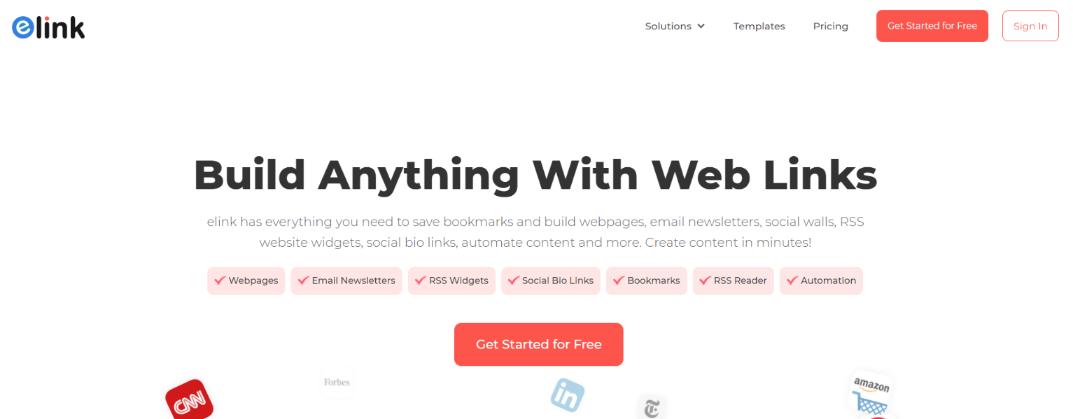
Research often involves going through hundreds of links and articles and compiling them in one safe space for future reference or publishing them for your audience.
This is why many researchers use bookmarking and curation tools like elink to quickly save their links under one roof and share them with their peers.
elink makes it easy for researchers to save content from around the web. They can save article links, videos, cloud files, social media posts, and much more!
Researchers have the option of saving content to their link library or adding them directly to content collections and sharing their research with their peers . To make the bookmarking process a breeze, elink also has a chrome extension .
Simply click on the extension or right-click on any webpage to save the content directly to your elink dashboard.
Researchers can edit the title and description to add their own voices or notes. They can even bundle links together and share their link collection with others as a newsletter or embed the collection on your blog/website!
Key Features of elink:
- Save links quickly using the chrome extension
- Create and share research links as a newsletter or embed it on your website
- Easy user-interface
- Paid plans start at Pro Monthly ($15/month), Pro 1 Year ($12/month), and Pro 2 years ($10/month).
3. GanttPRO
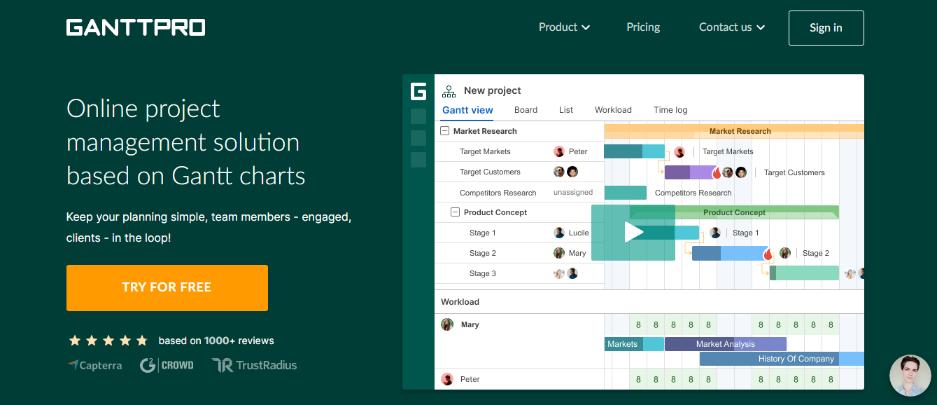
No matter what kind of research you do, you need to organize, plan, and stay focused on all of your activities.
Without a robust planning tool, researchers may fall behind the schedule and lose their progress.
GanttPRO project and task management tool makes it easy for single researchers and groups of any size to plan their tasks on a visually appealing Gantt chart timeline, follow their progress, and all the deadlines.
GanttPRO allows researchers to create a limitless number of tasks, groups of tasks, and subtasks on one timeline.
Besides, it’s a perfect planning tool for assigning tasks to your fellow researchers or creating virtual resources, whoever or whatever they may be. The software is a good choice for collaboration, time tracking, as well as sharing and exporting your schedules.
Key Features of GanttPRO:
- Dozens of ready-made templates.
- Real-time collaboration with fellow researchers.
- Elegant user interface with a short learning curve.
- Free 14-day trial with all features available.
- Paid plans start from Team ($4.5/user/month), Individual ($15/month), Enterprise (contact sales).
4. Grammarly
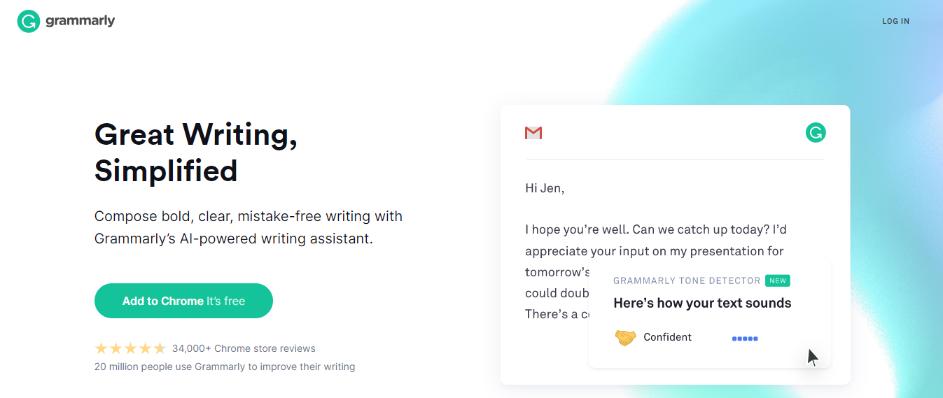
Research work often involves hours of proofreading and spellchecking to make your research professional .
Grammarly, a writing enhancement tool will save you a ton of time and effort doing this dreaded task! Apart from basic spellchecking and corrections, Grammarly includes a grammar checker, a punctuation checker, a vocabulary enhancer, and even a plagiarism checker tool!
This awesome tool scans your research for more than 250 types of grammar mistakes in six distinct writing genres and leaves you with error-free writing. With thorough explanations for all your errors and weekly progress reports .
Grammarly is a must-have tool for researchers. It’s available as a browser extension, a desktop app, a web-based app, and a Microsoft add-in. Many of the Grammarly alternatives are also available in the market that is equally good.
Key Features of Grammarly:
- Works with the majority of online tools like Word, Slack, etc.
- Plagiarism checker tool
- Tone detector
- Paid plans start from: Premium ($11.66/month), Business ($12.50/month)
Read more: 10 Best Writing Apps To Make You A Better Writer!
5. Typeset.io

With over 100,000+ verified journal formats to choose from, Typeform makes the process of research a bit too easy! Quickly copy-paste or upload your paper on Typeset and follow any citation style you need.
Typeset also has a plagiarism and grammar checker built in to ensure your writing is error-free. Once done uploading and citing, click on autoformat to generate your report in seconds.
You can also download your research in PDF , Docx, LaTeX file, or even as a Zip file. With collaboration features built-in, you can invite your fellow researchers to the platform and work together.
Key Features of Typeset:
- Over 100,000+ journal formats to choose from
- Plagiarism and grammar checker tool
- Editing services to improve your publication chances
- Paid plans start from: Researcher ($8/month), Team($6/month), Journals / Publishers (contact sales)
6. Scrivener

Scrivener is another great tool for research writing and keeping your notes organized.
Used by researchers, screenwriters, novelists, non-fiction writers, students, journalists, academics, lawyers, translators, and more, Scrivener is a tool made for long writing projects.
On signing up, you are quickly presented with its editor, with a sidebar to keep everything in place. You can also break your content into manageable sections of any size and leave Scrivener to join them together.
For novelists and storytellers, there’s also a corkboard to visualize your storyline and move cards around as you like.
The outliner keeps a synopsis of what you have already written, along with word count data and metadata. Users can arrange their research articles and other files in folders and subfolders.
Key Features of Scrivener:
- Desktop and mobile apps
- Outline creator
- Easy organization
- Paid plans start from $40.84/one-time fee
7. ProofHub

You must organize, prepare, and stay focused on all of your efforts, regardless of the type of research you conduct.
Researchers may go behind schedule and lose progress if they don’t have a good task management tool. ProofHub is an all-in-one project and team management application that allows research teams and organizations of any size to efficiently plan their research projects in one spot.
ProofHub allows you to create, assign and track tasks using effective task management features like Kanban boards and table view. Researchers can also get a visual idea of how their project is progressing using robust Gantt charts.
ProofHub also allows you to store and jot down all the data or information collected through your research in Notes. You can even create different notebooks and store your information according to the topic. Not just that, you can even share your research work with your team members.
Teams can also share and store files, documents, and images in ProofHub’s files section. Managers can track their team’s time spent on a specific research task using automatic and manual timers.
Team members can also brainstorm ideas or have real-time discussions in ProofHub’s discussions section and make way for better research work.
Key features of ProofHub:
- Ready to use project templates
- Task management
- Time tracking and project reporting
- Team collaboration (chat, notes, and discussions)
- File management
- Online proofing
- 14-day free trial with all the features.
8. Google Scholar

Next up is an amazing research tool by Google called Google Scholar. Google Scholar provides a quick way to broadly search for scholarly literature from one location.
Look for articles, theses, books, abstracts, and court opinions, from professional societies, online repositories, universities, academic publishers, and other websites.
Researchers can also explore related works, citations, authors, and publications easily. Create a public author profile and see who’s citing your recent publication. Google Scholar also allows its users to keep up with recent developments in any area of research.
Key Features of Google Scholar:
- Create a public author page
- Look for information across Google’s database
- Easy to use
- Free to use
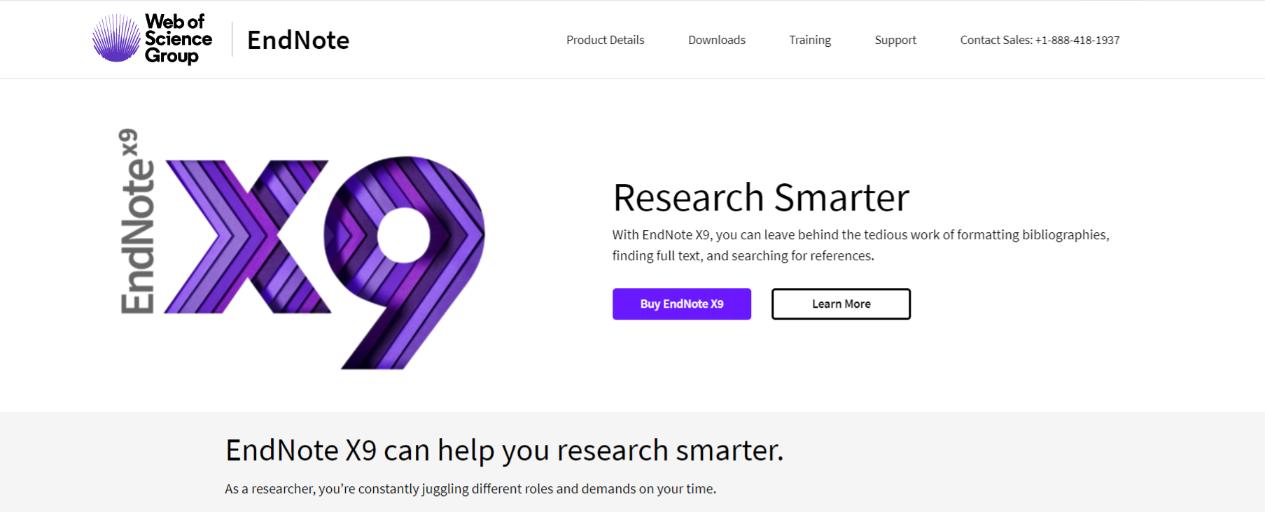
Endnote wants you to research smarter by simplifying the tiresome work of formatting bibliographies, finding full text, and searching for references.
Endnote is collaborative in nature as it allows you to share selected groups of references, manage team access, and track activity and changes from one single dashboard.
With smarter insights, Endnote automatically finds the impact of your references and finds the best-fit journal for your papers.
The platform also enables users to automatically create, format, and update bibliographies. Quickly export your references and full-text PDFs into EndNote and start working instantly.
With a bunch of EndNote templates and plug-ins, researchers can enhance their Endnote experience and get the most out of the platform.
Key Features of Endnote:
- Import filters for prior research
- Track your teammates’ activity on your shared library
- Automatic reference and link updating
- Paid plans start from $249
10. Evernote
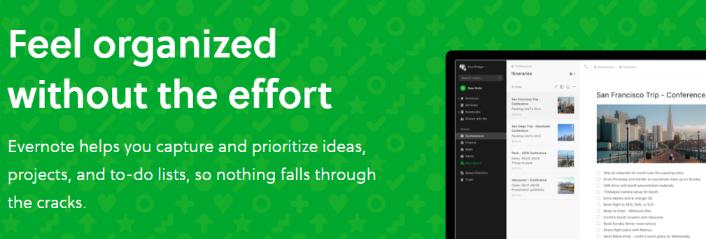
Evernote is a note-taking app that can be very useful while conducting research . The app helps you store all your personal ideas, to-do listsm4, notes, and research links in one place.
Create separate tags and folders for the different types of information you are saving and keep it all organized.
Evernote auto-syncs across all your devices, including desktop, smartphone, and tablet, so you can switch between devices without losing your data.
Its Chrome browser extension called the Evernote web clipper is a great add-on for saving articles or other content on the internet while doing your research.
Just click the browser extension to save the entire page or highlights to your Evernote notebook along with any notes you have about that page.
Key Features of Evernote:
- Keep notes, articles, and other content in one place
- Chrome extension for clipping content
- Set reminders
- Paid plans start from Plus ($34.99 per year or $3.99 per month), Premium ($69.99 per year or $7.99 per month), and Evernote Business (contact sales)
11. Mendeley

Mendeley is a reference management software that allows researchers to create references, citations, and bibliographies in multiple journal styles with just a few clicks.
Quickly access your library from anywhere – from anywhere. Windows, Mac, Linux, etc and add papers directly from your browser with a few clicks or import any documents from your desktop to your library.
With its research network, researchers connect and network with over 6 million users. Users can create groups to carry out discussions, discover research, and follow curated bibliographies.
There are also over 250,000 + science, technology, and health jobs to advance your career and grant info from over 5000 organizations to fund your next research !
Key Features of Mendeley:
- Annotate and organize documents
- Find and create groups with fellow researchers
- Grant information from over 5000 organizations
- Paid plans start from $55/year for 5 GB to $165/year to unlimited storage
12. ContentMine

ContentMine offers a variety of text mining services to help researchers find, download, analyze, and extract knowledge from academic papers.
ContentMine builds its own open-source code to help out researchers find papers and not waste time on the internet doing so. They can also convert academic papers , PDFs to HTML, or to almost any format.
ContentMine can also extract data from tables and graphs, reducing the time taken to conduct a meta-analysis. The platform also offers consultancy as well as training workshops to educate people on the work they do and how.
Key Features of ContentMine:
- Extract data from tables and graphs
- Quickly mine text from hundreds of papers
- Workshops and training
- Contact sales
13. ResearchGate

The last tool on our list of awesome tools for researchers is a platform called ResearchGate. ResearchGate gives you access to over 135 million publication pages, allowing you to stay up to date with what’s happening in your field.
With a built-in community, researchers can share their research, collaborate with peers, and discover new papers and bibliographies.
ResearchGate also provides deep analytics on who’s been reading your work and keeps track of your citations. With over 17 million users, ResearchGate is a research community to join!
Key Features of ResearchGate:
- Share and find researchers
- Analytics to see who’s reading your work
- Citation tracking
Before you go!
Our team at bit.ai has created a few awesome templates to make your research process more efficient. Make sure to check them out before you go, y our team might need them!
- Case Study Template
- Research Paper Template
- Competitor Research Template
- Brainstorming Template
- SWOT Analysis Template
- White Paper Template
Final Words
There you have it folks, our list of amazing websites, apps, and software to use while conducting your research. Research is hard work- from finding and managing content to organizing and publishing- research takes a lot of time and effort.
However, with our awesome list of tools, researchers are surely going to get out the most of their time and effort and get work done more efficiently. Did we miss any awesome tool for researchers out there? Let us know by tweeting us at @bit_docs.

Further reads:
- Top 11 Code Editors for Software Developers
- Collaborative Research: Definition, Benefits & Tips!
- Best Resource Management Tools and Software
- How to Write a Research Proposal?

11 Best Link in Bio Tools in 2024!
Writing Vision Statement: Definition, Examples and Best Practices!
Related posts
10 task management tools every business must be using, why workplace collaboration is more important than ever, program manager vs. project manager : the key differences explained, product launch plan: what is it & how to create it, burn-up charts: what are they and how to create one, collaborative research: definition, benefits & tips.

About Bit.ai
Bit.ai is the essential next-gen workplace and document collaboration platform. that helps teams share knowledge by connecting any type of digital content. With this intuitive, cloud-based solution, anyone can work visually and collaborate in real-time while creating internal notes, team projects, knowledge bases, client-facing content, and more.
The smartest online Google Docs and Word alternative, Bit.ai is used in over 100 countries by professionals everywhere, from IT teams creating internal documentation and knowledge bases, to sales and marketing teams sharing client materials and client portals.
👉👉Click Here to Check out Bit.ai.
Recent Posts
9 document management trends every business should know, ai for social media marketing: tools & tactics to boost engagement, a guide to building a client portal for your online course, knowledge management vs document management, 11 must-try ai tools for market research in 2024, 15 employee management software for 2024: a quick guide.
Training videos | Faqs

Academic Writing Tools and Research Software – A Comprehensive Guide
Overview | Writing Software | Reference Management Software | Research Tools | Grammar Checking Tools
In this blog, we review academic writing tools and software that students, academics, researchers and PhD students can benefit from. We have categorised the tools into four broad areas: writing tools, referencing tools, research tools and grammar checking tools. The motivation behind this blog is to provide readers with a snapshot of popular tools in each category.
1. Writing Tools and Software
Whether you are writing an article, research paper, essay, blog, and dissertation or PhD thesis, it is important to choose an appropriate writing software tool for your work. The choice of writing software comes down to your personal taste. Everyday users are happy to shed a few dollars to purchase a well-known writing tool such as MS Word. Tech savvies welcome open source projects such as OpenOffice and LibreOffice. Whereas, the research community is much more adventurous and has embraced the type-setting system, Latex as their writing medium. Blog writers and journalists use online writing tools such as GoogleDocs and DropBox Paper as they find these tools perfect for collaborating with others. Novel writers use more fancy writing tools such as Scrivener to organize their ideas and create a storyboard to help them write. In this blog, we review some of the common writing tools and software used by writers.
- Microsoft Word
- LibreOffice
- DropBoxPaper
Click here to visit the blog on Writing Tools and Software…
2. Referencing Tools and Reference Management Software
Referencing tools are handy to organize and format references so that you can easily incorporate them in your essays, research papers, dissertations and PhD thesis. There are many terms used for such tools such as referencing software, referencing tool, reference management software, citation software, citation app, paper software, citation manager, research paper management tool, bibliography software, literature review software, literature management software and research paper organizer. These all refer to a piece of software or an online tool that allows you to store and format references. It is very important that you choose a right tool for your research and stick to it. We have reviewed some of the popular referencing tools used in the scientific community below from an academic writing perspective.
Click here to visit the blog on Referencing Tools…
3. Research Tools and Software
If you are conducting research, it is very important that you have appropriate methods and tools to carry out your research. If you are a non-native English speaker, then you need a research tool to help you with your written language. If your research involves data analysis, then you need a good statistical research tool for your work. It is also important that you keep tabs on what other people in your research arena are doing, so you need research tools such as Google Scholar and ResearchGate to collaborate with your peers. You also need a good plagiarism checking software to avoid academic misconduct. Finally, you need a research project management software to stay on top of the deadlines. In this blog, we review some of the useful tools for research that researchers can use to be more productive.
- REF-N-WRITE
- Online Statistical testing tools
- Microsoft Excel
- Google Scholar
- ResearchGate
- Plagiarism Checker
- Project Management Tools
Click here to visit the blog on Research Tools…
4. Grammar Checkers and Sentence Correction Tools
When you are writing your paper or essay, it is very important to ensure that your document does not contain typos, grammatical errors, and bad sentence structure. Your work will be badly judged if English is bad despite the good content. For non-native English speakers, it presents a particular challenge because of the difficulties in mastering English, vocabulary, grammar, and usage. A brief review of grammar checking software, grammar correction apps, online grammar checking sites, punctuation checker, sentence structure and construction checkers are given in this blog.
- MS Word Spelling & Grammar checker
- ProWritingAid
- CorrectEnglish
- StyleWriter
- Ginger Software
- Online Grammar checking sites
Click here to visit the blog on Grammar and Sentence checking Tools…
Similar Posts

Plagiarism Checker and Plagiarism Detector Tools – A Review of Free and Paid Tools
In this blog, we review the most popular plagiarism checking tools available in the market from the perspective of cost and ease of use.

Self-Plagiarism – Similarity Checker Tool to Avoid Academic Misconduct
In this blog, we explain the differences between self-plagiarism and plain plagiarism, and demonstrate the benefits of Ref-n-write’s similarity checker tool.

Top English Grammar Checkers and Sentence Correction Tools
In this blog, grammar checking software, grammar correction apps and online grammar checking sites are reviewed along with the discussion about various features.
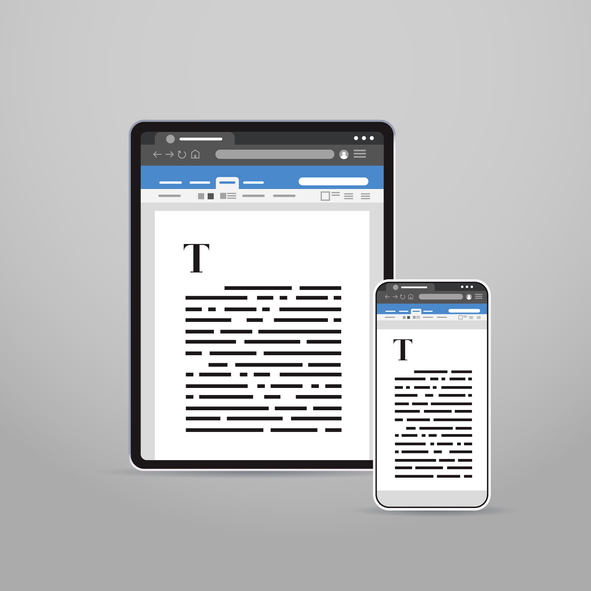
Popular Writing Tools and Software for Authors and Researchers
In this blog, we review some of the common writing tools and software used by writers, and discuss their pros and cons in detail.


Top Research Tools and Software for Academics and Research Students
In this blog, we review some of the useful tools for research that researchers can use to be more productive.
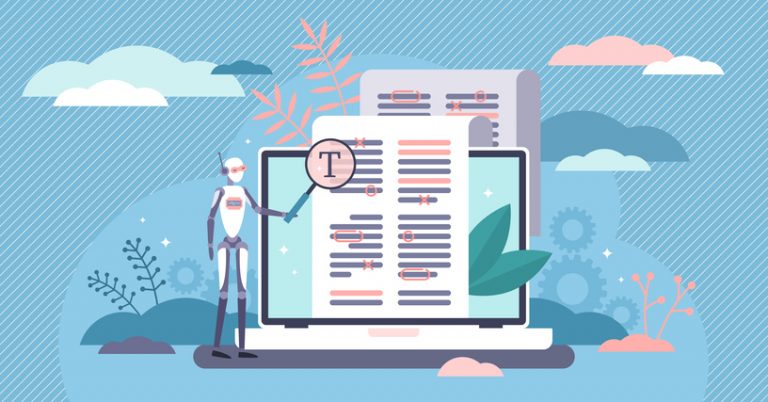
Scholarly Paraphrasing Tool and Essay Rewriter for Rewording Academic Papers
In the blog, we focus on academic and scientific paraphrasing software tools that help students to rewrite their essay into an academically acceptable format.
Very nice, very comprehensive
- Pingback: Algunos recursos para el inicio de curso I | Ferran Escrivà Llorca
Highly educative, and informative beside I appreciate your blogs post.
YOUR ARTICLE IS HIGHLY HELPFUL AND VERY INFORMATIVE
NICE BLOG THANKS FOR HELPING
There is also Refereed.com. It has either reference management or collaborative writing in real-time. And It is free.
Good blog, thanks for to compile my intention of materials.
- Pingback: Research Paper Structure – Main Sections and Parts of a Research Paper
Really informative blog
Leave a Reply Cancel reply
Your email address will not be published. Required fields are marked *
Save my name, email, and website in this browser for the next time I comment.
- 12 Share Facebook
- 4 Share Twitter
- 8 Share LinkedIn
- 10 Share Email

The best AI tools for research papers and academic research (Literature review, grants, PDFs and more)
As our collective understanding and application of artificial intelligence (AI) continues to evolve, so too does the realm of academic research. Some people are scared by it while others are openly embracing the change.
Make no mistake, AI is here to stay!
Instead of tirelessly scrolling through hundreds of PDFs, a powerful AI tool comes to your rescue, summarizing key information in your research papers. Instead of manually combing through citations and conducting literature reviews, an AI research assistant proficiently handles these tasks.
These aren’t futuristic dreams, but today’s reality. Welcome to the transformative world of AI-powered research tools!
This blog post will dive deeper into these tools, providing a detailed review of how AI is revolutionizing academic research. We’ll look at the tools that can make your literature review process less tedious, your search for relevant papers more precise, and your overall research process more efficient and fruitful.
I know that I wish these were around during my time in academia. It can be quite confronting when trying to work out what ones you should and shouldn’t use. A new one seems to be coming out every day!
Here is everything you need to know about AI for academic research and the ones I have personally trialed on my YouTube channel.
My Top AI Tools for Researchers and Academics – Tested and Reviewed!
There are many different tools now available on the market but there are only a handful that are specifically designed with researchers and academics as their primary user.
These are my recommendations that’ll cover almost everything that you’ll want to do:
Want to find out all of the tools that you could use?
Here they are, below:
AI literature search and mapping – best AI tools for a literature review – elicit and more
Harnessing AI tools for literature reviews and mapping brings a new level of efficiency and precision to academic research. No longer do you have to spend hours looking in obscure research databases to find what you need!
AI-powered tools like Semantic Scholar and elicit.org use sophisticated search engines to quickly identify relevant papers.
They can mine key information from countless PDFs, drastically reducing research time. You can even search with semantic questions, rather than having to deal with key words etc.
With AI as your research assistant, you can navigate the vast sea of scientific research with ease, uncovering citations and focusing on academic writing. It’s a revolutionary way to take on literature reviews.
- Elicit – https://elicit.org
- Litmaps – https://www.litmaps.com
- Research rabbit – https://www.researchrabbit.ai/
- Connected Papers – https://www.connectedpapers.com/
- Supersymmetry.ai: https://www.supersymmetry.ai
- Semantic Scholar: https://www.semanticscholar.org
- Laser AI – https://laser.ai/
- Inciteful – https://inciteful.xyz/
- Scite – https://scite.ai/
- System – https://www.system.com
If you like AI tools you may want to check out this article:
- How to get ChatGPT to write an essay [The prompts you need]
AI-powered research tools and AI for academic research
AI research tools, like Concensus, offer immense benefits in scientific research. Here are the general AI-powered tools for academic research.
These AI-powered tools can efficiently summarize PDFs, extract key information, and perform AI-powered searches, and much more. Some are even working towards adding your own data base of files to ask questions from.
Tools like scite even analyze citations in depth, while AI models like ChatGPT elicit new perspectives.
The result? The research process, previously a grueling endeavor, becomes significantly streamlined, offering you time for deeper exploration and understanding. Say goodbye to traditional struggles, and hello to your new AI research assistant!
- Consensus – https://consensus.app/
- Iris AI – https://iris.ai/
- Research Buddy – https://researchbuddy.app/
- Mirror Think – https://mirrorthink.ai
AI for reading peer-reviewed papers easily
Using AI tools like Explain paper and Humata can significantly enhance your engagement with peer-reviewed papers. I always used to skip over the details of the papers because I had reached saturation point with the information coming in.
These AI-powered research tools provide succinct summaries, saving you from sifting through extensive PDFs – no more boring nights trying to figure out which papers are the most important ones for you to read!
They not only facilitate efficient literature reviews by presenting key information, but also find overlooked insights.
With AI, deciphering complex citations and accelerating research has never been easier.
- Aetherbrain – https://aetherbrain.ai
- Explain Paper – https://www.explainpaper.com
- Chat PDF – https://www.chatpdf.com
- Humata – https://www.humata.ai/
- Lateral AI – https://www.lateral.io/
- Paper Brain – https://www.paperbrain.study/
- Scholarcy – https://www.scholarcy.com/
- SciSpace Copilot – https://typeset.io/
- Unriddle – https://www.unriddle.ai/
- Sharly.ai – https://www.sharly.ai/
- Open Read – https://www.openread.academy
AI for scientific writing and research papers
In the ever-evolving realm of academic research, AI tools are increasingly taking center stage.
Enter Paper Wizard, Jenny.AI, and Wisio – these groundbreaking platforms are set to revolutionize the way we approach scientific writing.
Together, these AI tools are pioneering a new era of efficient, streamlined scientific writing.
- Jenny.AI – https://jenni.ai/ (20% off with code ANDY20)
- Yomu – https://www.yomu.ai
- Wisio – https://www.wisio.app
AI academic editing tools
In the realm of scientific writing and editing, artificial intelligence (AI) tools are making a world of difference, offering precision and efficiency like never before. Consider tools such as Paper Pal, Writefull, and Trinka.
Together, these tools usher in a new era of scientific writing, where AI is your dedicated partner in the quest for impeccable composition.
- PaperPal – https://paperpal.com/
- Writefull – https://www.writefull.com/
- Trinka – https://www.trinka.ai/
AI tools for grant writing
In the challenging realm of science grant writing, two innovative AI tools are making waves: Granted AI and Grantable.
These platforms are game-changers, leveraging the power of artificial intelligence to streamline and enhance the grant application process.
Granted AI, an intelligent tool, uses AI algorithms to simplify the process of finding, applying, and managing grants. Meanwhile, Grantable offers a platform that automates and organizes grant application processes, making it easier than ever to secure funding.
Together, these tools are transforming the way we approach grant writing, using the power of AI to turn a complex, often arduous task into a more manageable, efficient, and successful endeavor.
- Granted AI – https://grantedai.com/
- Grantable – https://grantable.co/
Best free AI research tools
There are many different tools online that are emerging for researchers to be able to streamline their research processes. There’s no need for convience to come at a massive cost and break the bank.
The best free ones at time of writing are:
- Elicit – https://elicit.org
- Connected Papers – https://www.connectedpapers.com/
- Litmaps – https://www.litmaps.com ( 10% off Pro subscription using the code “STAPLETON” )
- Consensus – https://consensus.app/
Wrapping up
The integration of artificial intelligence in the world of academic research is nothing short of revolutionary.
With the array of AI tools we’ve explored today – from research and mapping, literature review, peer-reviewed papers reading, scientific writing, to academic editing and grant writing – the landscape of research is significantly transformed.
The advantages that AI-powered research tools bring to the table – efficiency, precision, time saving, and a more streamlined process – cannot be overstated.
These AI research tools aren’t just about convenience; they are transforming the way we conduct and comprehend research.
They liberate researchers from the clutches of tedium and overwhelm, allowing for more space for deep exploration, innovative thinking, and in-depth comprehension.
Whether you’re an experienced academic researcher or a student just starting out, these tools provide indispensable aid in your research journey.
And with a suite of free AI tools also available, there is no reason to not explore and embrace this AI revolution in academic research.
We are on the precipice of a new era of academic research, one where AI and human ingenuity work in tandem for richer, more profound scientific exploration. The future of research is here, and it is smart, efficient, and AI-powered.
Before we get too excited however, let us remember that AI tools are meant to be our assistants, not our masters. As we engage with these advanced technologies, let’s not lose sight of the human intellect, intuition, and imagination that form the heart of all meaningful research. Happy researching!
Thank you to Ivan Aguilar – Ph.D. Student at SFU (Simon Fraser University), for starting this list for me!

Dr Andrew Stapleton has a Masters and PhD in Chemistry from the UK and Australia. He has many years of research experience and has worked as a Postdoctoral Fellow and Associate at a number of Universities. Although having secured funding for his own research, he left academia to help others with his YouTube channel all about the inner workings of academia and how to make it work for you.
Thank you for visiting Academia Insider.
We are here to help you navigate Academia as painlessly as possible. We are supported by our readers and by visiting you are helping us earn a small amount through ads and affiliate revenue - Thank you!

2024 © Academia Insider

- [email protected]
- 409.944.1240 (phone)
- 409.220.4855 (text)
- Research & Writing Tools: Home
Related Guides
- Citation
- Plagiarism
- Research Tutorial
Quick Links
A to Z Databases
Book a Study Room
Events and Webinars
Interlibrary Loan Request
Meet With a Librarian
Suggest a Purchase
Testing Center
Virtual Library
Conference Room Reservations
Access Online Resources
Ask-A-Librarian
Career Placement & Tutoring
Frequently Asked Questions
Help & Research Guides
Online Tutorials
Request A Reference Appointment
Research and Writing Tools
If you need help with research for a writing assignment or project, these research and writing tools can be helpful as a part of the research process. The free tools below are used to research credible, scholarly sources, brainstorm, build citations, check for grammar errors, and avoid unintentional plagiarism.
GC Library Databases
- Find the best library databases for research. Galveston College students, faculty, and staff have free access to scholarly, peer-reviewed journal articles.
GC Research Tutorial
- This tutorial is designed to assist you through the various steps of the research process, including identifying and developing a topic, gathering information, finding library resources, and evaluating and citing sources. The numbered tabs to the left represent the research process.
Google Scholar
- A smart tool to help locate credible material for paper and report writing, general research, and other projects.
Purdue Online Writing Lab
- Purdue Online Writing Lab provides instructional material for all aspects of writing and research.
Scribbr Researching, Writing, and Citing Knowledge Base
- Explore hundreds of articles, videos, and other resources about research, writing, and citation.
Citation, Grammar, and Plagiarism
- BibMe helps with citations and checks your paper for grammar errors, missing punctuation, unintentional plagiarism, and more.
GC Library Citation Guide
- This guide will help you learn about APA, Chicago/Turabian, and MLA citation styles. This guide includes tutorials, examples, and other resources to help you with citations.
Grammar Bytes
- Grammar Bytes is for skill development and offers interactive exercises, handouts, videos, and tips.
- Grammarly is a free writing assistant that automatically detects grammar, spelling, punctuation, word choice, and style mistakes in your writing.
Scribbr APA Citation Generator
- The most user-friendly citation tool automatically generates accurate references and in-text citations for free in APA.
Scribbr MLA Citation Generator
- The most user-friendly citation tool automatically generates accurate references and in-text citations for free in MLA.
Scribbr Plagiarism Checker
- Scribbr’s plagiarism checker, powered by Turnitin, detects plagiarism more accurately than other popular tools—particularly when texts are heavily edited.
Brainstorming
- Bubbl.us is a simple and free web application that lets you brainstorm online. The free version includes up to 3 mind maps, image export, and mind map sharing.
MindMeister
- MindMeister brings the concept of mind mapping to the web, using its facilities for real-time collaboration to allow truly global brainstorming sessions. The basic, free version includes up to 3 mind maps, share, collaborate, and import.
- Popplet is a mind-mapping tool that is perfect for visually curating your ideas and brainstorms. The free version allows you to make 1 popplet, access easy-to-use tools, collaborate, and post.
- Last Updated: Dec 5, 2023 10:01 AM
- URL: https://library.gc.edu/research/writing/tools -->
- Print Page -->
Bulk Content Generator
Brand Voice
AI Text Editor
Top AI Tools for Academic Research

Founder, Junia AI

Introduction
Academic research , once a tedious process involving hours spent in libraries and manual data collection, is now increasingly digitized. Technological advancements have made this critical aspect of knowledge generation more efficient and accessible.
One visionary who foresaw this transformation is Bill Gates . Known for his insightful predictions, Gates anticipated that AI-driven software would revolutionize education and academia within a span of 5-10 years. And true to his words, we are witnessing a surge in the use of AI writing tools for academic research.
These AI tools are not just augmenting traditional research methods but are reshaping them altogether. They offer a myriad of benefits like accelerating the pace of research, enhancing accuracy, and democratizing access to academic resources.
In this article, we have compiled a list of the top AI writing tools for academic research. These tools employ natural language processing algorithms to assist researchers in various aspects of the research process, including:
- Generating ideas and outlining papers
- Finding relevant sources
- Proofreading and editing
Best AI Tools For Research: Our Top Picks
thout reading entire text and establishes relationships between concepts across documents. | | 5 | Scite.ai | Analyzes citation patterns in scholarly articles to assess impact/credibility of papers. Categorizes citations as supporting/mentioning/disputing original paper's claims/findings. | | 6 | Research Rabbit | Web app for scientific literature exploration/understanding. Creates organized collections of relevant papers using advanced algorithms analyzing content/metadata (keywords/abstracts/citation networks). | | 7 | Google Scholar | Extensive online repository of scholarly literature across disciplines. Uses AI algorithms to rank documents by relevance and tracks citations to measure impact. | | 8 | Trinka | Improves academic papers' quality by providing feedback on sentence structure, vocabulary usage, overall coherence. |
1. Junia AI
.png?token=eyJhbGciOiJIUzI1NiIsInR5cCI6IkpXVCJ9.eyJ1cmwiOiJ1c2VyLWdlbmVyYXRlZC1pbWFnZXMvZjJmOThkNWUtNjNjNC00MTJiLTkyY2QtZjgyNDI5NTE3YWRkL1NjcmVlbnNob3QgMjAyMy0xMi0xNiBhdCAyMi4yMi40MCAoMSkucG5nIiwiaWF0IjoxNzA5OTM1NzUyLCJleHAiOjIwMjUyOTU3NTJ9.mwSsgMw94c8_U1XaTjDalxtKua8hNbQscZGif0iyTAE)
Junia AI is a leading AI writing tool for academic research, and its citation generator feature is one of its standout offerings. With Junia AI, citing research sources becomes a breeze, saving you time and effort. Let's take a closer look at what makes Junia AI the go-to citation tool for researchers and academicians.
How Junia AI Works
Junia AI utilizes advanced algorithms to simplify the citation process. It has access to a vast database of sources, which allows it to generate accurate citations in various styles such as APA, MLA, and Chicago. Here's how it works:
- Input Source Details: You provide the necessary information about your source, such as author name, publication title, year of publication, etc.
- Select Citation Style: You choose the desired citation style from the available options.
- Generate Citations: Junia AI applies its algorithms to create citations based on the provided details and selected style.
Key Benefits of Using Junia AI
Using Junia AI for your citation needs offers several advantages that can enhance your research process:
1. Time Efficiency
Manually citing sources and formatting reference lists can be time-consuming, especially when dealing with multiple styles. With Junia AI, you can save valuable time by letting the tool handle these tasks for you.
2. Accuracy
Correctly citing your sources is crucial in academic writing as it adds credibility to your work and prevents plagiarism issues. Junia AI's advanced algorithms ensure that your citations are precise and consistent with the chosen style.
3. Ease of Use
Despite its sophisticated features, Junia AI remains user-friendly. Its intuitive interface makes it easy to enter source details, and its ability to generate citations instantly is a boon for researchers working under tight deadlines.
4. Versatility
Whether you're citing a book, a scholarly journal, a website, or any other type of source, Junia AI has got you covered. It supports a wide range of source formats, making it a versatile tool for all your citation requirements.
While Junia AI offers significant benefits for academic writing, it's worth noting that there are other AI-driven tools available to assist you throughout your research journey.
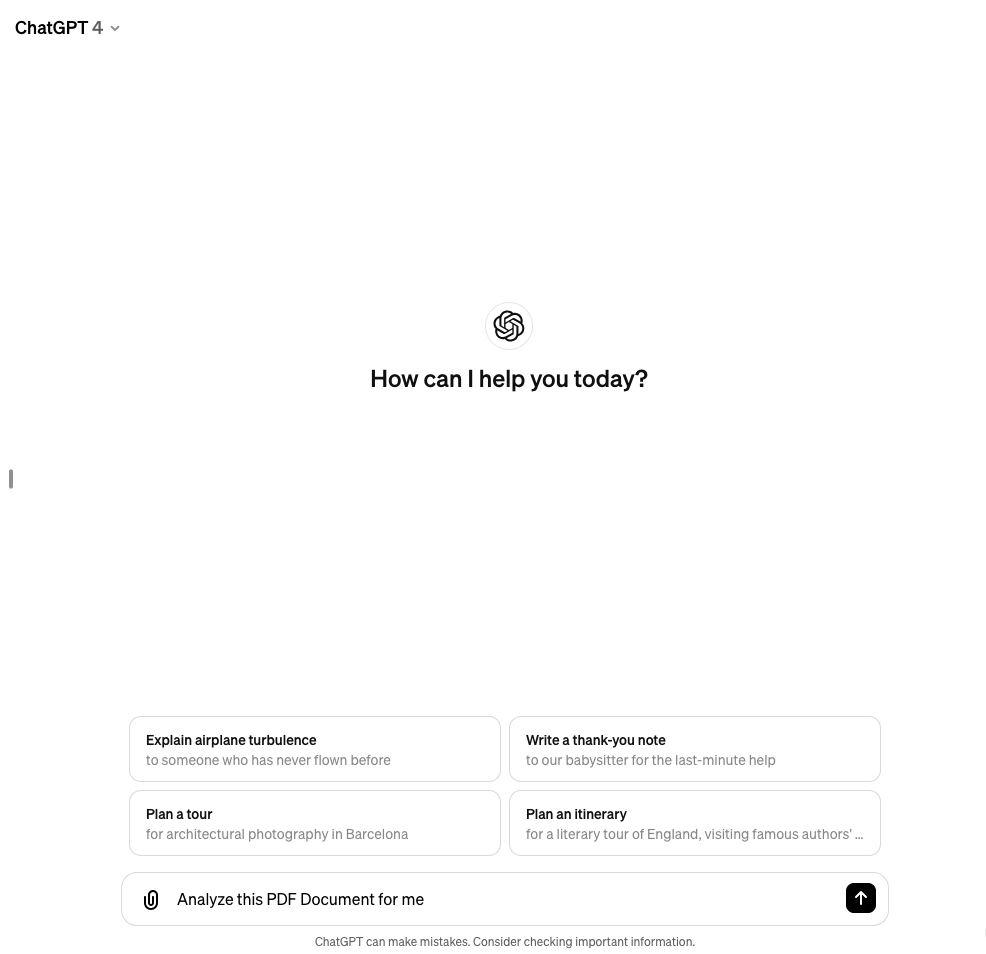
ChatGPT , developed by OpenAI , is an essential tool for academic research. This language model is specifically designed for generating text, making it a valuable assistant for scholars and researchers.
The Power of Incremental Prompting
The key feature of ChatGPT that resonates with academia is its incremental prompting feature. Incremental prompting allows researchers to create detailed outlines for their journal articles or research papers. With this feature, you can provide the model with a series of related prompts one by one, and it will respond accordingly. This step-by-step approach leads to more coherent and detailed responses.
This capability not only simplifies the writing process but also makes it more structured and organized. It's like having an intelligent assistant that helps you arrange your thoughts and ideas into well-defined sections or chapters of the research document.
Versatility in Document Handling
One of the strengths of ChatGPT lies in its ability to work with different types of documents. It can browse the web, interact with files (including PDFs and other formats), making it convenient for users to access various sources during their research work.
This ability is particularly useful when dealing with large PDF files or complex documents where finding relevant information can be challenging. With ChatGPT, you can simply upload your file, ask specific questions about its content, and get precise answers instead of having to read through the entire document.
Case Study: Stanford University
Let's look at an example from Stanford University where ChatGPT was tested by students and professors . They used this AI tool as part of their academic writing process - from generating ideas to creating outlines for journal articles.
- In one instance, a PhD student working on a paper about AI ethics used ChatGPT to generate an outline for his document. He started with a broad prompt on AI ethics which yielded a general response from the model. He then gradually added more specific prompts, leading the model to generate a detailed and organized outline of the paper.
- In another case, a professor at Stanford used ChatGPT for preparing his lectures. He would prompt the model with a topic he planned to teach and based on the generated responses, he would create an outline for his lecture.
These real-life examples demonstrate the effectiveness of ChatGPT in academic writing. It's not just about easing the writing process but also enhancing it by providing a new way to structure your thoughts, ideas, and findings. As Bill Gates predicted, AI-driven software like ChatGPT is indeed revolutionizing education and academia.
From these examples and many more, it is clear that using an AI tool like ChatGPT can significantly improve the academic writing process. By providing structure to your work, generating ideas, and making information retrieval easier, such tools are proving to be game-changers in academic research.
3. Consensus

Consensus is a specialized search engine designed for academics, leveraging advanced Artificial Intelligence to provide accurate and concise summaries of peer-reviewed articles.
How Consensus Works
The power of Consensus lies in its AI algorithms, which analyze the content of papers to extract key information. This makes it more than just a regular search engine - it's a tool that can distill complex academic papers into easy-to-understand summaries.
Why Choose Consensus?
When it comes to finding relevant sources for your research, Consensus offers several advantages over traditional search engines:
Features of Consensus
- Summarized Evidence : Consensus provides summarized evidence from peer-reviewed literature, allowing you to quickly grasp the main points of a paper without reading the entire document.
- AI-Powered Search Engine : Unlike keyword-based search engines, Consensus understands the context and relevance of your query, delivering more precise results.
- User-Friendly Interface : With its simple yet efficient interface, Consensus makes it easy for you to navigate the platform and find what you need.
Benefits of Using Consensus
Using Consensus during the literature review stage of your academic research projects can bring several benefits:
- Efficient Information Retrieval : By providing concise summaries of peer-reviewed articles, Consensus helps you save time during the literature review process.
- Access to Quality Sources : As Consensus focuses on peer-reviewed literature, using it ensures that you're accessing reliable and academically sound sources.
- Time-Saving : Thanks to its AI-powered search engine, Consensus delivers relevant results quickly, allowing you to work more efficiently.
- Improved Understanding : The summarized evidence provided by Consensus can enhance your understanding of the topic at hand, making your research more comprehensive.
- Ease of Use : With its user-friendly interface and straightforward functionality, Consensus is a tool that seamlessly integrates into your academic writing workflow.
Consensus serves as an example of how AI can transform the way academic research is conducted. As we embrace the digital age, tools like Consensus are becoming essential for researchers in various fields. By harnessing the power of AI, Consensus paves the way for more efficient and effective academic research, allowing you to focus on what truly matters - creating impactful knowledge.
4. Elicit.org
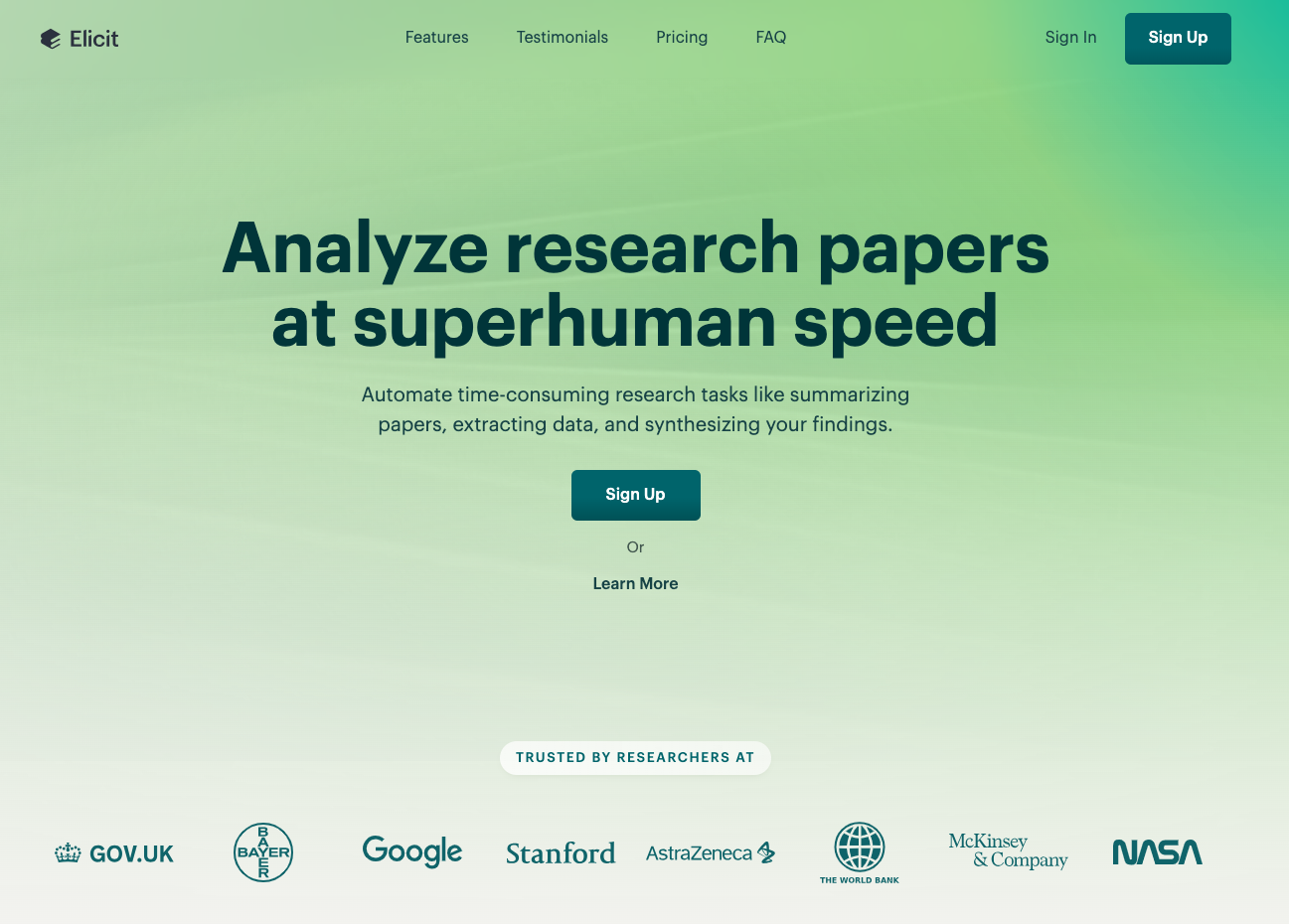
Elicit.org is an AI-powered tool designed to streamline the research process by assisting in conducting comprehensive literature reviews and extracting relevant data from various sources. It is one of the top AI writing tools for academic research that has been embraced by researchers worldwide.
How Elicit.org Works
The power of Elicit lies in its sophisticated algorithms that analyze the content of documents. These algorithms are capable of identifying key concepts, relationships, and findings within a sea of information. This feature allows users to gain valuable insights for their own research projects in a fraction of the time it would take manually.
Key Features of Elicit.org
Identifying key concepts.
Elicit's AI is programmed to identify and highlight key concepts within a text. This gives you an immediate grasp of the main ideas within a document without having to read it in its entirety.
Establishing Relationships
Another significant feature of Elicit.org is its ability to establish relationships between different documents or concepts. This helps to build a comprehensive understanding of the subject matter.
Extracting Findings
Finally, it can extract critical findings from research papers, providing you with specific data points that may be relevant to your research.
The practical applications of these features are numerous. For instance, if you were conducting a literature review on climate change, Elicit.org could:
- Analyze hundreds of papers
- Identify the key concepts such as 'global warming', 'carbon emissions', 'deforestation', etc.
- Establish relationships between these concepts across different papers
- Extract critical data points like specific carbon emission figures.
Try Elicit.org for Your Research
Elicit.org has truly revolutionized the way researchers approach literature review and data extraction, making it a crucial AI tool for academic research. By integrating Elicit.org into your research workflow, you can leverage its AI capabilities to make your research process more efficient and effective.
5. Scite.ai
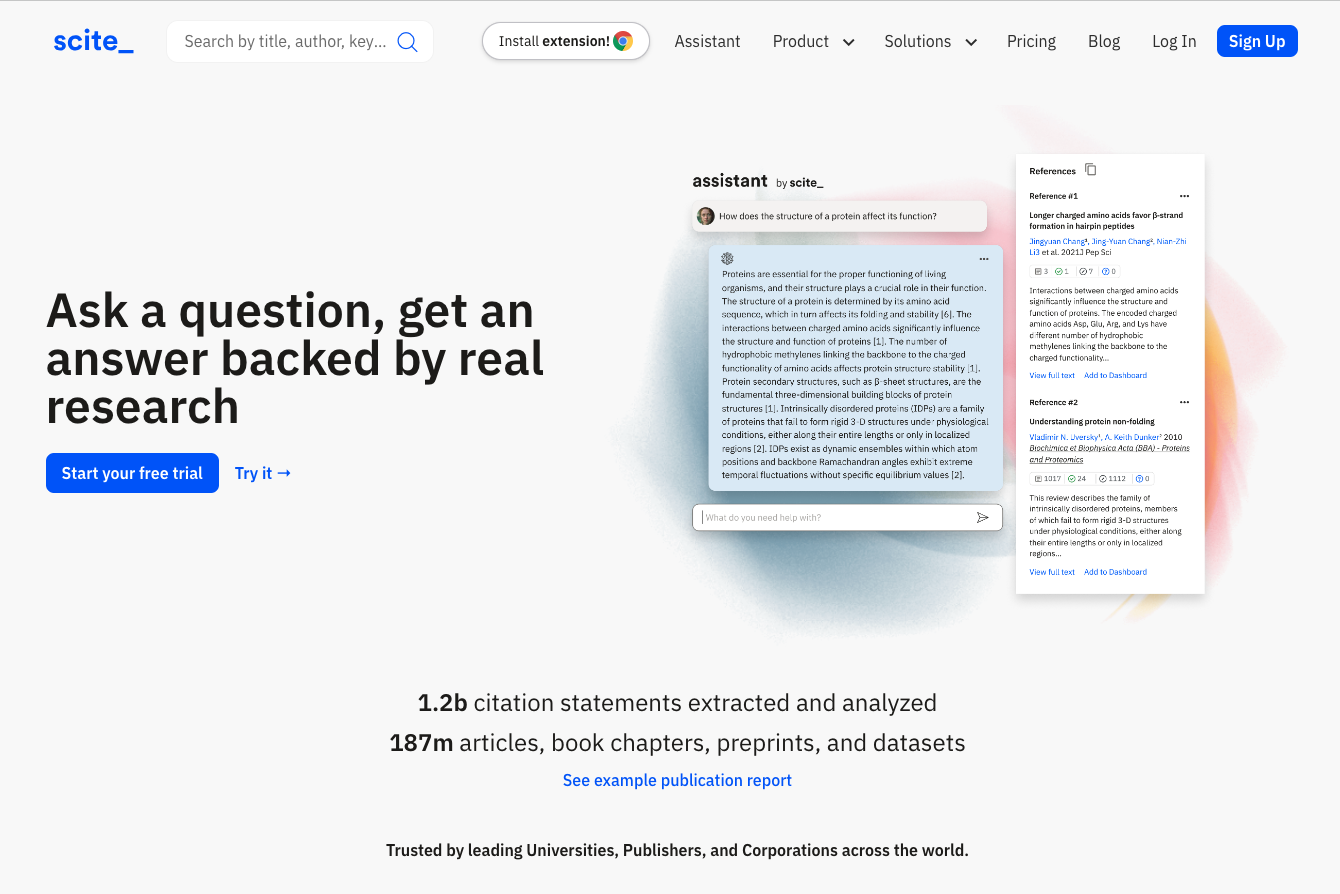
Scite.ai , a unique platform that stands out in its approach to enhancing the credibility of research.
Beyond Traditional Citation Tools
Scite.ai is not just a citation tool; it uses artificial intelligence to analyze citation patterns in scholarly articles meticulously. This insightful analysis offers users contextual information about how particular studies have been cited by other researchers. It's like having an intelligent assistant who can tell you not just who is citing your work, but also how and why they are citing it.
How Does Scite.ai Enhance Research Validation?
The primary focus of Scite.ai is on research validation. This is where the tool truly shines. In simple terms, Scite.ai helps scholars assess the impact and credibility of published papers more effectively. Its underlying AI technology sifts through the multitude of citations associated with any article, cutting through the noise to provide meaningful insights. It uses these insights to determine whether a paper has been positively or negatively received, based on the context within which it has been cited in subsequent works.
But how does this work?
Scite.ai takes each citation and breaks it down into three categories:
- Supporting : The citing work provides evidence in favor of the assertions made in the original paper.
- Mentioning : The citing work refers to the original paper but does not explicitly support or dispute its content.
- Disputing : The citing work challenges or contradicts the findings or claims made in the original paper.
This categorization gives a clear snapshot of how other researchers view your study, which can be invaluable when assessing its impact and validity.
Benefits of Using Scite.ai for Academic Writing
Incorporating Scite.ai into your academic writing process comes with several potential benefits:
- Strengthening Arguments : Knowing how others perceive your references can help you build stronger arguments by choosing sources that have been widely accepted and supported.
- Supporting Claims : Scite.ai gives you an edge by letting you back up your claims with references that have been positively cited in other works.
- Enhancing Credibility : A paper that includes well-regarded sources increases its credibility in the academic community, potentially leading to more citations and higher impact.
Understanding the Context of Citations
Scite.ai's approach to assessing the impact of papers does not stop at categorization. It also provides a 'citation statement', which is a brief excerpt from the citing text. This allows users to understand the context and rationale of the citation without having to read through the entire citing article.
For example, if a researcher is writing about climate change and selects a paper as a reference, Scite.ai not only shows how many times the paper has been cited but also provides an overview of whether these citations are supporting, mentioning or disputing it. This information paints a more in-depth and detailed picture of how the chosen paper has been received by the scientific community.
The Power of Scite.ai for Scholars
In essence, Scite.ai is a powerful ally for any scholar. It provides unique insights into citation patterns, enabling users to make informed decisions about which sources to use and how to present their arguments effectively. The ability to validate research, bolster arguments, and enhance credibility makes Scite.ai an indispensable tool in today's digital age where academic integrity is paramount.
6. Research Rabbit
Research Rabbit is an innovative AI tool designed to assist with exploring and understanding scientific literature. It's a web application that helps researchers navigate through scientific literature, enabling them to create organized collections of pertinent papers.
Utilizing advanced algorithms, Research Rabbit analyzes both content and metadata of articles. The analysis allows the application to suggest related works, providing researchers with new perspectives and connections they might have overlooked.
How Does Research Rabbit Work?
Research Rabbit employs AI algorithms to scrutinize the content and metadata of articles. This process includes evaluating keywords, abstracts, author affiliations, citation networks, and even figures and tables within the paper. This comprehensive approach provides a deeper understanding of the article's context and relevance.
The system then recommends other relevant articles based on its analysis. This feature aids researchers in uncovering new links between studies and gaining interdisciplinary insights.
Benefits of Using Research Rabbit
The use of Research Rabbit can bring multiple benefits to both novice and experienced researchers:
- Keeping Up With Latest Developments : The rapid pace at which new research papers are published makes it challenging for researchers to stay updated. Research Rabbit addresses this issue by providing recommendations based on recent publications related to their chosen topics.
- Identifying Research Gaps : By reviewing related papers suggested by Research Rabbit, researchers can identify gaps in current knowledge and thereby find opportunities for novel research.
- Improving Efficiency : Instead of manually searching for relevant studies, researchers can rely on Research Rabbit's AI-powered suggestions, saving valuable time.
- Enhancing Understanding : By presenting different perspectives on a topic through related works, Research Rabbit fosters a more comprehensive understanding of the subject matter.
To illustrate this process, consider a researcher studying climate change's impact on agriculture. After inputting their research papers into Research Rabbit, the application might suggest articles about innovative farming practices in response to climate change or economic studies on how climate change affects agricultural markets. These suggestions can lead the researcher to consider new angles for their work, promoting a more nuanced and complete analysis.
Research Rabbit represents a significant advancement in AI writing tools for academic research. Its ability to analyze literature and suggest related works enables researchers to delve deeper into their topics, discover new perspectives, and stay abreast of the latest developments in their field. By harnessing this technology, researchers can enhance the depth and breadth of their studies while improving their productivity.
7. Google Scholar
Google Scholar , a well-known platform for academic research, is an extensive online collection of scholarly literature across various fields. It has become an essential tool in the academic world because of its vast collection of research articles, conference papers, theses, books, and patents from professional societies, online repositories, universities, and other scholarly organizations.
Google Scholar uses advanced AI algorithms to rank documents based on their relevance, considering factors such as the full text of each document, where it was published, who authored it, and how frequently and recently it has been cited in other literature. As a result, researchers can access a wide range of scholarly content that might not be available through other search engines.
Finding Relevant Sources with Google Scholar
When doing academic research, the challenge often lies not in finding information but in finding relevant information. By using Google Scholar 's advanced search features effectively, you can overcome this challenge.
General Search
Simply enter your keywords into the search bar for a list of relevant resources.
Advanced Search
Click on the menu icon on the top left of the page and select "Advanced Search" for more specific queries. You can:
- Search for exact phrases
- Exclude certain words
- Search within specific publications or authors
Author Verification
If you're searching for articles from a particular author, make sure that they have verified their Google Scholar profile to avoid confusion with authors having similar names.
Tracking Citations: Measure Your Impact
One of the unique features of Google Scholar is its citation tracking capability. This feature allows researchers to measure the impact and influence of their work within the academic community.
This link under each result shows how many times an article has been cited by other papers indexed on Google Scholar . It's a helpful indicator of an article's influence or importance in a field.
Google Scholar Citations
This feature lets authors track citations to their articles. You can check who is citing your publications, graph citations over time, and compute several citation metrics.
Tips and Strategies: Maximizing Google Scholar's Effectiveness
The value derived from Google Scholar largely depends on how effectively you use its features. Here are some strategies to enhance your academic writing endeavors:
- Refine Your Search : Use boolean operators like AND, OR, NOT, "", and - to narrow or broaden your search.
- Personalized Updates : Set up alerts for new content that matches your specified criteria (such as author or keyword). This helps you stay updated with the latest research in your field of interest.
- Export Citations : Google Scholar allows you to export citations in various formats (like BibTeX, EndNote, RefMan, or RefWorks) which can be directly imported into your reference management software.
Google Scholar is considered one of the most powerful academic search engines available. Its comprehensive database coupled with advanced AI algorithms makes it an invaluable tool for academic research. By understanding its features and learning how to leverage them effectively, you can streamline your academic writing process and produce well-researched scholarly work.
Trinka is an advanced writing assistant powered by AI that aims to improve the quality of academic papers. It provides researchers with valuable feedback and suggestions to refine their writing style and eliminate grammatical errors.
How Does Trinka Help Improve Your Writing?
Trinka uses advanced algorithms to analyze your text thoroughly, focusing on three main areas:
1. Sentence Structure
Trinka examines each sentence in your paper for clarity, coherence, and conciseness. It suggests revisions to make your writing easier to understand.
2. Vocabulary Usage
The tool identifies complex or inappropriate words in your writing and suggests simpler alternatives.
3. Overall Coherence
Trinka evaluates the logical flow of ideas and arguments throughout your paper, highlighting areas that may need further explanation or reorganization.
By addressing these aspects, Trinka helps you create a well-written academic paper with a strong foundation.
"Trinka is more than just a grammar-checking tool. It is a smart companion that understands the nuances of academic writing and can assist you in producing high-quality papers.
The Power of AI Writing Tools for Academic Research
With the rapid advancements in technology, an important shift has taken place in the academic research arena. The emergence of AI writing tools for academic research has become a game-changer, improving both efficiency and quality in research efforts. These tools offer a wide range of capabilities that can help at every stage of the academic writing process.
Adapting to Technological Advancements
The world of academia is changing quickly. Researchers now need to keep up not only with developments in their own fields but also with broader technological trends that could affect their work. This includes embracing advancements like AI, which can greatly enhance research endeavors.
One example of this is Scite.ai . This platform uses AI to analyze citation patterns in scholarly articles, giving users contextual information about how a particular study has been cited by other researchers. This approach to research validation can help scholars better understand the impact and reliability of published papers. By using such tools, researchers can strengthen their arguments and support claims with trustworthy references, thereby improving the credibility of their work.
Experimenting with AI Tools
Innovation is key in academic research. That's why it's crucial for researchers to constantly explore and experiment with new methods and technologies that can enhance their work. This includes trying out various AI writing tools mentioned in this article.
For instance, you might want to consider using Research Rabbit for exploring scientific literature and creating organized collections of relevant papers. Its algorithms analyze the content and metadata of articles to suggest related works, enabling you to discover new connections and interdisciplinary perspectives. Such tools not only streamline your literature review process but also inspire new research directions.
The Future is Here
These AI writing tools are not just about keeping up with technological advancements; they are about embracing the future of academic research. As researchers, it's important for us to adapt and evolve alongside these changes, integrating technology into our workflows to improve efficiency and enhance the quality of our work.
- The Cancer Researcher Podcast
- Sign up to our newsletter
- EACR website
Productivity Tools for Research Writing

By Oluchi Okere
Productivity is a measure of the efficiency of a productive process and is determined by the rate of output per unit input. Productivity is associated with yield, efficiency and prolificity . Ever heard the axiom, work smart not hard! Indeed, access to and availability of productivity tools gives the task manager an opportunity to achieve goals smartly.
I have listed in this post some productivity tools that should make your writing up process not only less time-consuming but also more interesting and much easier. With productivity tools one should be able to manage the workflow of tasks more efficiently and even in some cases automatically. With the increasing application of AI to the design of research tools, apps have become more intelligent and exciting to use!
You might need to invest some time and data into learning how to use some of the tools. YouTube and blogs are replete with tutorials that should help any serious user understand how to use these tools effectively. Many of the tools have very gentle learning curves, meaning you can adjust to their use with very little practice.
Many of these tools are free while some have non-premium (but perhaps limited) and / or trial versions that can be used until a decision to pay for a premium version is made. A wise combination of these tools should boost your productivity as a researcher.
Reference Managers / Citation Managers
Collect, organize and reference your sources with ease and in various styles such as APA, MLA, Havard etc. with reference management tools. The most prominent in this class of productivity tools are Zotero and Mendeley . Others are Citavi , RefWorks and EndNote . Mendeley is excellent at capturing metadata from PDFs automatically. There are also citation generators /citation trackers like ZoteroBib and Cite This For Me (these can be used without creating an account). Check out this excellent resource A brief guide to using Mendeley as a reference and citation manager as an aid to write scholarly papers by Dr. Raul Pacheco-Vega which provides some clarification for Mendeley use. Say goodbye to the frustrating task of producing your paper reference at snail pace!
Grammar Checkers and spelling checkers
These tools help with proofreading and help detect spelling, grammar and punctuation mistakes. Prominent grammar checkers include Grammarly , ProWritingAid , HemmingwayApp . Hemmingway App highlights lengthy, complex sentences and common errors providing greater clarity to writing.
Focused/ Distraction free writing Apps
The first category of this group are daily habit tracking apps that keep the writer accountable to writing a certain number of words on a daily basis (usually a 750 daily word challenge). They include popular ones like 750Words , WriteHoney , 3Pages . The second category of these tools provide a minimalist distraction and cluster free interface that allows the writer focus on the immediate task of writing. Blindwrite, Ommwriter , Poe , FocusWriter are the commonest.
Database of links /full text and open access sources
Academic Microsoft , Paperity , BASE , DOAJ and Zenodo are databases and repositories for open access content. Unpaywall , LazyScholar , GoogleScholar provide links / are browser plugins that automatically locate an open version of any article.
Cloud Storage and collaboration tools
Cloud storage tools like Dropbox , Google Drive and OneDrive help store documents for backup or for easy access from any other device or location. GoogleDocs and Microsoft Word Online are good for collaborative writing/research. Team members can create, store, share and track their work remotely.
Visual literature search tools
To scope and map the literature/ find relevant sources on a particular concept, Connected Papers , Open Knowledge Maps and ResearchRabbit provide a visual map to guide the researcher. Information provided include prior and previous / cited and cited by works related to a given citation.
Mind mapping tools
Mind mapping and brainstorming are very useful during the conceptualization stage of research writing. It helps with organizing, outlining and planning of writing. Some popular ones used by researchers are: MindMeister , MindMup , bubbl.us and Coggle . Mindmeister advises “If you’ve been staring at a blank page for ages, try starting the writing process with a mind map instead. Mind mapping helps you plan and develop your ideas, eliminating writers block in the process”.
Notetaking / Planning / Project Management/Collaboration Apps
Workflowy , Notion and Roam Research stand out for planning stages of the research work. In fact, these tools are too complex to fit into one category as they have multiple uses including collaboration functions.
Outline and planning
Manuscripts.app helps with the workflow of writing a manuscript from planning/outlining/formatting to submission. The App walks the writer from the abstract though to the conclusion section of the paper. Cut through your writer’s block incisively with Manuscripts.app.
Knowledge Organisation
Citavi is not only great for reference management, it also supports knowledge organisation and task planning. Create a near complete paper “in a twinkling of an eye” by using the Knowledge organization tool of Citavi. The carefully annotated notes and tags become the “skeleton” of the paper. RAx is a for Literature analysis and comprehension tool. RAx analyses an imported document with its AI capability to find the “important” sections to be extracted as the necessary information for citation in a “project”.
In conclusion, productive researchers measure their results, not their time! Keep working smarter!
About the Author
Contact: Twitter | LinkedIn
This article was originally written by Oluchi Okere for her site ‘The Productive Researcher’s Hub’ In October 2020, and has been republished here with permission.
Related articles more from author.

Interview Tips from the Experts: Episode 12 of The Cancer Researcher Podcast

“I found my perfect environment”: EACR member answers your questions about working in industry

The role of TRAIL in premetastatic niche formation in breast cancer – Episode 11 of The Cancer Researcher Podcast
Who are we.
The Cancer Researcher is an online magazine for the cancer research community from the European Association for Cancer Research (EACR).
Sign up for the EACR's email newsletter for cancer researchers, usually sent every 2 weeks.
More articles

“I have been offered the chance to return for postdoctoral studies”...

“One of the career steps for a predoctoral student should be...

A Day in the Life: “It is a very rewarding job”

Advice on Standing Out as a Speaker

Love and fear in the lab: watch the EACR25 Opening Lecture...

Research Writing and Analysis
- NVivo Group and Study Sessions
- SPSS This link opens in a new window
- Statistical Analysis Group sessions
- Using Qualtrics
- Dissertation and Data Analysis Group Sessions
- Defense Schedule - Commons Calendar This link opens in a new window
- Research Process Flow Chart
- Research Alignment Chapter 1 This link opens in a new window
- Step 1: Seek Out Evidence
- Step 2: Explain
- Step 3: The Big Picture
- Step 4: Own It
- Step 5: Illustrate
- Annotated Bibliography
- Literature Review This link opens in a new window
- Systematic Reviews & Meta-Analyses
- How to Synthesize and Analyze
- Synthesis and Analysis Practice
- Synthesis and Analysis Group Sessions
- Problem Statement
- Purpose Statement
- Conceptual Framework
- Theoretical Framework
- Quantitative Research Questions
- Qualitative Research Questions
- Trustworthiness of Qualitative Data
- Analysis and Coding Example- Qualitative Data
- Thematic Data Analysis in Qualitative Design
- Dissertation to Journal Article This link opens in a new window
- International Journal of Online Graduate Education (IJOGE) This link opens in a new window
- Journal of Research in Innovative Teaching & Learning (JRIT&L) This link opens in a new window
What is an Annotated Bibliography?
An annotated bibliography is a summary and evaluation of a resource. According to Merriam-Webster, a bibliography is “the works or a list of the works referred to in a text or consulted by the author in its production.” Your references (APA) or Works Cited (MLA) can be considered a bibliography. A bibliography follows a documentation style and usually includes bibliographic information (i.e., the author(s), title, publication date, place of publication, publisher, etc.). An annotation refers to explanatory notes or comments on a source.
An annotated bibliography, therefore, typically consists of:
Documentation for each source you have used, following the required documentation style.
For each entry, one to three paragraphs that:
Begins with a summary ,
Evaluates the reliability of the information,
Demonstrates how the information relates to previous and future research.
Entries in an annotated bibliography should be in alphabetical order.
** Please note: This may vary depending on your professor’s requirements.
Why Write an Annotated Bibliography?
Why Write an Annotated Bibliography
Writing an annotated bibliography will help you understand your topics in-depth.
An annotated bibliography is useful for organizing and cataloging resources when developing an argument.
Formatting an Annotated Bibliography
Formatting Annotated Bibliographies
- Use 1-inch margins all around
- Indent annotations ½ inch from the left margin.
- Use double spacing.
- Entries should be in alphabetical order.
Structure of an Annotated Bibliography
This table provides a high-level outline of the structure of a research article and how each section relates to important information for developing an annotated bibliography.
Annotated Bibliography Sample Outline
Author, S. A. (date of publication). Title of the article. Title of Periodical, vol. (issue), page-page. https://doi.org/XXXXXX
Write one or two paragraphs that focus on the study and its findings.
- Two or more sentences that outline the thesis, hypothesis, and population of the study.
- Two or more sentences that discuss the methodology.
- Two or more sentences that discuss the study findings.
- One or more sentences evaluating the study and its relationship to other studies.
Sample Annotated Bibliographies

Student Experience Feedback Buttons
Was this resource helpful.
- << Previous: Step 5: Illustrate
- Next: Literature Review >>
- Last Updated: May 16, 2024 8:25 AM
- URL: https://resources.nu.edu/researchtools


Cara Menulis Makalah Penelitian
- Tim Redaksi Smodin
- Diperbarui: 17 Mei 2024
Kebanyakan siswa benci menulis makalah penelitian. Prosesnya seringkali terasa lama, membosankan, dan terkadang sangat membosankan. Meskipun demikian, tugas-tugas ini penting untuk perjalanan akademis siswa. Ingin mempelajari cara menulis makalah penelitian yang menangkap kedalaman subjek dan mempertahankan minat pembaca? Jika demikian, panduan ini cocok untuk Anda.
Hari ini, kami akan menunjukkan cara menyusun makalah penelitian yang terorganisir dengan baik untuk membantu Anda mendapatkan nilai. Anda dapat mengubah topik apa pun menjadi makalah penelitian yang menarik dengan pendekatan penelitian yang bijaksana dan argumen yang persuasif.
Dalam panduan ini, kami akan memberikan tujuh tip sederhana namun praktis untuk membantu mengungkap proses dan memandu Anda dalam perjalanan. Kami juga akan menjelaskan bagaimana alat AI dapat mempercepat proses penelitian dan penulisan sehingga Anda dapat fokus pada pemikiran kritis.
Di akhir artikel ini, Anda akan memiliki peta jalan yang jelas untuk menangani esai ini. Anda juga akan belajar cara mengatasinya dengan cepat dan efisien. Dengan waktu dan dedikasi, Anda akan segera menguasai seni menulis makalah penelitian.
Siap untuk mulai?
Apa Itu Makalah Penelitian?
Makalah penelitian adalah esai komprehensif yang memberikan analisis, interpretasi, atau argumen terperinci berdasarkan penelitian independen Anda sendiri. Dalam lingkungan akademis tingkat tinggi, hal ini lebih dari sekedar ringkasan sederhana dan mencakup penyelidikan mendalam terhadap topik atau topik.
Istilah “makalah penelitian” adalah istilah luas yang dapat diterapkan pada berbagai bentuk penulisan akademis. Tujuannya adalah untuk menggabungkan pemikiran Anda dengan temuan dari literatur ilmiah yang ditinjau oleh rekan sejawat.
Pada saat esai Anda selesai, Anda seharusnya sudah memberikan perspektif baru kepada pembaca atau menantang temuan yang sudah ada. Ini menunjukkan penguasaan Anda terhadap subjek tersebut dan berkontribusi pada perdebatan ilmiah yang sedang berlangsung.
7 Tips Menulis Makalah Penelitian
Seringkali, memulai adalah bagian tersulit dalam sebuah makalah penelitian. Meskipun prosesnya tampak sulit, memecahnya menjadi langkah-langkah yang dapat dikelola dapat mempermudah pengelolaannya. Berikut ini adalah tujuh tip untuk mewujudkan ide-ide Anda.
1. Pahami Tugas Anda
Ini mungkin terdengar sederhana, namun langkah pertama dalam menulis makalah penelitian yang sukses adalah membaca tugasnya. Duduklah, luangkan waktu sejenak, dan ikuti instruksinya sehingga Anda sepenuhnya memahami tugas Anda.
Salah menafsirkan tugas tidak hanya membuang-buang waktu tetapi juga memengaruhi nilai Anda. Tidak peduli seberapa sabarnya guru atau profesor Anda, mengabaikan instruksi dasar sering kali tidak dapat dimaafkan.
Jika Anda sudah membaca petunjuknya dan masih bingung, mintalah klarifikasi sebelum Anda mulai menulis. Jika itu tidak memungkinkan, Anda dapat menggunakan alat seperti Obrolan AI Smodin untuk membantu. Smodin dapat membantu menyoroti persyaratan penting yang mungkin Anda abaikan.
Investasi awal ini memastikan bahwa semua upaya Anda di masa depan akan terfokus dan efisien. Ingat, berpikir sama pentingnya dengan menulis esai, dan hal ini juga dapat membuka jalan bagi proses penulisan yang lebih lancar.
2. Mengumpulkan Bahan Penelitian
Sekarang sampai pada bagian yang menyenangkan: melakukan penelitian. Saat Anda mengumpulkan bahan penelitian, selalu gunakan sumber yang kredibel, seperti jurnal akademis atau makalah yang ditinjau oleh rekan sejawat. Hanya gunakan mesin pencari yang memfilter sumber terakreditasi dan database akademis sehingga Anda dapat memastikan informasi Anda dapat diandalkan.
Untuk mengoptimalkan waktu Anda, Anda harus belajar menguasai seni skimming. Jika suatu sumber tampak relevan dan berharga, simpanlah dan tinjau lagi nanti. Hal terakhir yang ingin Anda lakukan adalah membuang waktu pada materi yang tidak akan masuk ke makalah akhir.
Untuk lebih mempercepat proses, pertimbangkan untuk menggunakan Rangkuman AI Smodin . Alat ini dapat membantu meringkas teks berukuran besar, menyoroti informasi penting yang relevan dengan topik Anda. Dengan mengumpulkan dan mengajukan bahan penelitian secara sistematis di awal proses penulisan, Anda membangun landasan yang kuat untuk tesis Anda.
3. Tulis Tesis Anda
Membuat pernyataan tesis yang solid adalah hal terpenting yang dapat Anda lakukan untuk memberikan struktur dan fokus pada makalah penelitian Anda. Tesis Anda harus mengungkapkan poin utama argumen Anda dalam satu atau dua kalimat sederhana. Ingat, saat Anda membuat tesis, Anda menentukan nada dan arah keseluruhan makalah.
Tentu saja, Anda tidak bisa begitu saja menarik tesis pemenang begitu saja. Mulailah dengan melakukan brainstorming ide-ide tesis potensial berdasarkan penelitian pendahuluan Anda. Dan jangan terlalu memikirkan banyak hal; terkadang, ide yang paling lugas sering kali merupakan yang terbaik.
Anda menginginkan tesis yang cukup spesifik agar dapat dikelola dalam lingkup makalah Anda, namun cukup luas untuk memungkinkan diskusi yang unik. Tesis Anda harus menantang ekspektasi yang ada dan memberi pembaca wawasan segar tentang topik tersebut. Gunakan tesis Anda untuk memikat pembaca di paragraf pembuka dan membuat mereka tetap tertarik hingga kata terakhir.
4. Tulis Garis Besar Anda
Garis besar adalah alat yang sering diabaikan namun penting untuk mengatur pemikiran dan menyusun makalah Anda. Banyak siswa yang melewatkan outline karena merasa seperti melakukan pekerjaan ganda, namun outline yang kuat akan menghemat pekerjaan Anda dalam jangka panjang.
Inilah cara menyusun kerangka Anda secara efektif.
- Perkenalkan: Buat daftar pernyataan tesis Anda dan uraikan pertanyaan utama yang akan dijawab oleh esai Anda.
- Tinjauan Literatur: Uraikan literatur utama yang ingin Anda diskusikan dan jelaskan bagaimana kaitannya dengan tesis Anda.
- Metodologi: Jelaskan metode penelitian yang akan Anda gunakan untuk mengumpulkan dan menganalisis informasi.
- Diskusi: Rencanakan bagaimana Anda akan menafsirkan hasil dan implikasinya terhadap tesis Anda.
- Kesimpulan: Ringkaslah konten di atas untuk menjelaskan tesis Anda sepenuhnya.
Untuk lebih menyederhanakan proses ini, pertimbangkan untuk menggunakan Penulis Riset Smodin. Alat ini menawarkan fitur yang memungkinkan Anda membuat dan mengubah kerangka sesuai keinginan Anda berdasarkan masukan awal yang Anda berikan. Anda dapat menyesuaikan kerangka ini agar lebih sesuai dengan temuan penelitian Anda dan memastikan makalah Anda tetap terorganisir dengan baik dan fokus.
5. Tulis Draf Kasar
Setelah kerangka Anda siap, Anda dapat memulai proses penulisan. Ingat, ketika Anda menulis draf kasar, itu tidak dimaksudkan untuk menjadi sempurna. Sebaliknya, gunakanlah hal tersebut sebagai dokumen kerja di mana Anda dapat bereksperimen dan menyusun ulang argumen dan bukti Anda.
Jangan terlalu khawatir tentang tata bahasa, gaya, atau sintaksis saat Anda menulis draf kasar. Berfokuslah untuk menuangkan ide-ide Anda di atas kertas dan keluarkan argumen tesis Anda. Anda selalu dapat menyempurnakan dan mengatur ulang konten di lain waktu.
Ikuti struktur dasar garis besar Anda tetapi dengan kebebasan untuk mengeksplorasi berbagai cara mengekspresikan pemikiran Anda. Penulis Esai Smodin menawarkan solusi ampuh bagi mereka yang kesulitan memulai atau menyusun drafnya.
Setelah Anda menyetujui kerangkanya, Smodin dapat membuat esai berdasarkan masukan awal Anda. Fitur ini dapat membantu Anda dengan cepat membuat draf komprehensif, yang kemudian dapat Anda tinjau dan sempurnakan. Anda bahkan dapat menggunakan kekuatan AI untuk membuat beberapa draf kasar untuk dipilih.
6. Menambah atau Mengurangi Bukti Pendukung
Setelah Anda memiliki draf kasar, tetapi sebelum memulai revisi akhir, inilah waktunya untuk melakukan sedikit pembersihan. Pada fase ini, Anda perlu meninjau semua bukti pendukung Anda. Anda ingin memastikan bahwa tidak ada hal yang berlebihan dan Anda tidak melewatkan detail penting apa pun.
Banyak siswa kesulitan menghitung jumlah kata yang diperlukan untuk sebuah esai dan terpaksa mengisi tulisan mereka dengan pernyataan yang berlebihan. Daripada menambahkan konten yang tidak perlu, fokuslah untuk memperluas analisis Anda untuk memberikan wawasan yang lebih dalam.
Esai yang baik, apa pun topik atau formatnya, perlu disederhanakan. Itu harus menyampaikan informasi yang jelas, meyakinkan, dan relevan yang mendukung tesis Anda. Jika Anda menemukan beberapa informasi tidak berhasil, pertimbangkan untuk mengubah sumber Anda.
Cantumkan berbagai sumber, termasuk kajian, data, dan kutipan dari para sarjana atau pakar lainnya. Ingat, Anda tidak hanya memperkuat argumen Anda tetapi juga menunjukkan kedalaman penelitian Anda.
Jika Anda ingin umpan balik yang komprehensif tentang esai Anda tanpa pergi ke pusat penulisan atau mengganggu profesor Anda, gunakan Smodin. Itu Obrolan AI dapat melihat draf Anda dan menawarkan saran untuk perbaikan.
7. Revisi, Kutip, dan Kirim
Tahap akhir penyusunan makalah penelitian meliputi revisi, kutipan, dan tinjauan akhir. Anda harus memastikan makalah Anda dipoles, disajikan secara profesional, dan bebas plagiarisme. Tentu saja, mengintegrasikan alat AI Smodin dapat menyederhanakan proses ini secara signifikan dan meningkatkan kualitas kiriman akhir Anda.
Mulailah dengan menggunakan alat Penulis Ulang Smodin. Fitur yang didukung AI ini dapat membantu menyusun ulang dan menyempurnakan draf Anda untuk meningkatkan keterbacaan secara keseluruhan. Jika bagian tertentu dari esai Anda “kedengarannya tidak tepat”, AI dapat menyarankan struktur kalimat alternatif dan pilihan kata.
Kutipan yang tepat adalah suatu keharusan untuk semua makalah akademis. Syukurlah, terima kasih Makalah Penelitian Smodin aplikasi, proses yang dulu membosankan ini menjadi lebih mudah dari sebelumnya. AI memastikan semua sumber dikutip secara akurat sesuai dengan panduan gaya yang diperlukan (APA, MLA, Chicago, dll.).
Pemeriksa Plagiarisme:
Semua siswa perlu menyadari bahwa plagiarisme yang tidak disengaja dapat terjadi. Itu sebabnya menggunakan a Pemeriksa Plagiarisme untuk memindai esai Anda sebelum mengirimkannya selalu berguna. Pemeriksa Plagiarisme Smodin dapat menyoroti area yang menjadi perhatian sehingga Anda dapat menyesuaikannya.
Penyerahan Akhir
Setelah merevisi, menyusun ulang, dan memastikan semua kutipan sudah sesuai, gunakan Detektor Konten AI Smodin untuk memberikan makalah Anda ulasan terakhir. Alat ini dapat membantu Anda menganalisis kualitas dan keterbacaan makalah Anda secara keseluruhan sehingga Anda dapat melakukan penyesuaian atau perbaikan akhir.
Menguasai Makalah Penelitian
Menguasai seni makalah penelitian tidak bisa dilebih-lebihkan, baik Anda di sekolah menengah atas, perguruan tinggi, atau studi pascasarjana. Anda dapat dengan percaya diri mempersiapkan makalah penelitian Anda untuk diserahkan dengan memanfaatkan alat AI yang tercantum di atas.
Makalah penelitian membantu menyempurnakan kemampuan Anda untuk berpikir kritis dan menulis secara persuasif. Keterampilan yang Anda kembangkan di sini akan membantu Anda melampaui batas-batas ruang kelas. Mengkomunikasikan ide-ide kompleks dengan jelas dan efektif adalah salah satu alat paling ampuh yang dapat Anda miliki.
Dengan kemajuan alat AI seperti smodin , menulis makalah penelitian menjadi lebih mudah diakses dibandingkan sebelumnya. Teknologi ini menyederhanakan proses pengorganisasian, penulisan, dan revisi pekerjaan Anda. Tulislah dengan percaya diri, karena mengetahui karya terbaik Anda masih akan datang!
The four best AI writing apps worth a try
Suswati Basu is a multilingual, award-winning editor and the founder of the intersectional literature channel, How To Be Books. She was shortlisted for the Guardian…

AI tools like ChatGPT are revolutionizing writing, aiding in document creation and streamlining work processes.
Human oversight remains crucial to ensure accuracy and prevent AI-generated content from being too generic or erroneous.
Various AI writing apps, such as Copy.ai, Anyword, Writesonic, and Rytr, offer different features and pricing plans to cater to diverse needs.
Whatever the industry, more and more people are using artificial intelligence to assist with their work, especially since the launch of ChatGPT . Many workers and students now use the tool to write documents, essays, and more. It often speeds up the process of creating content and managing the mundane aspects of work. While they aren’t taking over the world yet, they are quickly evolving and have reached a stage where they can be useful, at least in the right circumstances.
Of course, all AI writing software requires some level of human oversight to achieve the best results. Without it, the software can generate content that is rather generic or even hallucinate facts , even though it may appear to be written by a human. As AI tools gain popularity, people are becoming more adept at recognizing the often bland nature of AI-generated content and are likely to either identify it or at least be suspicious of content that seems to lack a human touch.
How do AI writing tools work?
Predictive text on a smartphone or keyboard works in a similar way to AI. It essentially provides an “educated” guess as to what a user might say next based on their history of typing in a specific app. The difference is that it will rely on what other people have said as well, and find some level of commonality.
For example, if typing the sentence “The cat sat on the,” the model predicts the word “mat” based on the input sequence. It’s a simplistic illustration, but in reality, the model considers a vast number of possible continuations based on its training data and selects the most likely one.
Some large language models (LLMs) now use internet searches to gather information relevant to their writing prompts, which they then integrate into their responses. While earlier versions tended to produce stiff and robotic output, developments in algorithms and programming have allowed AI writers to produce more human-like responses. These days, most are using OpenAI’s ChatGPT models to power their tools.
Which is the best free AI app for writing?
ReadWrite decided to ask AI itself for a text prompt to assess how well it would fare:
Write a 250-word short story about a character who discovers a hidden world within their favorite childhood book. The story should include:
- A vivid description of the hidden world, including its unique features and inhabitants.
- The character’s emotional journey as they explore this new world and confront their own nostalgia.
- A surprising twist or revelation that changes their perspective on the book and their childhood.
Copy.ai ’s free trial uses ChatGPT-3.5, hence it is limited in terms of vocabulary and sophistication. Using the given prompt, it managed to create a story about a woman named Evelyn who discovered a magical library hidden in a garden.
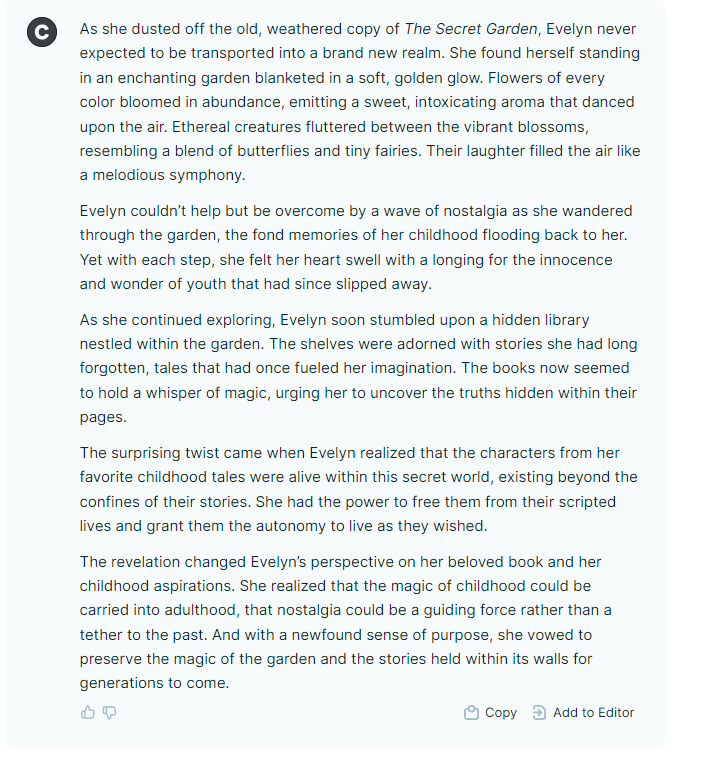
While the story was quite pleasant to read, several noticeable AI traits appeared. For one, it used the main character’s name in every paragraph. Several words seem to be commonly used by ChatGPT, such as “nostalgia,” “abundance,” and “vibrant.” Combined with the repetitiveness, it seemed rather obvious that AI was used.
The pro version of Copy.ai uses ChatGPT-4, so it may produce better results. It’s unclear whether the app will incorporate new versions of the LLM, as OpenAI’s CEO Sam Altman revealed that ChatGPT-5 is on its way.
Copy.ai is also compatible with a variety of other AI models including Azure and Anthropic , which makes it more flexible for delivering results. Another piece of good news is that the company has a zero-retention data policy.
Like OpenAI, Copy.ai has a free version with limited words, while the Pro version starts from $36 per month for five users, and has unlimited capacity.
Anyword is a little bit more complicated to use as it doesn’t bring the user directly to the writing app. It offers a variety of writing options, including 1,000-word SEO-friendly blog articles, social media posts, and ad campaigns. If you just need a simple text prompt box, you can find it under “general prompt” on the dashboard.
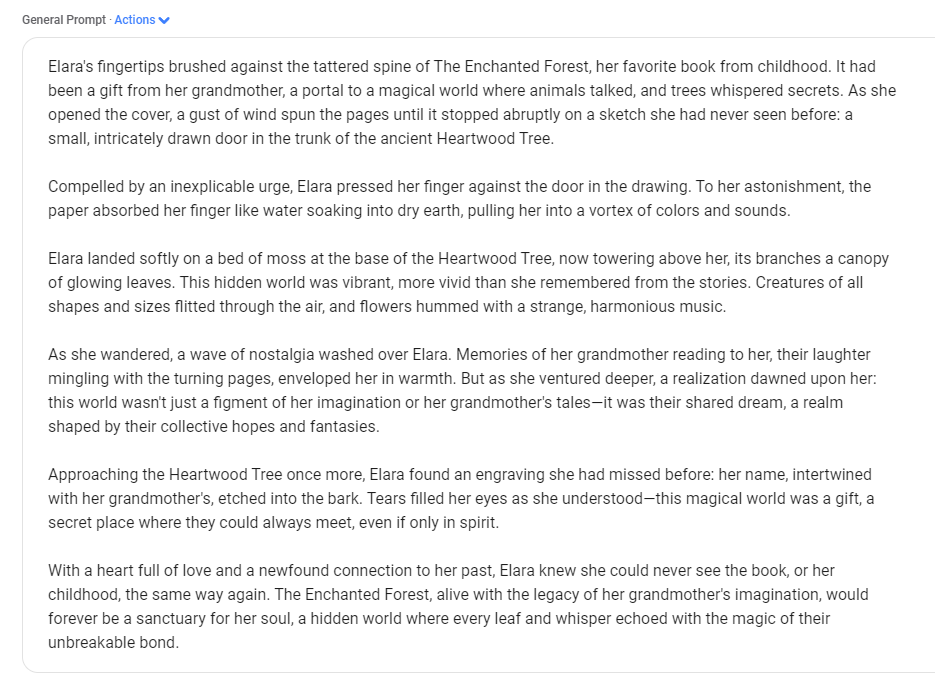
However, it allows you to change the tone of voice from neutral to rebellious, or even to a multi-tonal style incorporating three dimensions. There is also the capability to target specific audiences, whether they are nostalgic readers or creative writers. When kept neutral with a broad audience, it produced a similar copy, characterized by the repetition of names and overly flowery language. Nevertheless, the story was creative but seemed to heavily favor the fantasy genre.
Using other filters, it generated a tale almost identical to the first, including the same phrases such as “The Enchanted Forest,” “newfound,” “intertwining,” and “grandmother.” It’s quite apparent that it has a defined notion of what constitutes a childhood book.
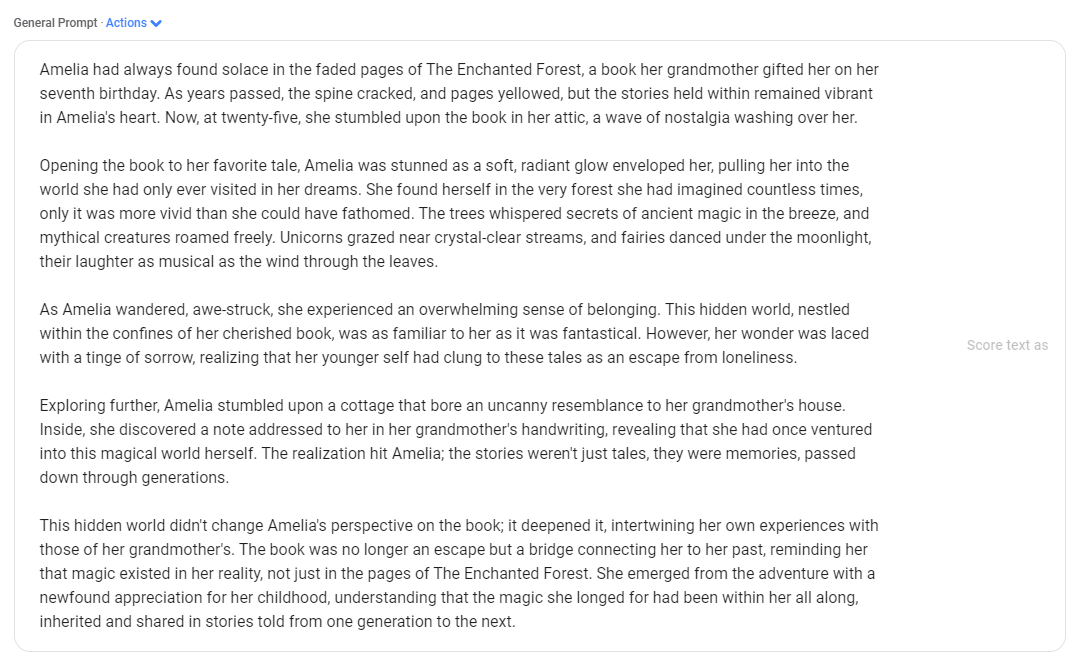
The Starter plan with one seat costs $39 per month paid annually. The Data-Driven plan costs $79/month, and the Business plan is $349 per month.
Writesonic is another free AI writing tool, with an interface comparable to ChatGPT as it has a dark left-hand side panel. Like Copy.ai, the unpaid version is powered by ChatGPT-3.5 among others, but has better billing options than OpenAI. The company states that it is “agnostic” about using a variety of LLMs.
“Our proprietary AI Model Gateway, called GPT Router dynamically routes between multiple AI models, thus speeding up responses and ensuring the best quality output as well as non-stop reliability,” it says on its website. These include Meta’s LLama and Google’s Gemini models.
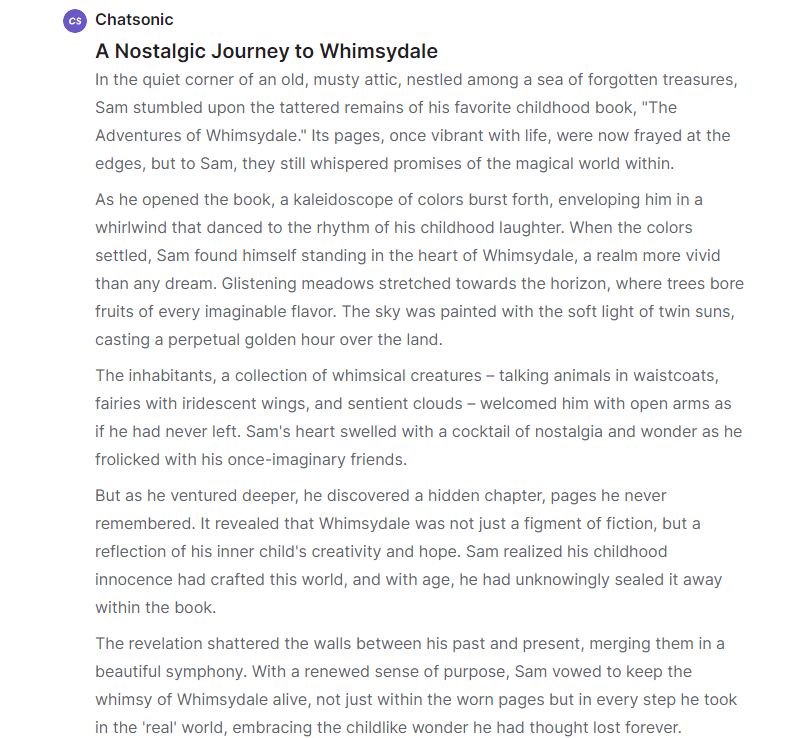
The AI article writer can create long-form content pieces and includes a chatbot assistant named Chatsonic. When tested with a text prompt, it produced a slightly more imaginative story, making it more reliable than other tools.
Although there is a free version, Chatsonic costs $12 per month when paid annually and claims to offer output quality comparable to GPT-4 and Claude 3 Opus . The individual plan costs $16 and includes additional features such as an SEO optimizer, plagiarism checker, and a tool for facts and citations.
Rytr , with a name that phonetically resembles “writer,” adopts a no-nonsense approach by featuring a straightforward interface like that of a writing pad. That being said, it still allows users to select the tone and use case of the output. Using the “story plot” function, it produced a tale almost identical to one by Anyword.
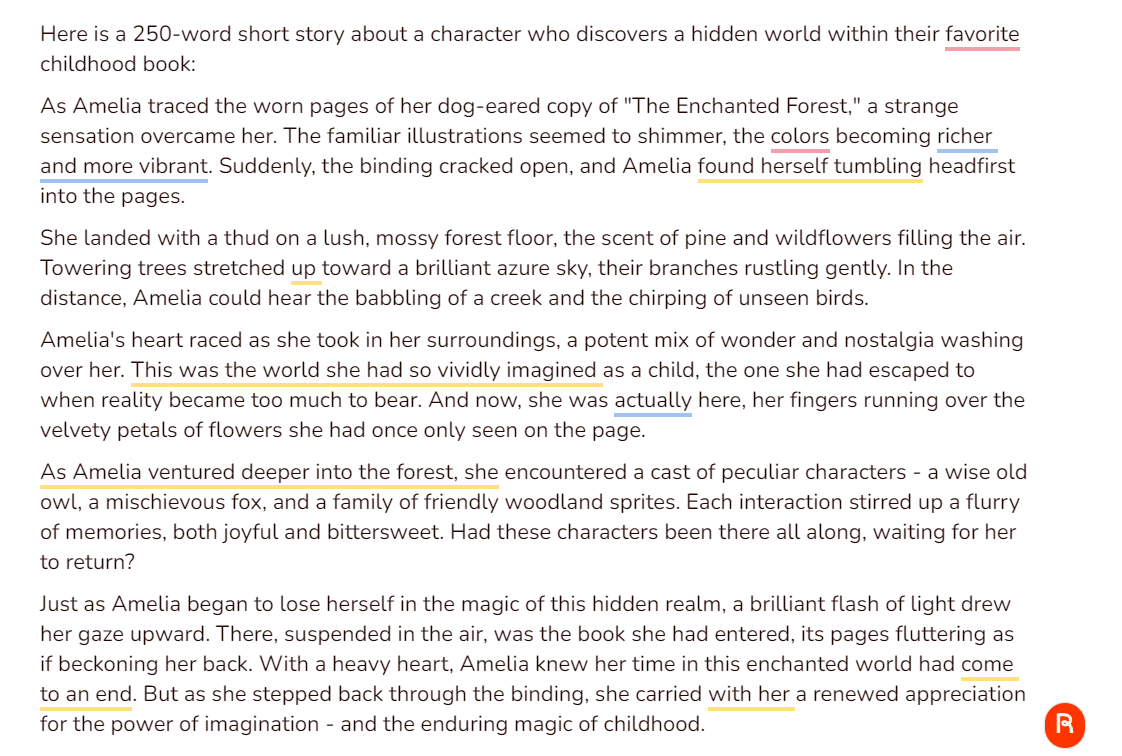
Not only did “Amelia” have a copy of “The Enchanted Forest,” but she also showed a penchant for streams and creeks. Hence, it is obvious that Rytr also uses ChatGPT-3 for its content writing.
Rytr is free to use, with unlimited queries available for $7.50 per month. In comparison, ChatGPT-4 costs $20 per month currently. The difference is that Rytr offers other features such as a plagiarism checker and SEO toolkit.
Featured image: Canva
About ReadWrite’s Editorial Process
The ReadWrite Editorial policy involves closely monitoring the tech industry for major developments, new product launches, AI breakthroughs, video game releases and other newsworthy events. Editors assign relevant stories to staff writers or freelance contributors with expertise in each particular topic area. Before publication, articles go through a rigorous round of editing for accuracy, clarity, and to ensure adherence to ReadWrite's style guidelines.
Suswati Basu Tech journalist
Suswati Basu is a multilingual, award-winning editor and the founder of the intersectional literature channel, How To Be Books. She was shortlisted for the Guardian Mary Stott Prize and longlisted for the Guardian International Development Journalism Award. With 18 years of experience in the media industry, Suswati has held significant roles such as head of audience and deputy editor for NationalWorld news, digital editor for Channel 4 News and ITV News. She has also contributed to the Guardian and received training at the BBC As an audience, trends, and SEO specialist, she has participated in panel events alongside Google. Her…
Related News

Dutch researchers launch — oh, really? — an AI sarcasm detector

IMF chief warns of AI “tsunami” facing six in 10 jobs

What is Character.AI? How to create your own chatbots and use the old version

Two US states seize the initiative to regulate AI

Google to roll out AI-powered theft detection on Android phones
Most popular tech stories.
- US inches closer to a TikTok ban
- Judas – Release date, trailers, platforms, and everything we know
- Minecraft player has X-Files moment as they report an in-game UFO sighting
- EA revealed how much Apex Legends has made and…it’s a lot
- Dogecoin Maxi DonAlt Posts $1 Price Prediction – Risk On For Meme Coins?
Latest News

College football is back with a glorious gameplay trailer from EA Sports
EA Sports released its first gameplay trailer for College Football 25 — the rebirth of the much beloved NCAA Football series — and I gotta say, it is rad. The...

iPhone users upset when new iOS resurfaces old pics they thought they deleted

Reddit signs deal with OpenAI to open up the platform to ChatGPT

MultiVersus relaunch will include PvE mode so players can hone their skills

Popular Topics
Get the biggest tech headlines of the day delivered to your inbox.
By signing up, you agree to our Terms and Privacy Policy. Unsubscribe anytime.
Explore the latest in tech with our Tech News. We cut through the noise for concise, relevant updates, keeping you informed about the rapidly evolving tech landscape with curated content that separates signal from noise.
Explore tech impact in In-Depth Stories. Narrative data journalism offers comprehensive analyses, revealing stories behind data. Understand industry trends for a deeper perspective on tech's intricate relationships with society.
Empower decisions with Expert Reviews, merging industry expertise and insightful analysis. Delve into tech intricacies, get the best deals, and stay ahead with our trustworthy guide to navigating the ever-changing tech market.
Thank you for visiting nature.com. You are using a browser version with limited support for CSS. To obtain the best experience, we recommend you use a more up to date browser (or turn off compatibility mode in Internet Explorer). In the meantime, to ensure continued support, we are displaying the site without styles and JavaScript.
- View all journals
- Explore content
- About the journal
- Publish with us
- Sign up for alerts
- Published: 08 May 2024
Accurate structure prediction of biomolecular interactions with AlphaFold 3
- Josh Abramson ORCID: orcid.org/0009-0000-3496-6952 1 na1 ,
- Jonas Adler ORCID: orcid.org/0000-0001-9928-3407 1 na1 ,
- Jack Dunger 1 na1 ,
- Richard Evans ORCID: orcid.org/0000-0003-4675-8469 1 na1 ,
- Tim Green ORCID: orcid.org/0000-0002-3227-1505 1 na1 ,
- Alexander Pritzel ORCID: orcid.org/0000-0002-4233-9040 1 na1 ,
- Olaf Ronneberger ORCID: orcid.org/0000-0002-4266-1515 1 na1 ,
- Lindsay Willmore ORCID: orcid.org/0000-0003-4314-0778 1 na1 ,
- Andrew J. Ballard ORCID: orcid.org/0000-0003-4956-5304 1 ,
- Joshua Bambrick ORCID: orcid.org/0009-0003-3908-0722 2 ,
- Sebastian W. Bodenstein 1 ,
- David A. Evans 1 ,
- Chia-Chun Hung ORCID: orcid.org/0000-0002-5264-9165 2 ,
- Michael O’Neill 1 ,
- David Reiman ORCID: orcid.org/0000-0002-1605-7197 1 ,
- Kathryn Tunyasuvunakool ORCID: orcid.org/0000-0002-8594-1074 1 ,
- Zachary Wu ORCID: orcid.org/0000-0003-2429-9812 1 ,
- Akvilė Žemgulytė 1 ,
- Eirini Arvaniti 3 ,
- Charles Beattie ORCID: orcid.org/0000-0003-1840-054X 3 ,
- Ottavia Bertolli ORCID: orcid.org/0000-0001-8578-3216 3 ,
- Alex Bridgland 3 ,
- Alexey Cherepanov ORCID: orcid.org/0000-0002-5227-0622 4 ,
- Miles Congreve 4 ,
- Alexander I. Cowen-Rivers 3 ,
- Andrew Cowie ORCID: orcid.org/0000-0002-4491-1434 3 ,
- Michael Figurnov ORCID: orcid.org/0000-0003-1386-8741 3 ,
- Fabian B. Fuchs 3 ,
- Hannah Gladman 3 ,
- Rishub Jain 3 ,
- Yousuf A. Khan ORCID: orcid.org/0000-0003-0201-2796 3 ,
- Caroline M. R. Low 4 ,
- Kuba Perlin 3 ,
- Anna Potapenko 3 ,
- Pascal Savy 4 ,
- Sukhdeep Singh 3 ,
- Adrian Stecula ORCID: orcid.org/0000-0001-6914-6743 4 ,
- Ashok Thillaisundaram 3 ,
- Catherine Tong ORCID: orcid.org/0000-0001-7570-4801 4 ,
- Sergei Yakneen ORCID: orcid.org/0000-0001-7827-9839 4 ,
- Ellen D. Zhong ORCID: orcid.org/0000-0001-6345-1907 3 ,
- Michal Zielinski 3 ,
- Augustin Žídek ORCID: orcid.org/0000-0002-0748-9684 3 ,
- Victor Bapst 1 na2 ,
- Pushmeet Kohli ORCID: orcid.org/0000-0002-7466-7997 1 na2 ,
- Max Jaderberg ORCID: orcid.org/0000-0002-9033-2695 2 na2 ,
- Demis Hassabis ORCID: orcid.org/0000-0003-2812-9917 1 , 2 na2 &
- John M. Jumper ORCID: orcid.org/0000-0001-6169-6580 1 na2
Nature ( 2024 ) Cite this article
230k Accesses
1 Citations
1186 Altmetric
Metrics details
We are providing an unedited version of this manuscript to give early access to its findings. Before final publication, the manuscript will undergo further editing. Please note there may be errors present which affect the content, and all legal disclaimers apply.
- Drug discovery
- Machine learning
- Protein structure predictions
- Structural biology
The introduction of AlphaFold 2 1 has spurred a revolution in modelling the structure of proteins and their interactions, enabling a huge range of applications in protein modelling and design 2–6 . In this paper, we describe our AlphaFold 3 model with a substantially updated diffusion-based architecture, which is capable of joint structure prediction of complexes including proteins, nucleic acids, small molecules, ions, and modified residues. The new AlphaFold model demonstrates significantly improved accuracy over many previous specialised tools: far greater accuracy on protein-ligand interactions than state of the art docking tools, much higher accuracy on protein-nucleic acid interactions than nucleic-acid-specific predictors, and significantly higher antibody-antigen prediction accuracy than AlphaFold-Multimer v2.3 7,8 . Together these results show that high accuracy modelling across biomolecular space is possible within a single unified deep learning framework.
You have full access to this article via your institution.
Similar content being viewed by others

Highly accurate protein structure prediction with AlphaFold

De novo generation of multi-target compounds using deep generative chemistry

Augmenting large language models with chemistry tools
Author information.
These authors contributed equally: Josh Abramson, Jonas Adler, Jack Dunger, Richard Evans, Tim Green, Alexander Pritzel, Olaf Ronneberger, Lindsay Willmore
These authors jointly supervised this work: Victor Bapst, Pushmeet Kohli, Max Jaderberg, Demis Hassabis, John M. Jumper
Authors and Affiliations
Core Contributor, Google DeepMind, London, UK
Josh Abramson, Jonas Adler, Jack Dunger, Richard Evans, Tim Green, Alexander Pritzel, Olaf Ronneberger, Lindsay Willmore, Andrew J. Ballard, Sebastian W. Bodenstein, David A. Evans, Michael O’Neill, David Reiman, Kathryn Tunyasuvunakool, Zachary Wu, Akvilė Žemgulytė, Victor Bapst, Pushmeet Kohli, Demis Hassabis & John M. Jumper
Core Contributor, Isomorphic Labs, London, UK
Joshua Bambrick, Chia-Chun Hung, Max Jaderberg & Demis Hassabis
Google DeepMind, London, UK
Eirini Arvaniti, Charles Beattie, Ottavia Bertolli, Alex Bridgland, Alexander I. Cowen-Rivers, Andrew Cowie, Michael Figurnov, Fabian B. Fuchs, Hannah Gladman, Rishub Jain, Yousuf A. Khan, Kuba Perlin, Anna Potapenko, Sukhdeep Singh, Ashok Thillaisundaram, Ellen D. Zhong, Michal Zielinski & Augustin Žídek
Isomorphic Labs, London, UK
Alexey Cherepanov, Miles Congreve, Caroline M. R. Low, Pascal Savy, Adrian Stecula, Catherine Tong & Sergei Yakneen
You can also search for this author in PubMed Google Scholar
Corresponding authors
Correspondence to Max Jaderberg , Demis Hassabis or John M. Jumper .
Supplementary information
Supplementary information.
This Supplementary Information file contains the following 9 sections: (1) Notation; (2) Data pipeline; (3) Model architecture; (4) Auxiliary heads; (5) Training and inference; (6) Evaluation; (7) Differences to AlphaFold2 and AlphaFold-Multimer; (8) Supplemental Results; and (9) Appendix: CCD Code and PDB ID tables.
Reporting Summary
Rights and permissions.
Reprints and permissions
About this article
Cite this article.
Abramson, J., Adler, J., Dunger, J. et al. Accurate structure prediction of biomolecular interactions with AlphaFold 3. Nature (2024). https://doi.org/10.1038/s41586-024-07487-w
Download citation
Received : 19 December 2023
Accepted : 29 April 2024
Published : 08 May 2024
DOI : https://doi.org/10.1038/s41586-024-07487-w
Share this article
Anyone you share the following link with will be able to read this content:
Sorry, a shareable link is not currently available for this article.
Provided by the Springer Nature SharedIt content-sharing initiative
This article is cited by
Major alphafold upgrade offers boost for drug discovery.
- Ewen Callaway
Nature (2024)
By submitting a comment you agree to abide by our Terms and Community Guidelines . If you find something abusive or that does not comply with our terms or guidelines please flag it as inappropriate.
Quick links
- Explore articles by subject
- Guide to authors
- Editorial policies
Sign up for the Nature Briefing: Translational Research newsletter — top stories in biotechnology, drug discovery and pharma.

COMMENTS
Authorea - Best for Alternative Publication and Exposure. Authorea is this writing tool is a one-stop-shop for you to a) create/upload, b) disseminate your research paper, and c) get published in top journals. Authorea is great for young researchers who want to publish their academic work.
Research methods relate to how researchers gather information and data. For example, surveys, focus groups, customer interviews, and A/B testing are research methods that gather information. On the other hand, tools assist areas of research. Researchers may use tools to more efficiently gather data, store data securely, or uncover insights.
1. SciSpace Literature Review. SciSpace's Literature Review tool is designed for researchers to conduct systematic literature reviews efficiently. This AI research tool helps you compare and contrast scientific papers, and extract key information, themes, patterns, and concepts of numerous research papers in minutes, all in one single workspace.
That's it: 19 academic writing apps and scientific research tools to support your writing for free! However, the best academic writing software won't make you more productive if you don't rely on a streamlined writing process and if you aren't using your writing sessions effectively. If you want to get your hands on a template to write ...
1. Trinka. Best Overall for Academic Writing ($6.67/month) Trinka is a unique AI-powered writing tool designed specifically for academic and technical writing. What sets Trinka apart is its ability to go beyond basic grammar and spelling corrections.
These tools will streamline your research process, help you stay organized, and provide you with easy access to the information you need. ... The range of things academic writing tools can do for you is astonishing - language editing, abstract writing, plagiarism checking and so much more! While there are a number of online tools for ...
research assistant. Zotero is a free, easy-to-use tool to help you collect, organize, annotate, cite, and share research. Download. Available for Mac, Windows, Linux, and iOS. Just need to create a quick bibliography? Try ZoteroBib.
Writing a research paper requires you to demonstrate a strong knowledge of your topic, engage with a variety of sources, and make an original contribution to the debate. ... Tip AI tools like ChatGPT can be effectively used to brainstorm potential thesis statements and develop research paper outlines. However, trying to pass off AI-generated ...
Andy Tay. Credit: gmast3r/Getty Images. Writing tools powered by artificial intelligence (AI) have the potential to reduce manuscript preparation time to a few days, or hours. Deep-learning ...
Delivered to your inbox every two weeks, the Writing Toolbox features practical advice and tools you can use to prepare a research manuscript for submission success and build your scientific writing skillset. Discover how to navigate the peer review and publishing process, beyond writing your article.
In this post, we have pulled together 8 tools and resources that will help you work better and smarter when writing a research paper. Our downloadable comprehensive free guide: Writing your paper. Todoist: A to-do list to organize your work. Evernote: As a research notebook. Grammarly: Cloud based typing assistant.
Write with confidence, powered by AI beta. Get perfect spelling, grammar, and punctuation. Sound fluent, professional, and natural. Fine-tune your writing with word and sentence alternatives. Choose a writing style and tone that fits your audience.
5. Milanote. Cost: Free for basic plan or $12.50/month for premium. Milanote is an easy-to-use creative writing app to organize your research, ideas, characters and outline in one place. The vast majority of novelist-oriented writing software is organized around the idea of a linear document.
Our Commitment: Academic Honesty. Jenni AI is committed to upholding academic integrity. Our tool is designed to assist, not replace, your effort in research and writing. We strongly discourage any unethical use. We're dedicated to helping you excel in a responsible and ethical manner.
You can use such tools in a responsible way that benefits your education during the research and writing process by relying on them for the following: Brainstorming and explore topics in an interactive way. Assisting with programming and coding. Developing research questions and paper outlines.
6. Scrivener. Scrivener is another great tool for research writing and keeping your notes organized. Used by researchers, screenwriters, novelists, non-fiction writers, students, journalists, academics, lawyers, translators, and more, Scrivener is a tool made for long writing projects.
4. Grammar Checkers and Sentence Correction Tools. 1. Writing Tools and Software. Whether you are writing an article, research paper, essay, blog, and dissertation or PhD thesis, it is important to choose an appropriate writing software tool for your work. The choice of writing software comes down to your personal taste.
Welcome to the transformative world of AI-powered research tools! This blog post will dive deeper into these tools, providing a detailed review of how AI is revolutionizing academic research. ... AI tools for grant writing. In the challenging realm of science grant writing, two innovative AI tools are making waves: Granted AI and Grantable.
Paperpal is the perfect AI academic writing tool for researchers that enhances and speeds up the academic writing process. Create Publish-ready papers with AI for research paper writing solutions. Get instant grammar check and subject-specific suggestions to make your research paper submission ready. Paperpal is trusted by top global publishers and authors across 125 countries.
While a considerable number of tools support argumentative essay writing in English, other academic writing genres (e.g., research articles) and other languages are under-represented.
Research and Writing Tools. If you need help with research for a writing assignment or project, these research and writing tools can be helpful as a part of the research process. The free tools below are used to research credible, scholarly sources, brainstorm, build citations, check for grammar errors, and avoid unintentional plagiarism.
4. Elicit.org. Elicit.org is an AI-powered tool designed to streamline the research process by assisting in conducting comprehensive literature reviews and extracting relevant data from various sources. It is one of the top AI writing tools for academic research that has been embraced by researchers worldwide.
Mind mapping tools. Mind mapping and brainstorming are very useful during the conceptualization stage of research writing. It helps with organizing, outlining and planning of writing. Some popular ones used by researchers are: MindMeister, MindMup, bubbl.us and Coggle. Mindmeister advises "If you've been staring at a blank page for ages ...
An annotated bibliography is a summary and evaluation of a resource. According to Merriam-Webster, a bibliography is "the works or a list of the works referred to in a text or consulted by the author in its production.". Your references (APA) or Works Cited (MLA) can be considered a bibliography. A bibliography follows a documentation style ...
You can adjust this outline to fit your research findings better and ensure that your paper remains well-organized and focused. 5. Write a Rough Draft. Once your outline is in place, you can begin the writing process. Remember, when you write a rough draft, it isn't meant to be perfect.
Writesonic is another free AI writing tool, with an interface comparable to ChatGPT as it has a dark left-hand side panel. Like Copy.ai, the unpaid version is powered by ChatGPT-3.5 among others ...
The introduction of AlphaFold 21 has spurred a revolution in modelling the structure of proteins and their interactions, enabling a huge range of applications in protein modelling and design2-6 ...